new posts in all blogs
Viewing: Blog Posts Tagged with: how to, Most Recent at Top [Help]
Results 76 - 100 of 347
How to use this Page
You are viewing the most recent posts tagged with the words: how to in the JacketFlap blog reader. What is a tag? Think of a tag as a keyword or category label. Tags can both help you find posts on JacketFlap.com as well as provide an easy way for you to "remember" and classify posts for later recall. Try adding a tag yourself by clicking "Add a tag" below a post's header. Scroll down through the list of Recent Posts in the left column and click on a post title that sounds interesting. You can view all posts from a specific blog by clicking the Blog name in the right column, or you can click a 'More Posts from this Blog' link in any individual post.

By: Kathy Temean,
on 3/18/2014
Blog:
Writing and Illustrating
(
Login to Add to MyJacketFlap)
JacketFlap tags:
Process,
How to,
Doris Ettlinger,
Rhode Island School of Design,
demystify,
Synopsis Format,
Synopsis Guide,
Tips,
list,
reference,
Add a tag
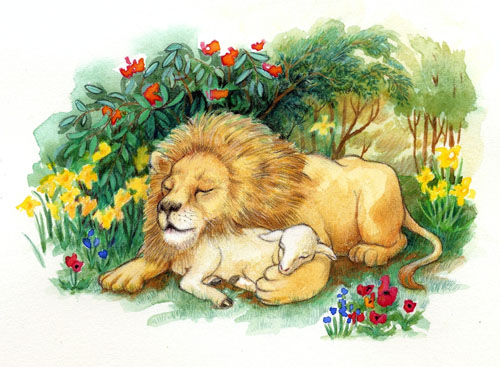
Doris Ettlinger sent in this gorgeous illustration reminding us of how March comes in as a lion and goes out like a lamb. Doris graduated from the Rhode Island School of Design and received an MFA from the University of Wisconsin – Madison. She was featured on Illustrator Saturday in 2010: http://kathytemean.wordpress.com/2010/07/17/illustrator-saturday-doris-ettlinger/
After talking about formatting your manuscripts, it was logical to receive a few emails asking about how to format a synopsis. That lead to adding other things you need to consider when writing one for your novel.
How to format your synopsis.
Use a one inch margins on the top, bottom and sides. Justify text at the left margin only. Use Times New Roman 12 pt. font. Type your name, address, phone number, fax number and e-mail address, each on a separate line single-spaced at the top left margin on the first page of your synopsis.
If you can fit your synopsis on one page, then you can single space the text with a space between paragraphs . If it goes over one page, then double space your text. Editors generally want one or two pages, but if you must go longer than you must – just keep it tight. You should always check a publisher’s submission guidelines, just to make sure you are following their rules before submitting.
Here are some things to help guide you through the synopsis writing process:
• You want to briefly tell what happens. This is one place you can ignore Show, Don’t Tell.
• Your goal should be to give an escalating series of turning points, a strong central crisis, a dramatic climax and a satisfying resolution.
• Introduce your main character first. Type a character’s name in all CAPS the first time you use it in the synopsis. Why? It helps the editor remember or find your character names.
• Remember your synopsis should showcase your unique voice.
• The synopsis should reflect your story. If it is humorous, be funny, etc.
• Start with a hook.
• Use present tense. This gives the story immediacy.
• Write the high points of your story in chronological order. Keep these paragraphs tight.
• Always answer basic who, what, where, when, why–early in the synopsis.
• Don’t waste words or time describing settings, unless crucial. Sometimes it’s enough just to put the date and place at the top, then start your synopsis.
• Omit unimportant details.
• Only include backstory if it is necessary to give the editor the information they need about the character’s motives.
• Always resolve the external plot question before you resolve the internal and/or relationship question.
• If it’s not a turning point, it doesn’t belong in the synopsis.
• Don’t use secondary characters in your synopsis, unless they are absolutely critical to the emotional turning points of the relationship. Even then, try to get by with the using the secondary’s relationship to the major characters (sister, teacher, boss.) They are too hard to keep up with and only add clutter. Only name them when necessary.
• Clearly convey the central question of the story, and what the resolution looks like. And resolve it at the end — don’t leave the editor guessing. They hate that, so spell out the story, including the ending.
• Rewrite your synopsis until each sentence is polished to the point of perfection. Use strong adjectives and verbs. Make every word count.
Check back tomorrow for a synopsis checklist you can use when drafting one for your manuscript.
Talk tomorrow,
Kathy
Filed under:
demystify,
How to,
list,
Process,
reference,
Tips Tagged:
Doris Ettlinger,
Rhode Island School of Design,
Synopsis Format,
Synopsis Guide 

.png.jpg?picon=4257)
By: Diana Hurwitz,
on 3/14/2014
Blog:
Game On! Creating Character Conflict
(
Login to Add to MyJacketFlap)
JacketFlap tags:
action,
emotion,
movement,
how to,
physical,
reaction,
mental,
triggers,
emotional repsonse,
scene progression,
fiction,
writing,
character,
recovery,
plotting,
behavior,
Add a tag
When a stimulus signals the brain, the body goes through a logical sequence. Make sure you relate the beats in a logical order.
1. A stimulus triggers the senses. The brain receives the stimulus instantaneously. It can be something your character hears, intuits, sees, smells, tastes, or touches.
2. The body has an involuntary response that takes a nanosecond. The limbic system evaluates the stimulus and sends chemicals racing through the body as neurons fire, depending on its evaluation of whether the stimulus is negative, positive, or neutral. The brain decides if there is a potential threat or reward.
3. The response triggers a reflexive action.
4. The brain then regains control over the body and makes a conscious decision about how to proceed.
A posited theory is that everyone we meet (and everything we come across) leaves a neural imprint. The brain decides if a person, place, or thing is a friend or foe and whether the next encounter will be negative or positive. The composite images are stored in an easily accessed file folder for comparison. How much a person or thing resembles the positive or negative composites determines how likely you are to like or dislike a new person, place, or thing when you encounter it. It decides whether snakes are lovely or lethal, whether a physical action is comforting or threatening, and whether an action you take is likely to result in reward or punishment.
It compares faces and decides that your new boss looks a lot like the girl you liked in elementary school. Your initial reaction is positive. She may turn out to be perfectly awful.
The brain makes these split-second decisions every second of every day. It is important to understand this process as you write, but it's only necessary to zero in on this part of the response at the most critical turning points of your story.
Next, the body reacts involuntarily to the stimulus. It recoils or reaches out. It startles or is soothed. A character gasps, coughs, sneezes, laughs, or screams. This reaction is embedded deep within the animal part of the brain. It is governed by sheer instinct and raw emotion. It is the fight or flight response at play. His pulse, breathing, and muscles react. His skin erupts in chills. His mouth goes dry. The character is not speaking or moving yet. He flinches, blinks, tenses, and displays a micro-expression.
What happens next depends on how the brain filters the stimulus through the character's conditioning, personality, and emotional connection to the stimulus. It tests the emotion of the moment. The brain decides to override or reinforce the initial involuntary response. If the stimulus is a threat from a comforting person, it causes dissonance. The same is true if the loving gesture is issued from a threatening stimulus. Dick's impulse may be to hug someone. It is awkward when that someone pulls away from it.
Finally, the character's conscious mind takes over and is free to decide which course of action to take next. The body recovers from the initial reflex. It overcomes the muscle memory and moves with intention. Conscious control over his breathing, pulse, and muscles is restored. Dick moves deliberately forward or backward and speaks. He alters his breathing, flexes his trembling knees, or relaxes his tightened gut and jaw. He smiles and shakes hands or fake smiles and avoids shaking hands.
If Dick has been startled, shocked, or wounded, his body recovers. Writers often forget to mention this step of the process. His system returns to normal once the threat has passed. Make sure you show the recovery after a major impact.
Not every encounter needs to reveal every beat. Use more beats when the tension is high, less when the tension is low. Use extreme actions and reactions sparingly. The verbal camera should zoom in on the mechanics during critical parts and zoom out for the noncritical parts.
Next time we will discuss distance and touching. How close is too close?
Last month's SCBWI Bulletin cover, step by step, by Maral Sassouni

By: Kathy Temean,
on 3/9/2014
Blog:
Writing and Illustrating
(
Login to Add to MyJacketFlap)
JacketFlap tags:
authors and illustrators,
How to,
demystify,
The First Five Pages,
Formatting your manuscript,
Staying out of the Rejection Pile,
Writing Tips,
Book,
reference,
inspiration,
Advice,
Noah Lukeman,
rejection,
Add a tag
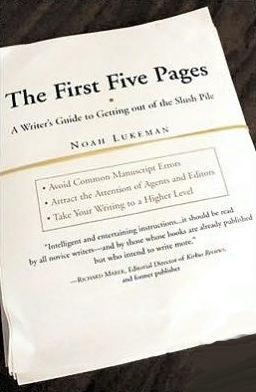 We’ve been talking a lot about how to format your manuscript, so I bought The First Five Pages: A Writers Guide To Staying Out of the Rejection Pile by Noah Lukeman to see what other things might be good to share and already he has reminded me of things I forgot to mention to you that you should do before submitting.
We’ve been talking a lot about how to format your manuscript, so I bought The First Five Pages: A Writers Guide To Staying Out of the Rejection Pile by Noah Lukeman to see what other things might be good to share and already he has reminded me of things I forgot to mention to you that you should do before submitting.
He says, “There are no rules to assure great writing, but there are ways to avoid bad writing.” He also points out that agents and editors don’t read manuscripts to enjoy them; they read solely with the goal of getting through the pile, solely with an eye to dismiss a manuscript.
So obviously, we want to do everything to look good and make our first contact a professional one. We want to make sure our manuscripts do not signal carelessness, sloppiness, ignorance, or defiance of the industry’s standards; that the writer doesn’t care enough to do the minimum amount of research to make a manuscript industry presentable. An editor or agent will assume that the careless presentation continues in the manuscript.
Avoid rejection in the first few minutes by making sure your manuscript is presented properly:
Paper: 8 1/2 x 11 inch standard 20 pound bond white computer paper.
Text: 12 pt. Times New Roman font. Printed only on one side of the page.
Clean: Do not send out a manuscript that you have sent out to other agents or editors if it appears the slightest bit worn.
Eliminate: Make sure you do not send out a manuscripts filled with boldface, underlined, capitalized, or italicized words everywhere, unless you purposely want to drive the agent or editor crazy.
Printing: Do not try to squeeze the last drops of ink from your printer and send out dim/hard to see and please if anyone still has a dot-matrix printer, throw it out and buy an ink-jet or laser printer.
Spacing: Double spaced lines with 1 inch margins. New paragraphs should be indented and also dialog should always be indented. Make sure you indent enough spaces (8-10 spaces on my computer). Nothing is worse than trying to read a manuscript when the indentations are so slight it is easy to miss them. Leave a half of a page between chapters. Line breaks between paragraphs scream amateur.
Do Not Include: Artwork or illustrations throughout the pages. It screams amateur. You might feel that adding some clip art helps the editor or agent get a feel for what you book is really about, but it is not professional. If you text needs a picture to explain what is going on, then add an illustrator’s note. Try to keep them to a minimum.
If you are an illustrator and have written and illustrated your book and have a book dummy; make sure you mention this in your query and give a website link where they can visit to see your art. You might want develop a page on your website exclusively to give to editors/agents, so they could view it online. Never send in original art.
Rights: When you present a manuscript to an agent or editor you are offering all rights. Do not put “Copyright” on your manuscript. It makes you look paranoid and besides it is not necessary.
Avoid Overuse of: Question marks, exclamation points, and parentheses. The abundant use of foreign words or phrases. Noah also say to avoid the inappropriate use of fancy words; crude of vulgar language or images; graphic blood and sex, but most of all cliché. Doing this in the first five pages can lead to instant rejection.
I think this covers all of the instant cosmetic rejections. Hope this helps.
Talk tomorrow,
Kathy
Filed under:
Advice,
authors and illustrators,
Book,
demystify,
How to,
inspiration,
reference,
rejection,
Writing Tips Tagged:
Formatting your manuscript,
Noah Lukeman,
Staying out of the Rejection Pile,
The First Five Pages 


By: Kathy Temean,
on 3/2/2014
Blog:
Writing and Illustrating
(
Login to Add to MyJacketFlap)
JacketFlap tags:
authors and illustrators,
How to,
Melissa Iwai,
New Idea,
demystify,
Nanci Turner-Steveson,
Agent Sean McCarthy,
Steve Meltzer,
Ask Kathy,
March Writer's Retreat,
Add a tag
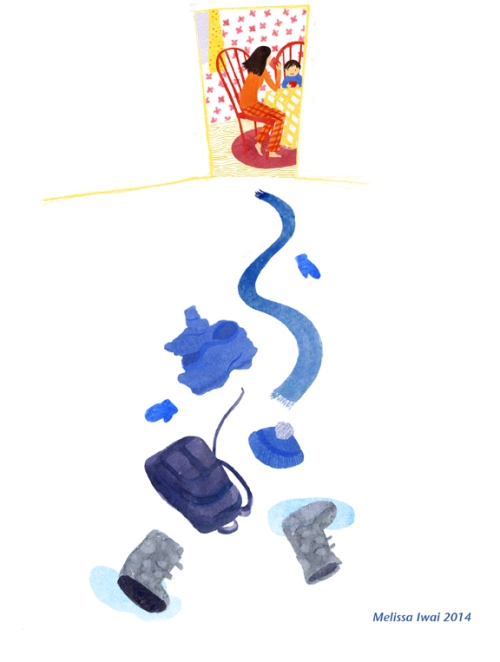
This fun illustration was sent in by Melissa Iwai. Melissa has illustrated over twenty picture books, and her first picture book that she wrote and illustrated was, Soup Day. She was featured on Illustrator Saturday on October 13, 2012. Click here to view.
In the past couple of weeks I have realized that there are always new writers and illustrators stopping by in hopes to learn more about the children’s book publishing industry. I have been blogging everyday for the last five years and so many subjects have been discussed, but many of you have not been following me for that many years. Example, I was afraid to blog about the formatting issue thinking that writers would think I wasn’t covering a important topic, but it turns out that many of you thanked me for clarifying the subject. I breathed a sigh of relief, because I don’t want to waste anyone’s time.
This lead me to wondering if you had more questions that you would like answered. If you do I would be willing to collect them, answer the ones I know and get editors and agents to weigh in on others. Why don’t we give it a test run? I am going to the March Writer’s Retreat that I put out there at the end of last year. Steve Meltzer, Associate Publisher/Executive Managing Editor of Dial Books for Young Readers, Dutton Children’s Books, Kathy Dawson Books, and Celebra Children’s Books and Agent Sean McCarthy from McCarthy Lit are the two faculty members for our small group. We will be spending the weekend with them, so I could get answers to anything you want to know.
If you have a burning question, please send it to Kathy.temean(at)gmail.com. You can ask more than one question and it can be about any aspect of the children’s publishing industry. You can be a completely new writer or illustrator, or an author or and illustrator who has published many books. Just make sure you put ASK KATHY in the subject area of the email, so I can search on that. I look forward to reading your questions and sharing the answers later the month.
Had to share the picture below with all you winter weary people out there. Nanci Turner Steveson move from New Jersey to her dream state – Wyoming. Maybe you will feel a little less weary after you see all the snow at her house.
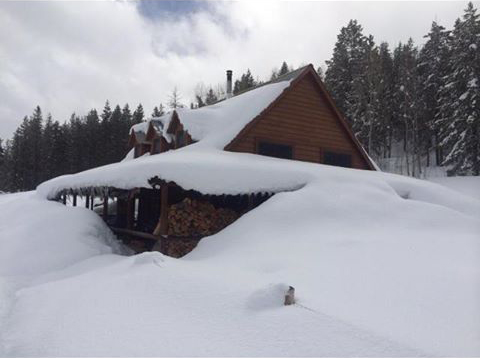
Now that is snow. It brings the words, “Cabin Fever” to my mine.
Talk tomorrow,
Kathy
Filed under:
authors and illustrators,
demystify,
How to Tagged:
Agent Sean McCarthy,
Ask Kathy,
March Writer's Retreat,
Melissa Iwai,
Nanci Turner-Steveson,
New Idea,
Steve Meltzer 

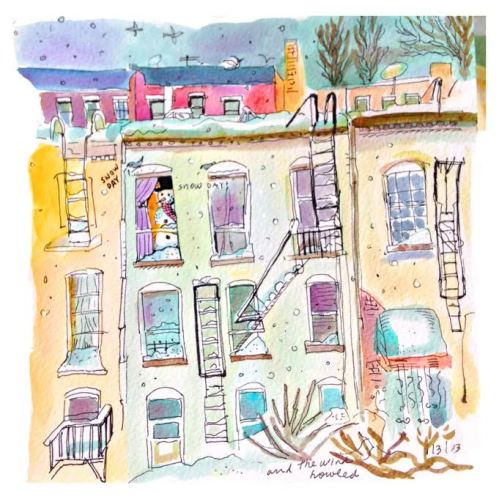
This fun winter illustration was sent in by Illustrator Tracey Berglund. Don’t miss the snowman in the window. It makes me think of the photo Leeza Hernandez sent me a few weeks ago. Her daughter and her built the smallest snowman I ever saw. They made it small, so they could save it in the freezer. Now that is thinking out-of-box. Tracey was my first featured illustrator on Illustrator Saturday back in June 2010. Here is the link: http://kathytemean.wordpress.com/2010/06/05/tracey-berglund-illustrator-saturday/ I think you can see how much Illustrator Saturday has grown since then.
February was a record month for first page submissions. I did not look at all the submissions to see the percentage of people who did not submit properly. We are close to getting the First Pages correct for the monthly critique, but there are still problems which caused a number of people to be pulled out for critique and then skipped, when I opened their Word document and it was not correct.
I think everyone now understands how to format their manuscript when submitting to an agent or editor, so lets just zero in on how to submit for the monthly critique for this blog. You would only format your page this way when you submit a first page to me. If you are doing a first page for an SCBWI event, then they would probably would want a similar forma, but make sure you check. Why the difference? Because if you use the standard format for a first page, you can not show enough for a good critique.
I know I asked you to cut and paste your text into the email, but I sent the word doc to the editor or agent, so if the Word doc isn’t formatted correctly, I can’t send it. I state a first page can have 23 lines, but that doesn’t mean that every manuscript’s text will work out to 23 lines. Some may only be able to fit 21 lines. The first page, just can not be more than 23 lines. Please do not send more than one page.
You don’t have room to put all your contact information on the page. Just your name, title, and genre at the very top. Then start your text on the next line. The example below from Carol Foote drops one line for her title. This is acceptable, but she could have gotten in the 23rd line if she had put everything across the top. The reason her page was not included in the drawing was due to her submitting it after the deadline.
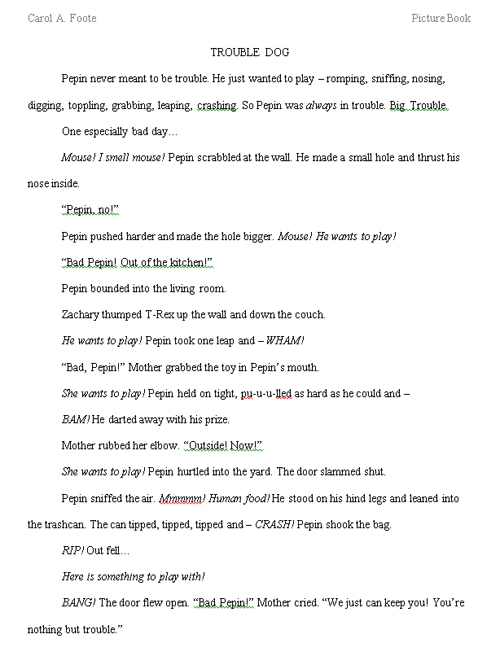
So as long as you follow the guidelines and the example above, send it in before the deadline, cut and paste the text into the email and attach a Word document of the text, put the required title in the Subject area (I search for the submissions using that title), send it to the email listed, and do not include more than one page, you will be good to go.
Hope this helps. If you submitted a first page and did not have it critiqued, please send it in for review in March. Check back tomorrow to read the four that were critiqued. Next week I will announce our Guest Critiquer for March. Deadline for March is March 21st. Title in the subject area March First Page Critique. Email to: Kathy(dot)temean(at)gmail(dot)com
Links for more formatting posts:
Novel: http://kathytemean.wordpress.com/2014/02/13/formatting-novel-manuscript-example/
Picture book: http://kathytemean.wordpress.com/2014/02/02/first-page-critiquer-for-february-formatting-mistakes-call-for-illustrations/
Standards: http://kathytemean.wordpress.com/2009/03/16/formatting-your-manuscript/
Talk tomorrow,
Kathy
Filed under:
authors and illustrators,
Contest,
demystify,
How to,
need to know Tagged:
First Page Critique,
Formatting problems,
Tracey Berglund 


By: Kathy Temean,
on 10/4/2013
Blog:
Writing and Illustrating
(
Login to Add to MyJacketFlap)
JacketFlap tags:
Interview,
picture books,
inspiration,
Process,
illustrating,
Highlights for Children,
authors and illustrators,
How to,
Illustrator's Saturday,
Spider Magazine,
Mark Meyers,
Take Me Out to the Ball Game,
Add a tag
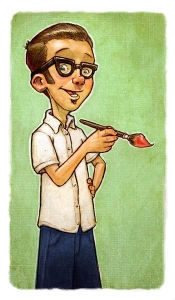 Mark was born and raised in Northern Utah under the shadow of the Wasatch Mountains. He spent many childhood days climbing, exploring, and causing general mayhem on the mountainside. Running around with his brothers he learned early on the finer things in life like the sound of breaking glass, the freedom of running around in your underwear, and the feel of rushing wind on your face as you’re falling out of a tree.
Mark was born and raised in Northern Utah under the shadow of the Wasatch Mountains. He spent many childhood days climbing, exploring, and causing general mayhem on the mountainside. Running around with his brothers he learned early on the finer things in life like the sound of breaking glass, the freedom of running around in your underwear, and the feel of rushing wind on your face as you’re falling out of a tree.
Mark has always loved to doodle whatever silly thing popped into his head. He never took too seriously but always liked to make people laugh with his drawings. By a strange series of events he found himself in foggy San Francisco studying illustration at the Academy of Art University, where he earned a Bachelor degree in Illustration. Now his days are spent drawing and painting pictures filled with kids, escaping circus monkeys, and everything in between.
Here is Mark talking about his process:
Generally I start out with thumbnails to get an idea how I’m going to break up the space.
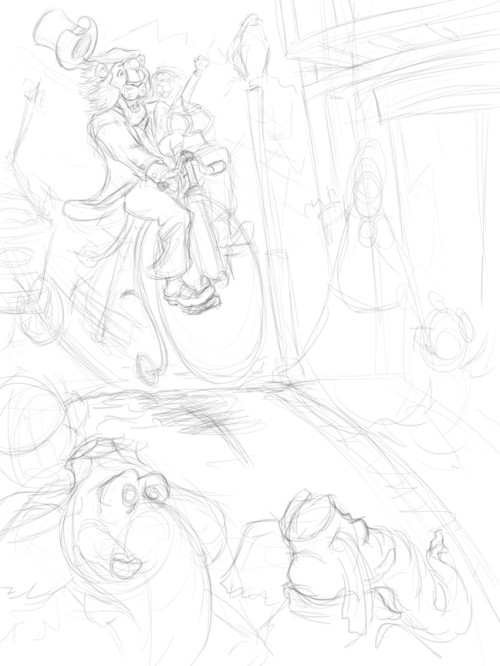
Once I get something I like I will blow it up and start working right over the top. I will do this either on paper or in Photoshop, for this one I did all the initial drawing in Photoshop (it was more of a matter of time frame than anything). I will then scan it in if it was done on paper, and then start to flesh things out and figure some of the detail. Once I am happy with that I will print it out very lightly and do a pencil drawing over it further working out the detail.
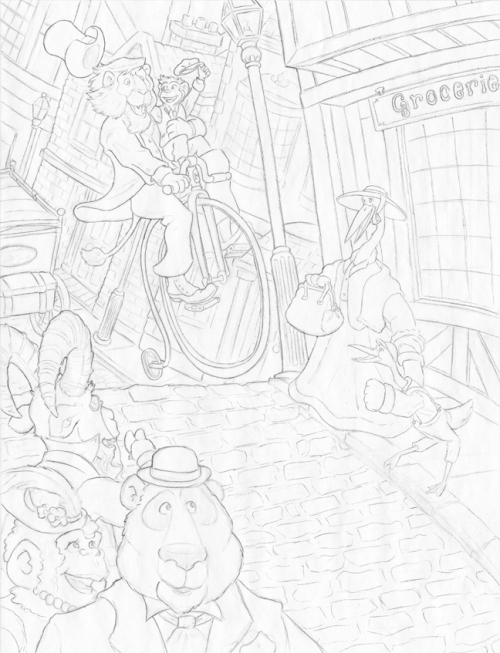
Once I am happy with the finished line drawing I will scan it back into Photoshop, and clean it up if it needs to be. Generally at this point I will also give the line work a little bit of color just so it’s not black.
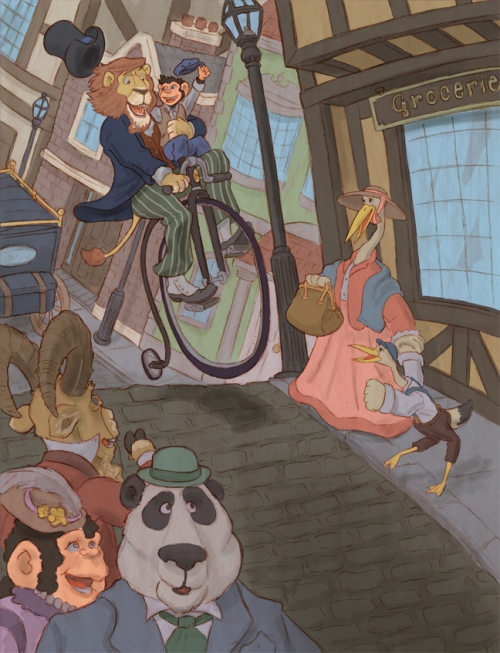
Once in photoshop I will do what I would call an underpainting. I will layout the basic color scheme and do some shadow lay in. This stage gives me a chance to set my basic value pattern and color scheme, but everything
will have a least a layer of acrylic over the top of it. Sometimes the colors will change quite a bit by the final if something isn’t working. Also this is a good stage to add a light overall layer of color. For example if this is going to be a cool image a semi transparent layer of blue would work good. On this painting it has a slightly warm tone over it. Basically at this point all of the space is filled even though somewhat rough.
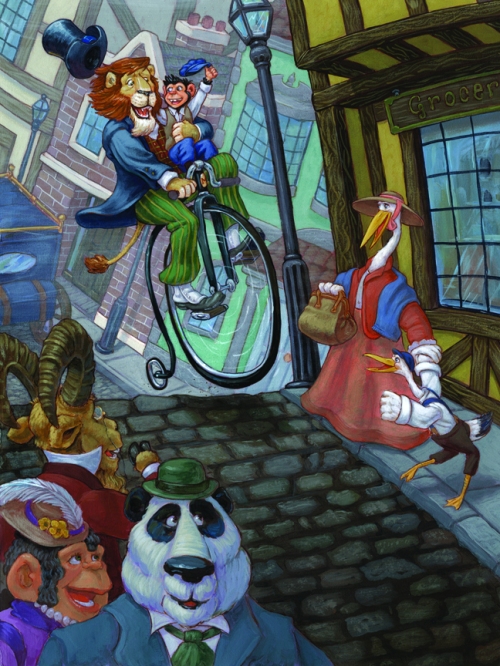
I print this out on epson watercolor paper. Then I spray it with a coat of Krylon workable fixative to help keep the ink on the paper. Next I get the paper wet and stretch it like you would any watercolor paper. I highly doubt that epson suggests this but with a little trial and error it works quite well. When wet you do have to be somewhat careful because the paper is a bit fragile. While it is still somewhat damp I coat the entire image in a layer of matte medium. This seals it all down and gives a nice tooth for painting. Then I let it dry completely. For the most part I paint with acrylic but will use watercolor, colored, pencil, and just about anything I think will work. When painting I generally work from furthest away to the front. That way you don’t have to worry about the
edges of stuff that has already been painted. I’ve also found doing the background first makes it easier to keep your values working. It also gives you a clear plan of attack of how to finish your painting. So working from back to front I go along adding details and finishing it off.
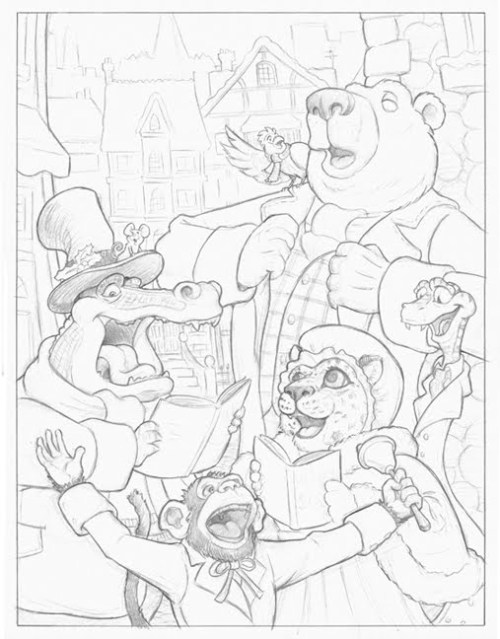
First, I sketch and once I’m happy I scan it into Photoshop. I adjust the color of the line to either a warm or cool color depending on the painting. I basically do a quick color study under the line drawing in Photoshop. I set the basic values and colors at this step. For this painting everything has kind of purple cast to keep that cool feeling. You could go a lot further at this point than I did, but I prefer to do most of the work in paint.
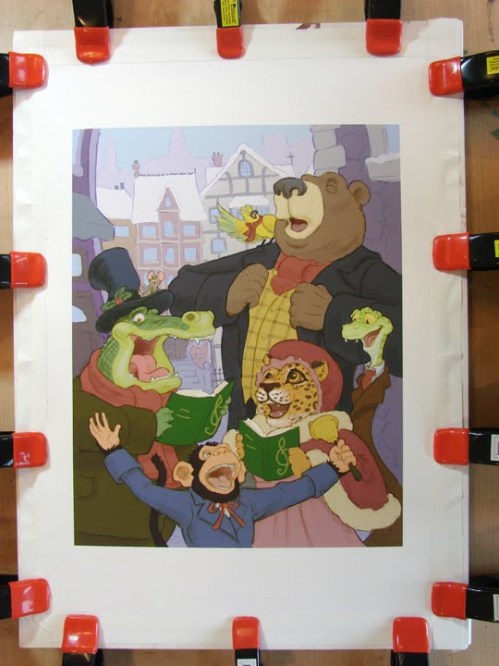
After I’m done in Photoshop I printed it out on some 13×19 Epson water color paper. I gave a few quick coats of workable fixatif. The ink in my printer is very waterproof or else you have to really coat it with workable fixatif. Then I stretch it like you would any other type of watercolor paper.
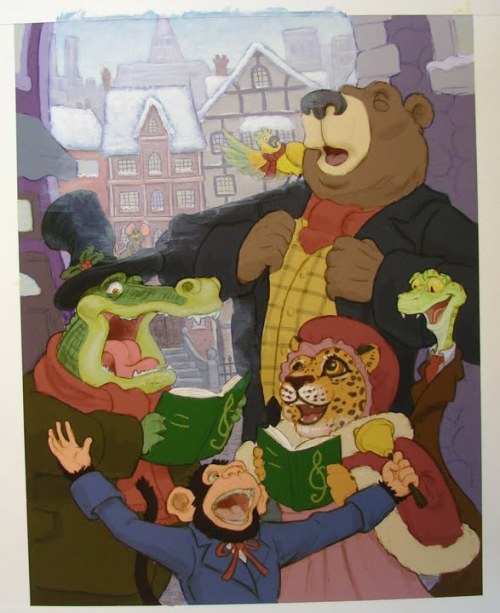
In the end pretty much all of the digital painting won’t be visible, but it helps to speed up the process, and gives you some direction. I use acrylics and usually start from the furthest point and work my way forward. For me it helps me keep control of values, and you don’t have to worry about painting around things as much. Also if I paint the funnest things first then I run out of motivation to paint everything else.
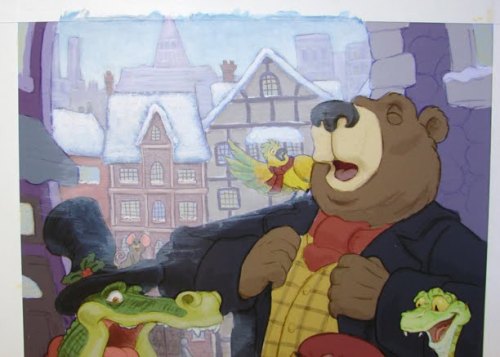
Here’s a detail where you can see that I’m not very concerned about over painting things in the foreground.
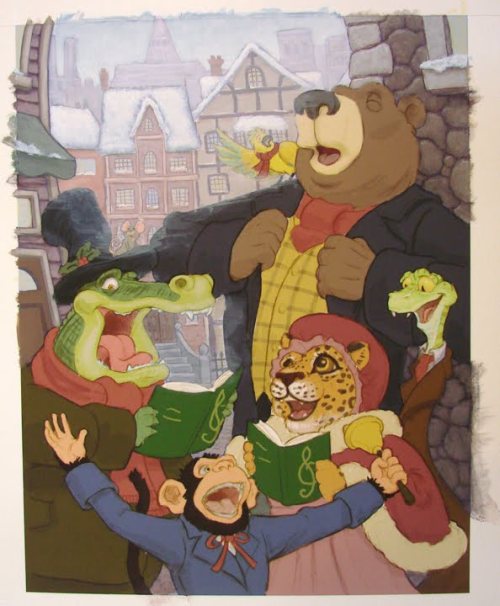
I keep moving forward. The buildings are a good example of how in paint I refine things but the digital color still peeks through here and there. Basically the same concept as toning a canvas.
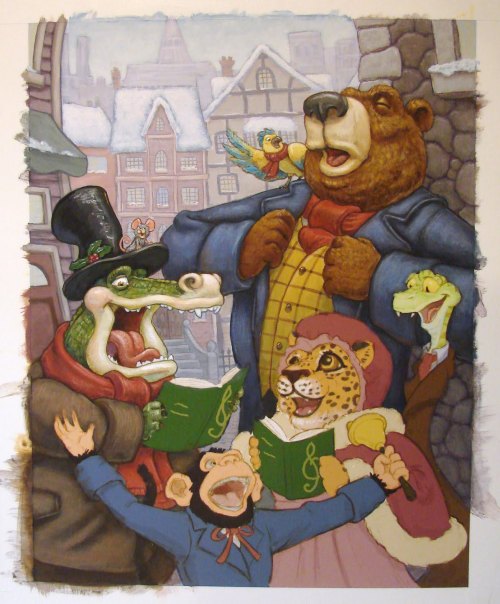
The values are off in this picture, but at this point I’m starting to refine the main characters.
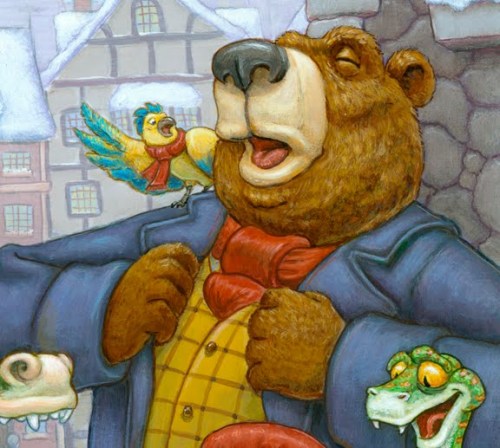
A few detailed shots
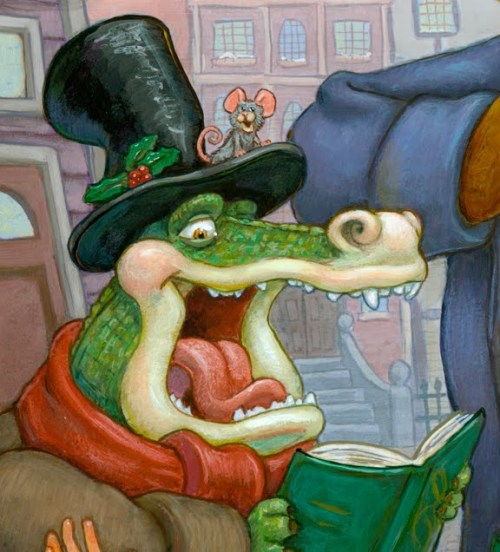
Once everything is painted I spend a little more time making all the small adjustments. I could do this forever and would more than likely eventually end up ruining the painting. So after a bit I usually stop myself and call it finished.
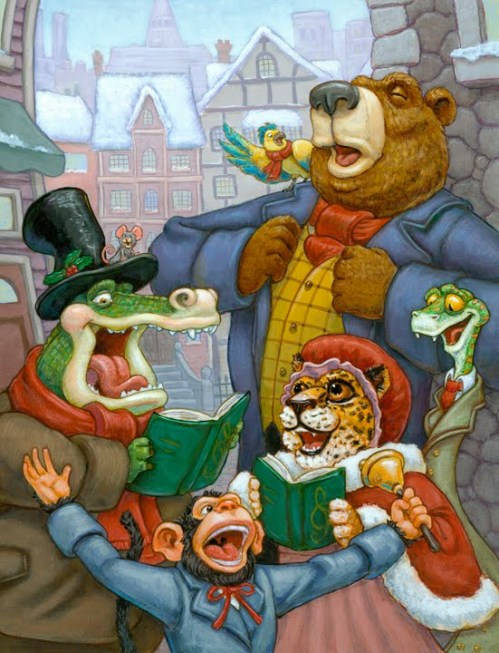
How long have you been illustrating?
I believe this year will be my fifth year of illustrating. I’m still learning, growing, and loving it.
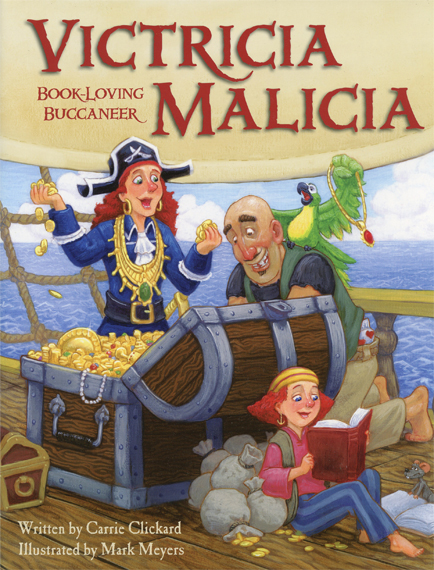
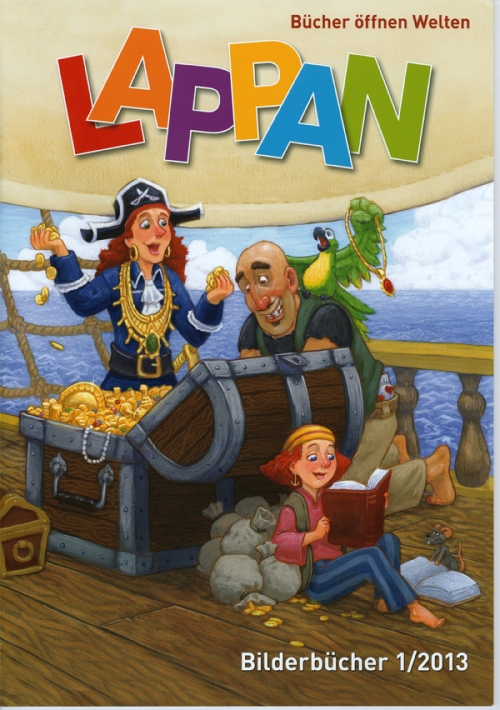
I see you live in Utah and attended Academy of Art University. How did you decide to attend AAU?
I had been playing around with 3d animation programs and making little movies at a local college. I thought maybe I would be interested in that. My sister that lived in San Francisco at the time suggested I come and tour the school. Luckily for me they had a pretty open enrollment program because I did not have much of portfolio. I had always loved to draw and make stuff but hadn’t taken it very seriously up to that point. When I actually got to AAU they start all students in fundamental drawing classes. I was honestly terrible at it but I loved it. In that first semester I made up mind do go into illustration and never even took a single 3d animation class.
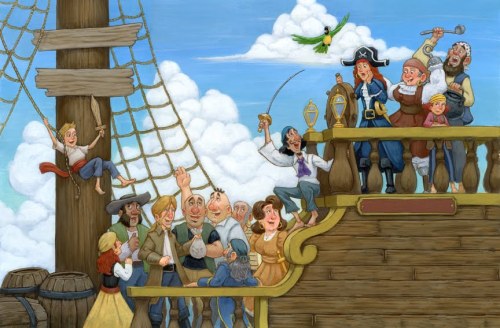
Can you tell us a little bit about that school?
For me it was a great school. They put a huge focus on learning to be a good craftsman, a very classical approach to art. As I mentioned above I didn’t have much training so it was good to start on the bottom. I can’t really speak for the rest of the school but the Illustration department and its faculty were incredible. Most of the teachers were very skilled illustrators and very willing to share their knowledge. Another great thing about being there was the huge amount of artwork that I was exposed to.

What types of things did you study there?
Kind of hard to narrow it down but lots of live drawing and painting. Then as I got further along the classes became more specific to what you wanted to do. That way you are building a portfolio of the type of work you want to do.
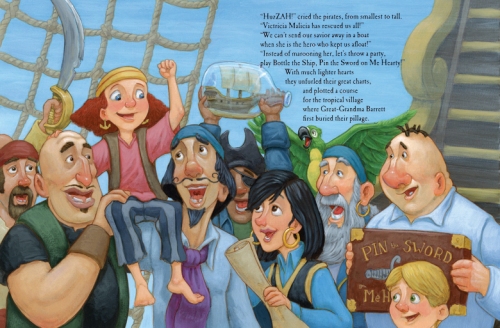
What classes were your favorites?
There were probably three classes that were my favorite. The first ones were the base illustration classes that were taught by the talented Robert Revels and Stephen Player. Craig Nelson really taught me a lot about telling a story with pictures in narrative storytelling. I had Leuyen Pham, who is a fantastic children’s book illustrator, as a teacher in a children’s illustration class which really pushed me in the direction that I have gone.
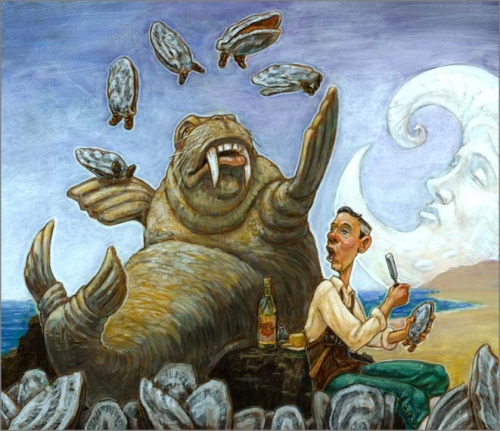
Did the School help you get work?
I don’t know that the school directly got me work. However they do have good programs to help their students get work. I just tend to be the type that goes out on there own.

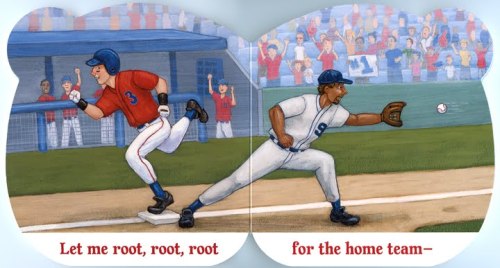
Do you feel that the classes you took there have influenced you style?
Of course the classes I took influenced my style. I think everything you see and draw does. In fact I was so influenced by them that eventually I had to step away a bit and start pushing my own style.
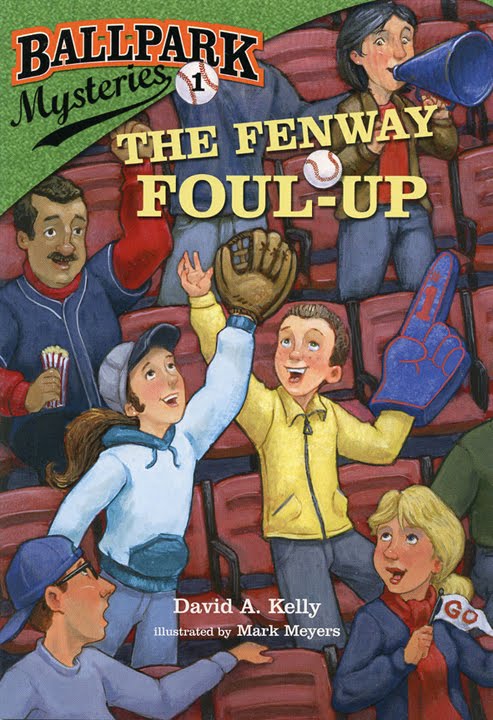
What was the first thing you did where someone paid you for your artwork?
I think the first time I ever got paid for artwork was in the sixth grade when a drawing I did won as the cover for our yearbook. I was pretty excited when they gave me a crisp twenty dollar bill.
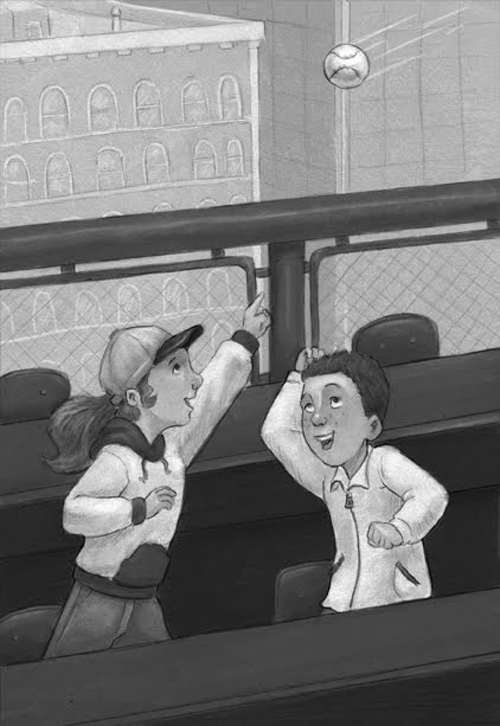
Did you move back to Utah after you graduated?
We stayed in the bay area for a couple years after I graduated, and then moved back here in I believe about 2010 or so.

What was the first illustration work you did for children?
The first illustration work I did for children was an educational book that I did for Houghton Mifflin.
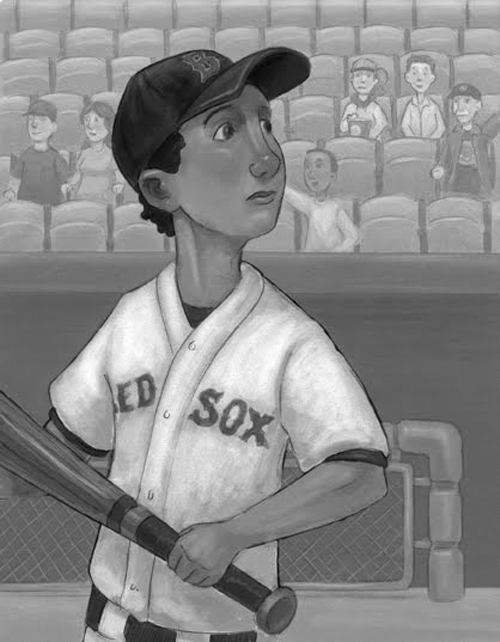
How did that come about?
I had just gotten an artist rep and that was the first job that they sent my way. I believe it was in my last semester of college.
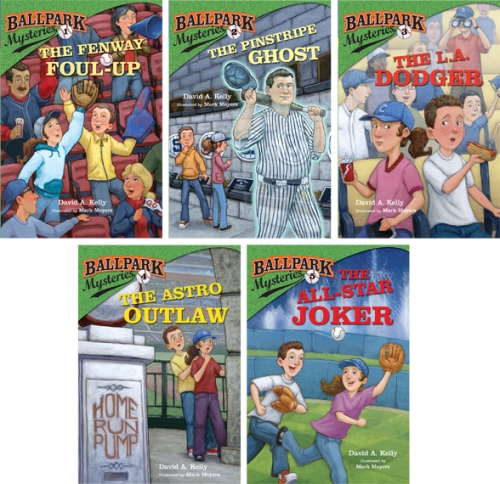
When did you decide you wanted to illustrate a children’s book?
It was probably about half way through college that I really started pushing towards children’s books. I was classically trained but my natural style tended to lean a bit to the cartoony side. I really started reading a lot of picture books and loving how the words and artwork went together. It’s still fascinating to me how the words and the pictures can simultaneously tell two stories at the same time. I also realized I was a kid who never grew up and that children’s books very much matched my sense of humor.
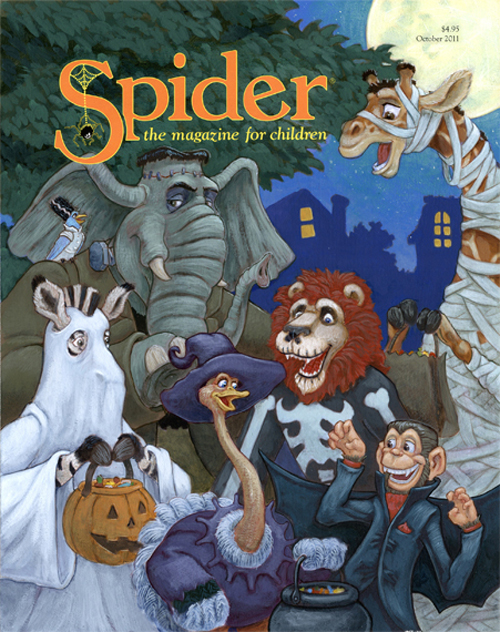
What was your first picture book? Who was the publisher?
My first picture book was Victricia Malicia and published by Flashlight Press. It’s the story of a little girl who is a book hound but is born into a pirate family.
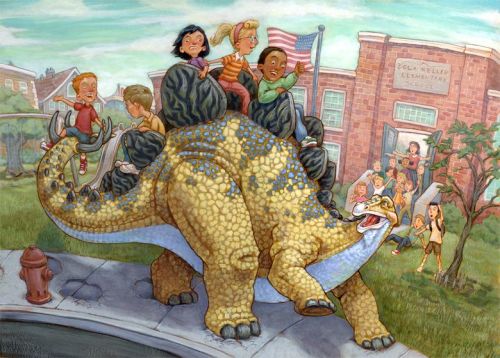
Can you tell us the story behind you getting this job?
I had an art rep but I also like to be able to send out some of my own promotional material. I had found their contact info and sent them my promo. After a little while they contact me and said they had a book that they thought would match my style, and as they say the rest is history.
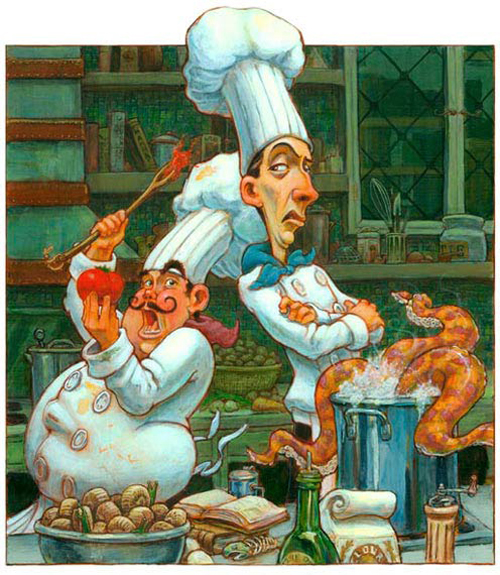
Did you do anything specific to get the contract to illustrate The Ballpark Mysteries published by Random House?
I don’t know that it was anything special. It was from promotional material that either me or my rep sent out.
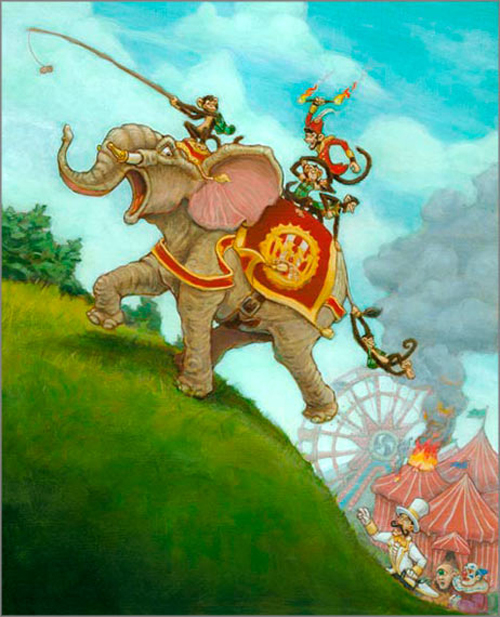
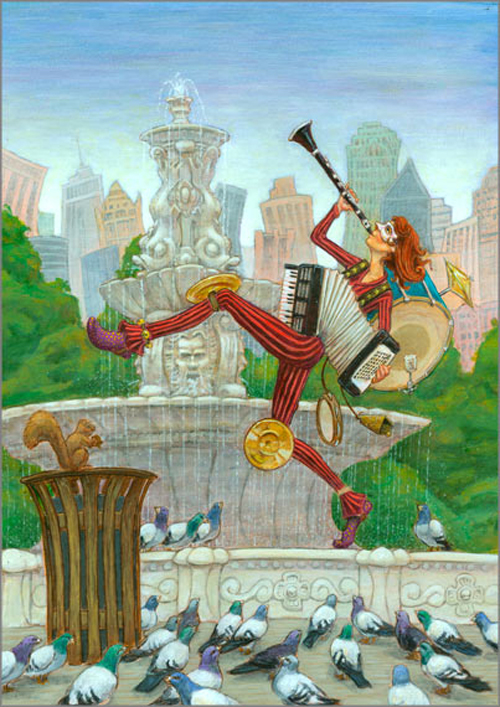
How did you get the opportunity to illustrate Take Me Out to the Ball Game?
Take me out to the Ball Game was a fun one to do and I had already illustrated a book for the publisher (read next question).
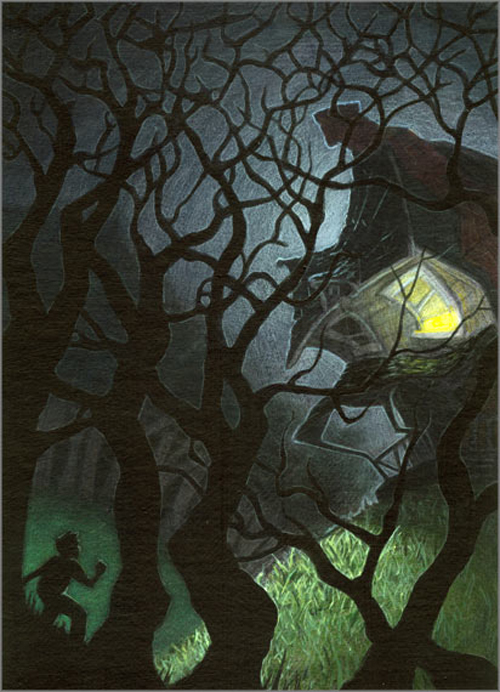
Is this the first book that you did with Ideal’s Candy Cane Press?
The first book that I did for Ideals was Counting Cows by Michelle Medlock Adams. It’s a counting book about a boy who is tired of counting sheep and decides to give cows a try. Though there are still a few sheep thrown in for fun.
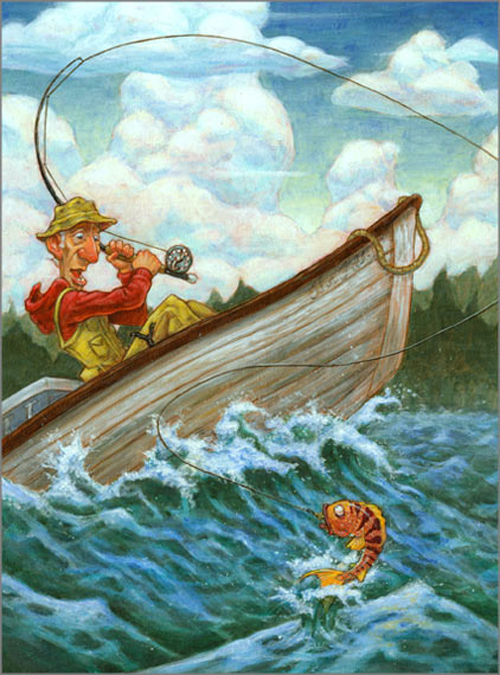
How did that contract come about?
I can’t remember exactly on this one but I believe they had seen my artwork on my artist rep’s website.
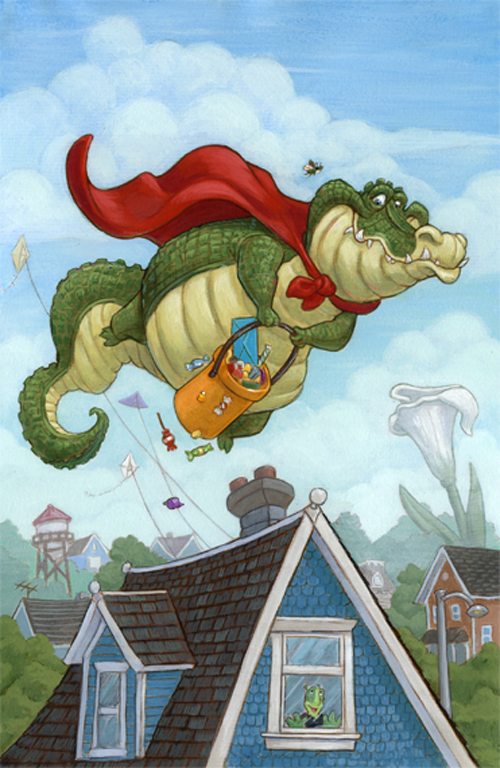
Have you done any work for children’s magazines?
I have worked with Spider, Cricket, Houghton Mifflin, and Highlights for Children. Probably my favorite of those was doing the Halloween cover for Spider Magazine.
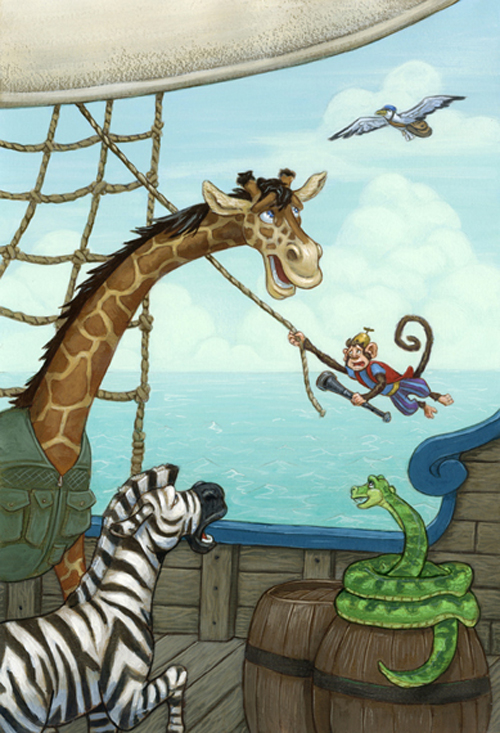
Have you worked for educational publishers?
I have done a fair amount of work for educational publishers.
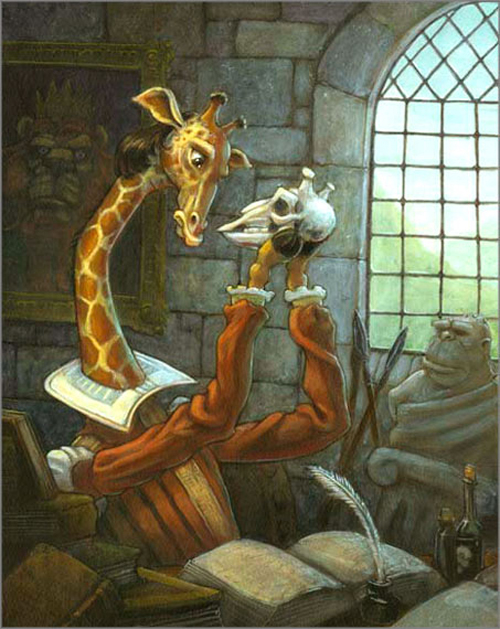
Do you have an artist rep or an agent? Could you tell us how the two of you connected?
I am represented by Wendy Lynn & Co. I was still in college but I felt like I had a fairly strong and consistent portfolio. So I started sending it out to various agents that I thought I would be a good fit with. As most new illustrators will find the sticking point was my lack of actual published work. After talking with WendyLynn for a while we decided to give it a try and I have been working with them ever since.
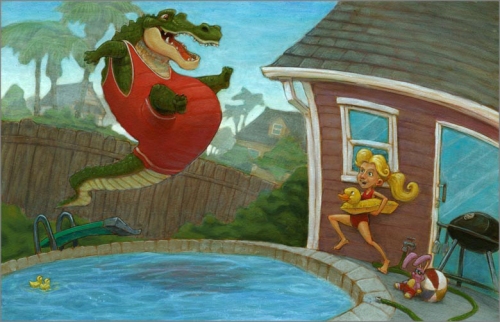
Would you ever like to write and illustrate your own book?
Absolutely! I have stories that I want to tell in both words and pictures. In the last little while I have really been pushing myself on a couple of book ideas I have to get them ready for submission to publishers. I’m still better a drawing than writing but I keep working away at it.
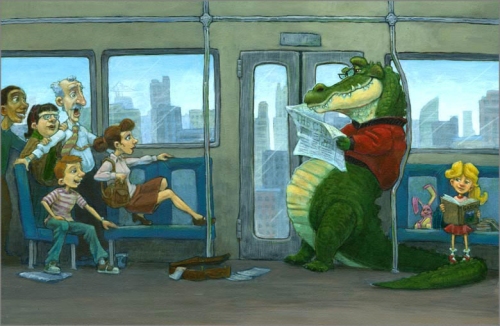
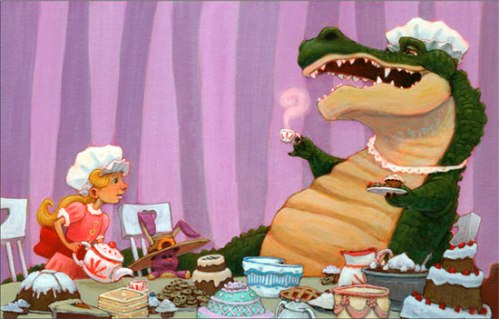
Are you open to illustrating for self-published authors?
I am, and have done several different project with self-publishers. I recently finished ‘Stories to Make you Dream’, by John Roozen.
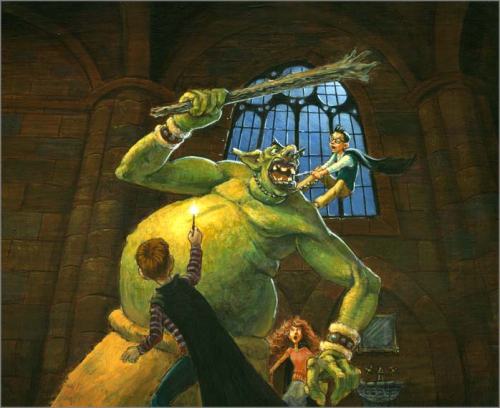
24. What types of things do you do to find illustration work?
My rep has my art featured on their site (http://www.wendylynn.com/artist.php?name=markmeyers) and on childrensillustrations.com. I also try to keep my website and blog updated (www.markmeyersart.com). I haven’t been real great at that part but I just revamped my website. In addition to WendyLynn sending out promotional material I try to get postcards sent out a couple times a year at least.
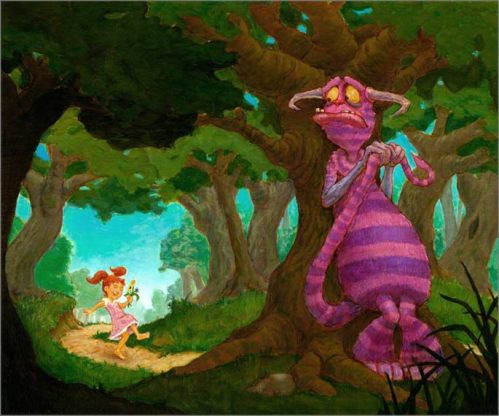
25. What is your favorite medium to use?
By far my favorite medium is acrylic. Though I like watercolors and oil too, but rarely use them for finished work.
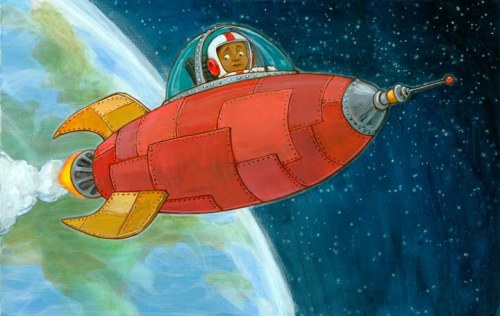
26. Not counting your paint and brushes, what is the one thing in your studio that you could not live without?
Well anymore it would be hard to get by without the computer. Also I recently picked up a 100 year old drafting table that I am in love with.
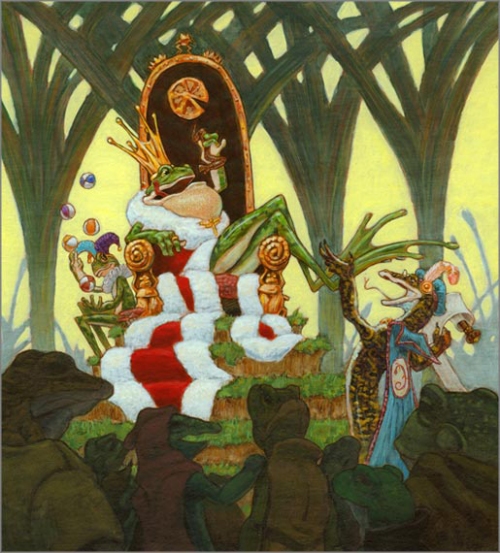
27. Do you try to spend a specific amount of time working on your craft?
I usually spend a full work day in my studio working on art. I guess that can range anywhere from 8-12 hours depending on deadlines and projects. Most of the time is consumed by current projects, but if I’m lucky to have some spare time then I try working on my back log of personal projects.
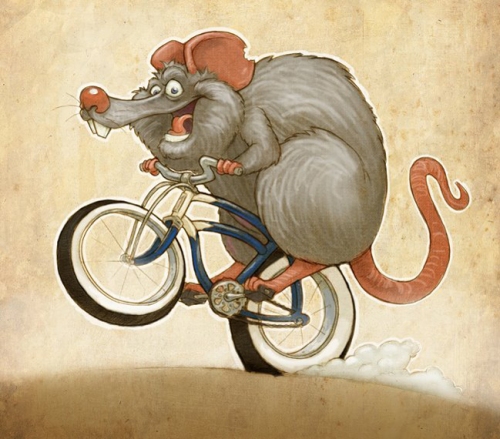
28. Have you ever won an award for your writing or illustrating?
In my last year at school I was honored to have two pieces of mine in the Society of Illustrators student competition.
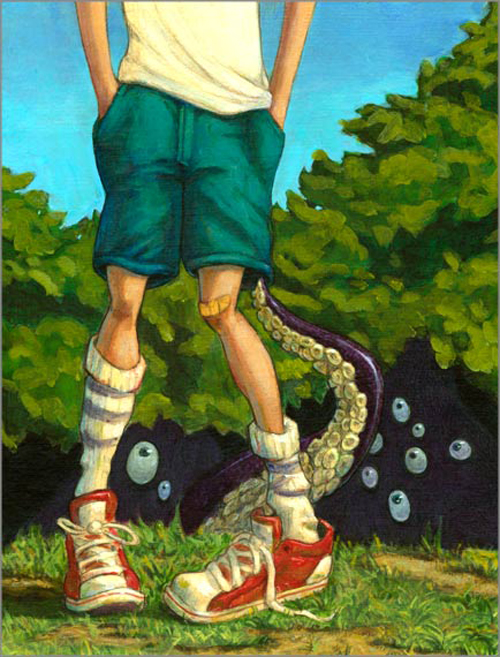
29. Do you take pictures or do any research before you start a project?
It kind of depends on the project but I usually do a fair amount of research. For me personally I try not to use much direct reference. I will study the reference and then put it away while I’m drawing and painting. That way it forces me to make it my own.
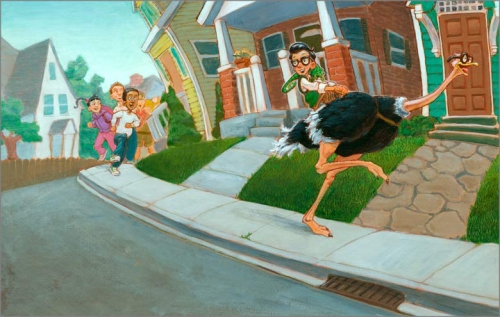
30. Do you think the Internet has opened doors for you?
I think so. The internet broadens the amount of people you can reach, and can get your work in front of a lot of people.
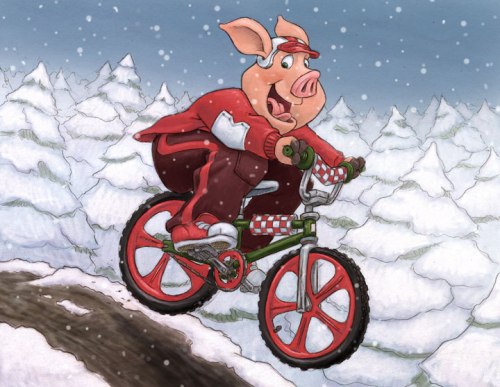
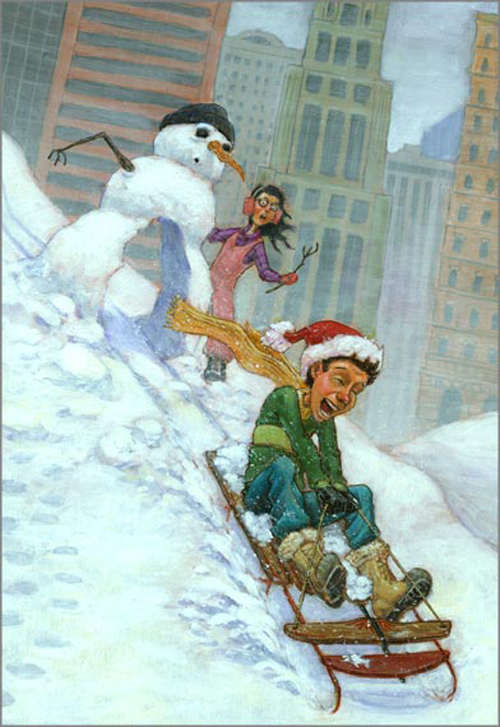
31. Do you use Photoshop with your illustrations?
I do a lot of my preliminary drawings and color studies in photoshop. If time is short sometimes I will finish a piece in photoshop but still prefer the look of my painted work.
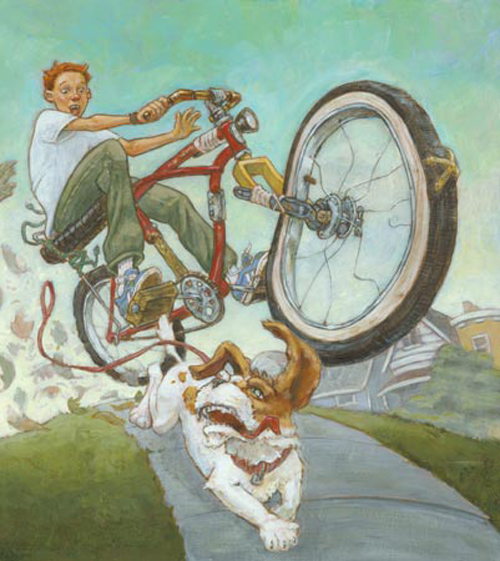
32. Do you own or have you ever tried a graphic Drawing Tablet?
Yes, I am currently using a Wacom Intuos 5. I think I would be lost working digitally without one.

33. Do you think your style has changed over the years? Have your materials changed?
It is hard for me to say if my style has changed. I think it gets refined with every illustration that I do so I guess it does. I would say the same thing happens with the materials too. You find new stuff that works and get rid of old stuff you no longer need.
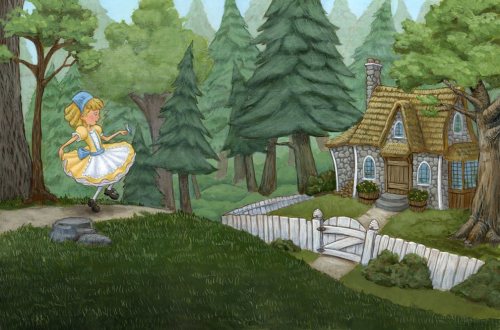
34. Do you have any career dreams that you want to fulfill?
I sure do. If I had done everything I had wanted to do then it would be time to find a new career.
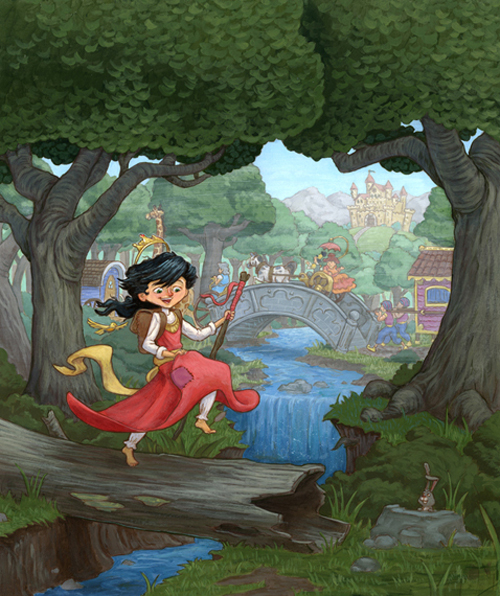
35. What are you working on now?
At this moment I am continuing to work on the Ballpark Mysteries series, book #2 in a series for a self-publisher, and a poster for a zoo.
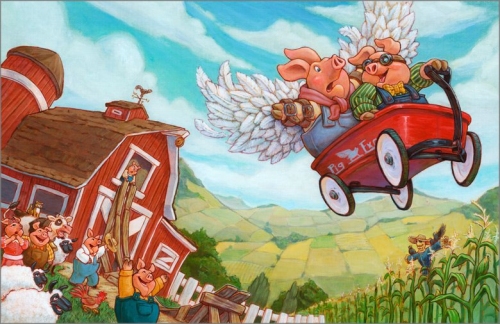
36. Do you have any material type tips you can share with us? Example: Paint or paper that you love – the best place to buy – a new product that you’ve tried – A how to tip, etc.
I am a big fan of Epson water color paper. It handles being stretched and is nice to paint back over. Lascaux makes an acrylic paint called tint white that I have found to be very useful. Though it’s not new I’ve been toying around with clear gesso and I’m really starting to like it.
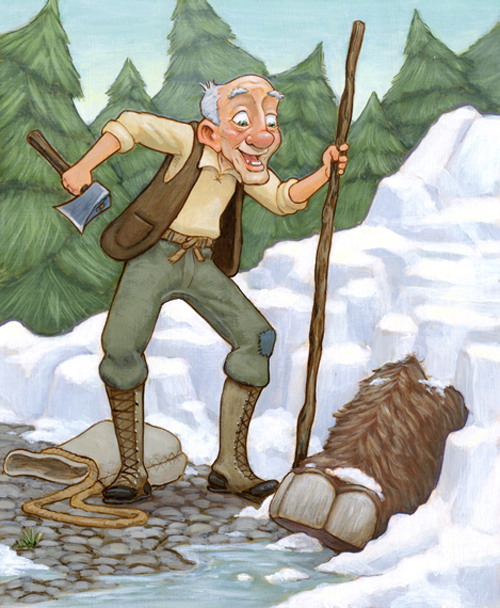
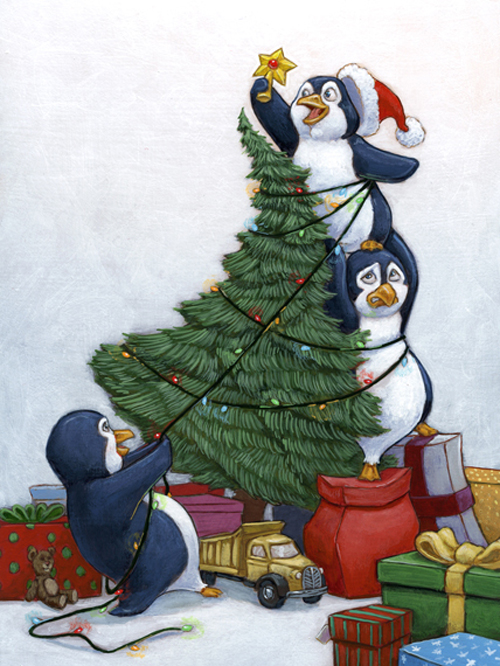 37. Any words of wisdom on how to become a successful writer or illustrator?
37. Any words of wisdom on how to become a successful writer or illustrator?
Don’t stop trying!!! From my experience in the illustration world there will be lots of ups and downs. You need to have passion for what you do and be always ready to learn. A sketchbook should be your best friend.
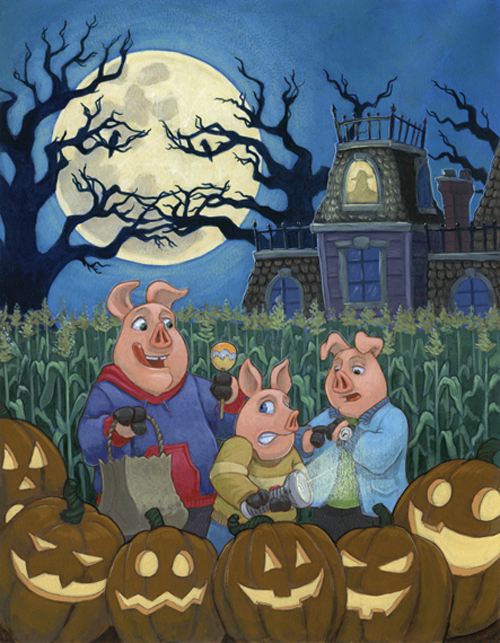
Thank you Mark for sharing your eye-catching illustrating and process with us. Please keep us up-to-date with all your future successes. We’d love to hear about them. Here is the link to Mark’s website: http://markmeyersart.com/
If you have a minute, please leave Mark a comment. We love to hear from you.
Talk tomorrow,
Kathy
Filed under:
authors and illustrators,
How to,
illustrating,
Illustrator's Saturday,
inspiration,
Interview,
picture books,
Process Tagged:
Highlights for Children,
Mark Meyers,
Spider Magazine,
Take Me Out to the Ball Game 


By: Kathy Temean,
on 9/29/2013
Blog:
Writing and Illustrating
(
Login to Add to MyJacketFlap)
JacketFlap tags:
HarperCollins,
Author,
Book,
inspiration,
Young Adult Novel,
How to,
Lauren Oliver,
Marketing a book,
Book Discussion Guide,
Getting school visits,
Panemonium,
Add a tag
I am posting this because I think all of us should be thinking past having a website, blog, and a facebook page and start thinking about selling our books. This is an excellent discussion guide for Lauren Oliver’s fabulous book, PANDEMONIUM. With this one piece she is showing that she is a true professional, generating interest in reading her book, and providing content for teachers to encourage them to invite her in to their school. Are you putting out something this high end? Next week I will share an excellent middle grade discussion guide and a picture book discussion guide. I hope these will get you thinking about doing more than just putting up a website and hoping someone calls.

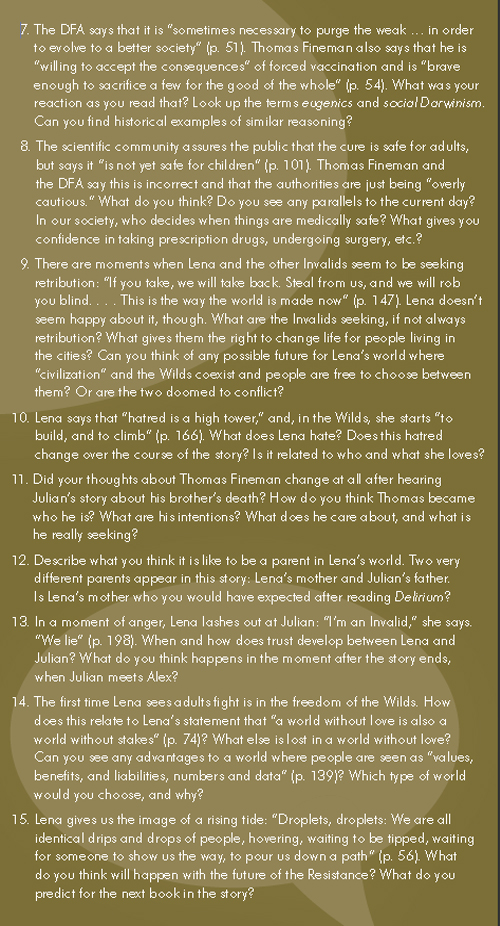
Talk tomorrow,
Kathy
Filed under:
Author,
Book,
How to,
inspiration,
Marketing a book,
Young Adult Novel Tagged:
Book Discussion Guide,
Getting school visits,
HarperCollins,
Lauren Oliver,
Panemonium 


By: Kathy Temean,
on 9/20/2013
Blog:
Writing and Illustrating
(
Login to Add to MyJacketFlap)
JacketFlap tags:
Interview,
inspiration,
Advice,
Process,
Aladdin,
How to,
Katherine Tegen,
Illustrator's Saturday,
book give-a-way,
Kristin Varner,
Pink Cupcake Magic,
Add a tag
 Kristin Varner grew up in Salt Lake City, Utah and graduated with a BFA in Illustration from Rhode Island School of Design in 1995. Kristin has been operating as KBoom, an illustration and design studio since 1998. Some of her picture books for children include ‘Big Feelings’ and ‘Aladdin – A Tale from the Middle East’. Kristin has lived in Seattle, New York City and just recently moved to Berlin, Germany. To see more of her work, please visit her website at http://www.kboom.com
Kristin Varner grew up in Salt Lake City, Utah and graduated with a BFA in Illustration from Rhode Island School of Design in 1995. Kristin has been operating as KBoom, an illustration and design studio since 1998. Some of her picture books for children include ‘Big Feelings’ and ‘Aladdin – A Tale from the Middle East’. Kristin has lived in Seattle, New York City and just recently moved to Berlin, Germany. To see more of her work, please visit her website at http://www.kboom.com
We are so lucky to see the illustrations for Kristin’s book PINK CUPCAKE MAGIC written by Katherine Tegen that is coming out in January. She has also agreed to give-a-way a signed copy of PINK CUPCAKE MAGIC as soon as she receives her copies. The book comes out in January, which isn’t too far away.

Here is how it will work: Anyone that leaves a comment will get their name put in the hat one time. If you would like to collect more entries into the hat you can do the following:
1 entry everything you tweet this link (One a day).
1 entry for putting this link on facebook
1 entry for putting up this post on your blog.
2 entries if you reblog this post.
5 entries if you talk about the book on your facebook page or blog.
Please come back and leave an update on what you did by December 1st in the comment section, so I know how many times to put your name in the hat for the drawing. I will announce the winner on Wednesday December 4th. Good Luck!
Here is Kristin explaining her digital process:

I always start my work by sketching in my sketchbook. I scan my sketch, resize, manipulate, tweak and clean it up and as needed within Photoshop.

I then flood my sketch with a wash of red. For some reason I just love the way the red reacts with the colors laid on top of it.

I then start painting directly onto the sketch using Corel Painter.

I do a complete underpainting to get down initial colors. Then I go back over with detail brushes for a final rendering.

Final.
Acrylic process
This image was created as a sample for Henry Holt. It landed me my book deal for PINK CUCAKE MAGIC, but it was never actually used in the book.
 Final sketch that was initially drawn by hand, and then scanned and manipulated within Photoshop.
Final sketch that was initially drawn by hand, and then scanned and manipulated within Photoshop.
 When I’m painting with Acrylics rather than working digitally, I have an extra step to get my sketch transferred onto my paper. I stretch a medium weight, hot press watercolor paper and then coat it with a layer of gesso to create a nice textured surface to paint on. If I have the time I will transfer the sketch myself using carbon paper. If it’s a book job and I have several paintings to kick out, I choose a paper that is thin enough to be run through an oversized commercial printer and I print my sketches out at the local copy shop, which saves me a ton time.
When I’m painting with Acrylics rather than working digitally, I have an extra step to get my sketch transferred onto my paper. I stretch a medium weight, hot press watercolor paper and then coat it with a layer of gesso to create a nice textured surface to paint on. If I have the time I will transfer the sketch myself using carbon paper. If it’s a book job and I have several paintings to kick out, I choose a paper that is thin enough to be run through an oversized commercial printer and I print my sketches out at the local copy shop, which saves me a ton time.
 I flood the image with a wash of my favorite color…..cadmium red.
I flood the image with a wash of my favorite color…..cadmium red.

I then do a complete underpainting in acrylic to block in colors.

I work over the underpainting and render in details.

Final image. Now back to the interior images of the PINK CUPCAKE MAGIC below.
How long have you been illustrating?
I received my first paid illustration assignment in the winter of 1996. So as a “professional”, I’ve been illustrating for a little over 17 years.

I see you lived in Utah and attended graduated with a BFA in Illustration from Rhode Island School of Design. How did you decide to attend RISD?
When I was applying to art schools and universities around the country, I was a bit naïve about RISD’s solid reputation. It wasn’t until I was well into my first semester that I realized how fortunate I was to have chosen such a reputable school. But, at the time, I was eager to get out of the conservative influence of Utah and experience something completely new. I was intrigued about living on the East Coast and attracted at what RISD had to offer – especially it’s partnership with Brown University and the opportunity to attend classes at an Ivy League University, which I did indeed do my Sophomore and Junior years.

Can you tell us a little bit about that school?
When I was attending RISD, I felt like the basic fundamentals of art and design were hammered into us. It was a pretty tough environment. I had amazing professors and great classes, but they pushed us hard and we were in studio classes all day and I would work on projects well into the night. I loved it. RISD taught me how to see the world in an entirely new light.

What types of things did you study there?
The first year is foundation and everyone takes the same courses – drawing, two dimensional design, three dimensional design and art history. After declaring my major in Illustration I took the mandatory courses like drawing, painting and conceptual illustration, but for the remaining 3 years I was free to explore within and out of the department, dabbling in mixed media courses, watercolor, poster design, children’s book and editorial illustration, photography, printmaking and on and on.

What classes were your favorites?
I loved almost all of my classes in the Illustration department. I also took a class called “New York, New York” that was in the sculpture department. We hopped on a bus every other early Friday morning and drove down to New York City where we spent the entire day running after our professor (Ellen Driscoll) who would drag us to museums, galleries, random installations, meetings with art dealers, studio visits and any other nook and cranny in the city that had something interesting going on. It was pretty amazing and unrelated to all of my other illustration studio courses, but I found it to be totally inspiring.

Did the School help you get work?
Only indirectly. I landed some work and made connections by being associated with RISD. It was only a few years later that I found some assignments through RISD’s online job/internship publication called Artworks.

Do you feel that the classes you took there have influenced you style?
Yes I do think my style was somewhat influenced from school, but it’s an on-going process. My style continues to develop the more I experience and continue to research and find inspiration, albeit slowly!

What was the first thing you did where someone paid you for your artwork?
For the first several years after I graduated from RISD, I was doing a lot of editorial work for magazines. My first paid gig was an editorial spot for Utah Business Magazine. It actually turned out quite nice.

Did you move back to Utah after you graduated?
Yes, I unsuccessfully shopped my portfolio around the children’s book publishing houses in New York City for 6 months before finally giving up and I moved back to Salt Lake City, Utah (where I promptly found work!). I stayed in Utah for two years, then moved up to Seattle for eight years and eventually made my way to Brooklyn, New York where I happily lived for another four.

What made you move to Berlin, Germany? How long have you been there?
My musician boyfriend at the time (now fiancé) was itching to leave New York and was drawn to Berlin predominantly for the music scene. We both loved the idea of living in Europe and I’d always wanted to really experience another culture, relish in the cuisine, learn the language etc. I’d spent time In Berlin in 2001 and was fascinated by the history of the city as well as how it’s continuing to rebuild itself today into a creative, modern metropolis. We lived in Berlin just over 3 years.

Do you find the German illustrating market different than the US?
The german children’s book trade market is very different than the US. My first year in Germany, I attended the Frankfurt Book fair and met with several German, Austrian and Swiss publishing houses. I was completely caught off guard when they told me that my style was “too american” . German kids books are beautiful. They are sophisticated and often more edgy – sometimes border-lining on the bizarre. The color palette is much more subdued. Although my work is still punchy and very “american,” I do like to think that the german influence did permeate my style a bit.


Do you think you will move back to the United States?
I loved my life in Berlin and thought we’d never leave, but a big job opportunity came up for my fiancé that we couldn’t pass up on and that brought us back to the States in March. We are living in Seattle now, and even though we were not yet ready to leave Berlin, it is nice to be back in the States with all it’s conveniences and closer to family. It’s funny though, we do find ourselves constantly assessing the pros and cons of living in the two countries.

What was the first illustration work you did for children?
It was actually a job for Macy’s department store in Seattle. They funded an annual mothers day celebration in partnership with the Woodland Park Zoo called “Mom and Me at the Zoo”. I was hired to create the illustration for the event. I believe that was in 2004.

How did that come about?
The art director at Macy’s found me through my website.

When did you decide you wanted to illustrate a children’s book?
It was 7th or 8th grade when I started collecting books solely for their imagery. At that time, I was especially into fantasy art. I can remember flipping through pages of dragons, wizards and magical landscapes and realizing that I really wanted to be illustrating these kind of books as well.

What was your first picture book? Who was the publisher?
“Big Feelings”, published by Parenting Counts

Can you tell us the story behind you getting this job?
I was living in Brooklyn when this book actually came to fruition. It was written by Talaris Institute, who publishes picture books as well as books on childhood development and educational materials for parents. They were a client of an art director, friend of mine back in Seattle. She had used an illustration that I did of an Elephant in a design comp for one of their brochures. Years later, as they were working on the manuscript for BIG FEELINGS, a book all about emotions as told through animals, they re-discovered my elephant painting from years back and contracted me for the job.

Did you do anything specific to get the contract to illustrate ‘Aladdin – A Tale from the Middle East’?
The Aladdin book was for Macmillan UK over in England. They hired me directly through my children’s book agent.

How did you get the opportunity to illustrate a book written by Katherine Tegen?
This opportunity also came about through my agent, although not in typical fashion. My agent routinely sends samples out to publishers and art directors. Katherine Tegen happened to see my samples at Henry Holt and thought my style would be perfect for her book. Since Tegen is an editor and has her own imprint at HarperCollins, she had the pull to get me on board. Holt was a bit nervous in the beginning, risking a no-name illustrator like myself to do a book for a big-wig like Tegen, but they sent me the manuscript and asked me to create a sample for them. In the end, they were pleased as punch and we were off and running.

Is this the first book that you have done with Henry Holt?
Yes.

How excited were you to get to illustrate a book by a famous editor and children’s publisher?
I was absolutely thrilled! It was by far my biggest accomplishment to date. My only apprehension was that I was 7 months pregnant when I landed the contract! I had no idea how I could handle a baby and complete a major picture book in the first several months of becoming a new mom. It all worked out just fine in the end.

Have you done any work for children’s magazines?
Yes, I’ve worked with Highlights HIGH FIVE, Scholastic’s LETS FIND OUT, Scholastic’s “GO!” and I just recently finished a piece for CLUBHOUSE JR.

Have you worked for educational publishers?
The educational market is the bread and butter of my survival as an illustrator. I’ve done countless small readers for educational publishers such as Pearson, MacMillan/McGraw-Hill, Harcourt, Houghton Mifflin and Oxford University Press, to name a few.
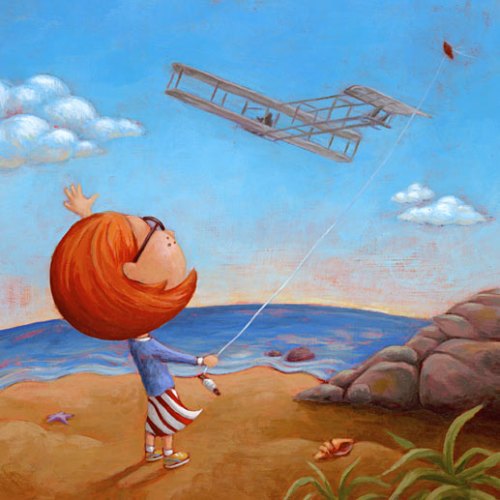
Do you have an artist rep or an agent? Could you tell us how the two of you connected?
I’ve been represented by Maggie at Byer-Sprinzeles Agency for about 8 years now. She is also a fellow RISD alumna and she came across my work on the ispot website where I was advertising my portfolio at the time. She sent me a complimentary note about my work and then the dialog progressed toward the possibility of representation. It’s been a wonderful relationship.

Would you ever like to write and illustrate your own book?
Absolutely. I have a few ideas that I’ve been working on, but haven’t put anything on paper just yet.

Are you open to illustrating for self-published authors?
I get approached by at least a half a dozen or so writers every year who are looking to self-publish their manuscript. In most cases the authors have not done much research and have a very limited budget. I have yet to consider taking one on and I don’t think it would be wise for me to do so at this point in my career, unless it was under extraordinary circumstances, or the opportunity to work with a close friend.

What types of things do you do to find illustration work?
These days most of my work is derived directly through my agent and I rely on her to do the majority of my promotion as well. I also advertise my portfolio on the childrensillustrators.com website.

What is your favorite medium to use?
Acrylic paints.

Not counting your paint and brushes, what is the one thing in your studio that you could not live without?
Music. I don’t like working in silence and depending on my mood the genre can vary. I just feel like I’m much more productive when I have tunes on.

Do you try to spend a specific amount of time working on your art?
I don’t have a set time per se but I’m quite a regimented person and my time is more limited these days. When I do have my scheduled work time, I try to make the most of it. If I’m not working on an assignment, I try to sketch or write down ideas for new projects or promotions.

Do you take pictures or do any research before you start a project?
I like to do a ton of research. If I’m working at my drafting table, I will make loads of printouts so that I have a collection of images for reference. I also use books with sticky notes so I can easily flip between pages. I find the bulk of my imagery off google images or getty but I will shoot my own pictures as well if I can’t find the correct angle I’m looking for.

Do you think the Internet has opened doors for you?
Yes. No question about it. The ease of having a portfolio online has provided an opportunity for my work to be seen by art directors, agents, and publishers all over the world.

Do you use Photoshop with your illustrations?
I use Photoshop after I’ve scanned my sketch. Sometimes I’ll spend hours within Photoshop, scaling pieces of my sketch, moving things around, changing proportions, tweaking and rearranging until I’m happy with the composition. If the illustration is going to stay digital, I will then take the sketch into Corel Painter for a painterly look, or Adobe Illustrator if it’s a more graphic approach. If I’ll be using my acrylics to paint, I will print the sketch back out and transfer it onto watercolor paper.

Do you own or have you ever tried a graphic Drawing Tablet?
Yes I use the basic Intuos Wacom tablet. I can’t function with a mouse anymore. I am very tempted to try using a Cintiq.
N

Have you ever won an award for your writing or illustrating?
The “Aladdin – A Tale from the Middle East” book won the 2011 Language Learner Literature Award in the Young Learner category. Otherwise, I’m terrible about submitting my work to competitions and seem to be about two weeks late when finally getting around to those call for entry forms.

Do you think your style has changed over the years? Have your materials changed?
My style has certainly changed since my early days. I still have slides of my portfolio from high school and my RISD years. I always document my work for my own personal library, whether I think it’s horrible or stupendous. I keep an active folder on my computer containing a catalog of all my current and past pieces. It’s very gratifying for me to occasionally go back and review past projects and see how my work has progressed. My materials have not changed. I’m still using acrylic paints, but over time I’ve developed a specific process of how I’m using them. The same goes for when I’m working on the computer. I have my own method that has evolved over time.

Do you have any career dreams that you want to fulfill?
#1. I’d like to start writing my own books as well as illustrating.
#2. I’d like to have my work shown in galleries.
#3. I love teaching. I taught Adobe Illustrator classes to professionals in New York at Noble Desktop and I think teaching is my true calling. I’d like to teach again, perhaps an illustration course focusing on the Children’s Market on a collegiate level.

What are you working on now?
I’m wrapping up a small assignment for Pearson Education right now and will be starting on a few small Young Readers starting in October.

Do you have any material type tips you can share with us? Example: Paint or paper that you love – the best place to buy – a new product that you’ve tried – A how to tip, etc.
I use Golden for my acrylic paints. I find them to be especially fluid to work with. They’re a great company. I had issues with some faulty caps when I was right in the middle of working on a big educational book assignment. They overnight, shipped me brand new tubes of paint over to Germany without any hesitation.

Any words of wisdom on how to become a successful writer or illustrator?
I had a professor at RISD who’s advice has stuck with me over the years. He said that as an illustrator, we should always create our best possible work, even when the client or job seems insignificant. Treat every assignment as if it were golden. I truly believe that persistence pays off at some point down the line….just be patient!

What are some of the companies you have worked with?
Partial client list:
Children’s Museum of Utah Crocodile Creek Hartcourt Brace & Co. Highlights for Children Houghton Mifflin Company Macmillan/McGraw-Hill Oxford University Press Parenting Counts Press PBS Kids Quarasan Scholastic Pearson Education Sun Dance Publishing
Thank you Kristin for sharing your talent, expertise, and journey with us and double thanks for giving us a chance to win a signed copy of your book. It looks like so much fun. You can visit Kristin at: www.kristinvarner.com
Don’t miss your chance to win and leave a comment about Kristin illustrations and book. See above to see what things you can do to increase your chances to win.
Talk tomorrow,
Kathy
Filed under:
Advice,
How to,
Illustrator's Saturday,
inspiration,
Interview,
Process Tagged:
Aladdin,
book give-a-way,
Katherine Tegen,
Kristin Varner,
Pink Cupcake Magic 


By: Kathy Temean,
on 9/6/2013
Blog:
Writing and Illustrating
(
Login to Add to MyJacketFlap)
JacketFlap tags:
Interview,
inspiration,
Advice,
Process,
Random House,
authors and illustrators,
Kristi valiant,
How to,
Illustrator's Saturday,
editor Michael Joosten,
Penguin Cha-Cha,
Contest,
Add a tag
 In fourth grade, Kristi often got in trouble for drawing too much during class.
In fourth grade, Kristi often got in trouble for drawing too much during class.
After graduating magna cum laude from Columbus College of Art and Design as an Illustration major, I worked in the graphics department at an educational publisher. Now I write and illustrate children’s books.
She’s represented by Linda Pratt from Wernick & Pratt Agency.
I’ve illustrated the following: THE LITTLE WINGS Chapter Book Series (Random House 2012) THE GOODBYE CANCER GARDEN (Albert Whitman & Co., March 2011) DO YOU LOVE ME MORE? (Standard, Jan 2011) OLIVER’S FIRST CHRISTMAS (Accord, Oct 2010) DANCING DREAMS (Accord, Sept 2010) CORA COOKS PANCIT (Shen’s Books, 2009)
Kristi is the Indiana Regional Advisor of the Society of Children’s Book Writers and Illustrators (SCBWI) and has great news she has just made her debut as author/illustrator with the publication of PENGUIN CHA-CHA from Random House.
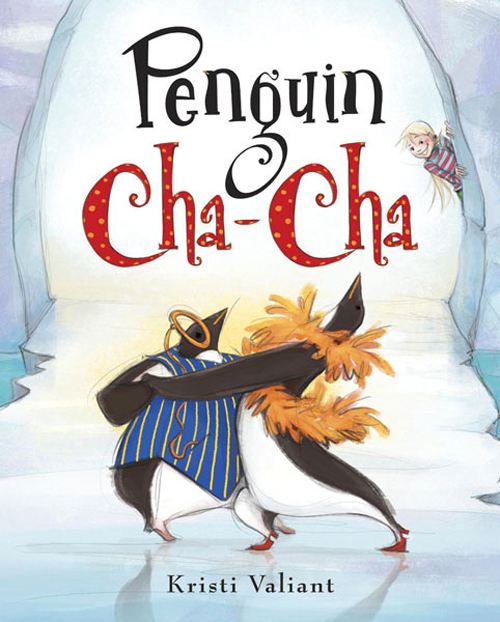
And I have Great News for all of you. Kristi has agreed to give away a Penguin Prize Package – a signed book along with a magnet, sticker, and bookmark for this adorable book. Anyone that leaves a comment will get their name put in the hat one time. If you would like to collect more entries into the hat you can do the following:
One entry everything you tweet this link (One a day)
One entry for putting the link on facebook or your blog.
Five entries if you read the book and talk about it on your facebook page or blog.
Please leave what you did in the comment section, so I know how many times to put your name in the hat. You have until this coming Thursday to enter to win the Penguin Prize Package.
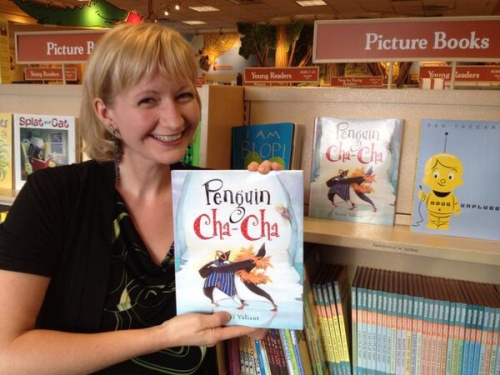 I think she looks excited. Here is Kristi Showing her process.
I think she looks excited. Here is Kristi Showing her process.
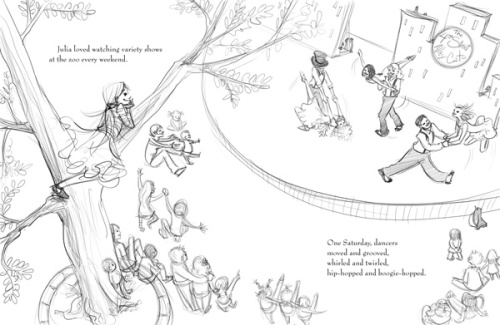
Sketch drawn on Wacom Centiq – from the original dummy submitted.
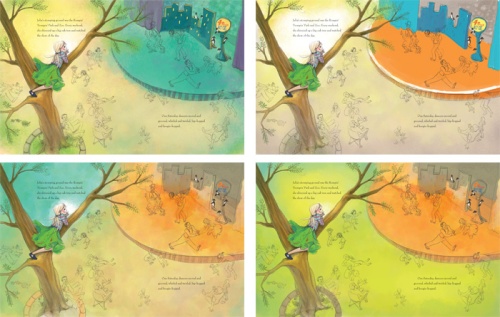
Quick color studies painted in Photoshop to find the overall color scheme of the page.
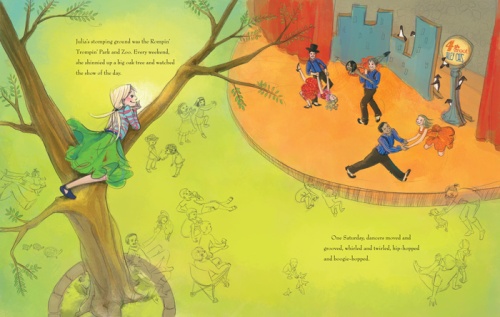 Blocking in the color.
Blocking in the color.
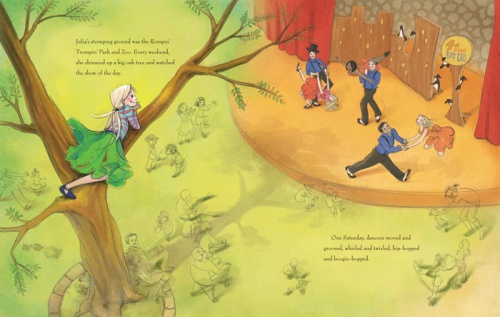
Painting the details and muting the background so Julia stands out more in Photoshop.
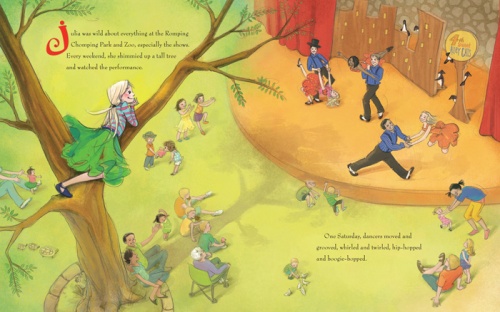
Above: This is the finished piece. Below: An Early Version of Penguin Cha-Cha.
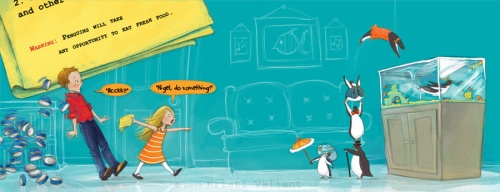
How long have you been illustrating?
I illustrated my first book while still in art school, so I’ve been illustrating children’s books for 14 years.
I see you graduated magna cum laude from Columbus College of Art and Design as an Illustration major. That is pretty impressive. Can you tell us a little bit about how you decided to attend CCAD?
My high school art teacher showed me a promotional book from CCAD with work by CCAD students. I had looked at other art schools, but loved the illustration work from this art school the best. The decision was made even easier when I received a partial art scholarship to CCAD and one of my closest friends decided to go to Ohio State in the same city.
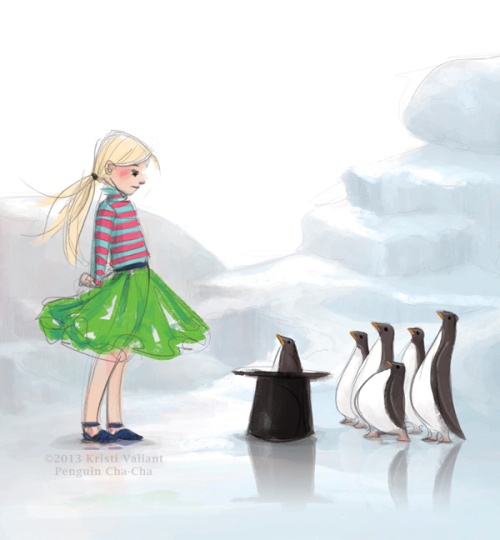
What types of classes did you take?
It’s a 4 year art school, and all of our courses had to do with art in some way. Freshman year I took classes like perspective drawing, figure drawing, art history, 2D design, 3D design, color concept, typography, painting, etc. After freshman year I was able to take courses in my specific major of Illustration as well as electives.
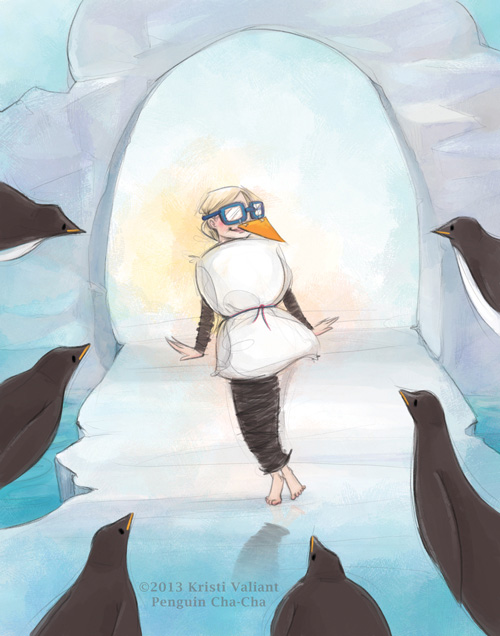
What classes were your favorites?
Digital illustration, advanced Photoshop, an illustration class taught by C.F. Payne, color concept, and fashion illustration.
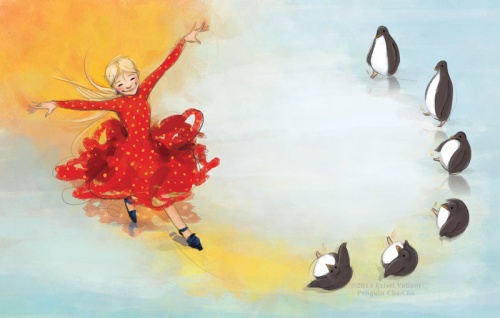
Did the School help you find work?
Yes. From a job fair at CCAD, I received some freelance illustration work from Bath & Body Works drawing Christmas characters for on merchandise, and I found an internship at a tiny children’s book publisher called Berry Books. During my senior year, all illustration majors had an assignment in which we illustrated a few pages from a children’s book by an educational publisher called Seedling Publications. The publisher choose me as the final illustrator for the book. I went on to work in their graphics department laying out children’s books after I graduated as well as illustrating more books for them.
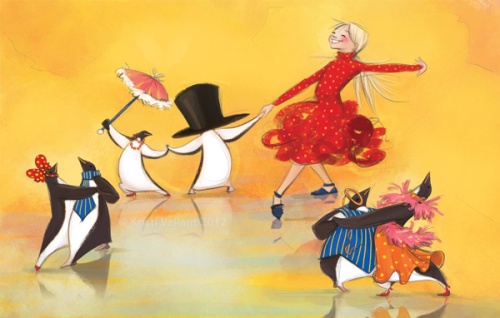
Do you feel that the classes you took influenced your style?
That’s hard to say. I’d like to think my style is my style and I would have drawn the same no matter what, but I’m sure learning specific techniques and seeing the work of other students and masters definitely influenced what I do. In C.F. Payne’s class we had to put together a binder of artwork that inspired us. Looking through each student’s binder was very telling as to what styles they loved. But then C.F. Payne encouraged us to find different styles and learn to respect and see the mastery in that work as well. It’s opened me up to playing more with color and texture and different kinds of things that I notice in different art styles than my own.

What was the first thing you did where someone paid you for your artwork?
As a young teen I face-painted at events, and as a freshman in high school I created an airbrush t-shirt business after learning how to airbrush in art class. Then I did murals at my local YMCA and Walmart in high school too.

What was the first thing you did for children?
My first children’s book that I illustrated was for a tiny publisher called Berry Books.
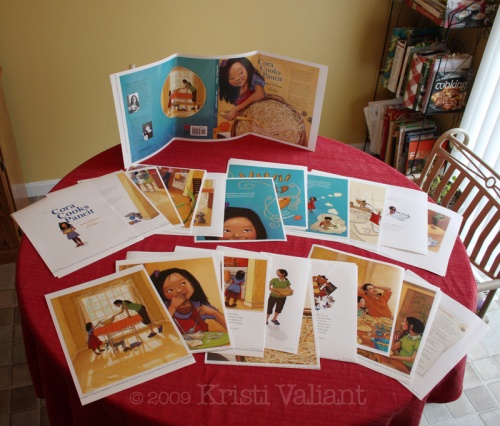
How did that come about?
I met the owner of Berry Books at a job fair at my art school. He hired me to help with graphic design, marketing, book layout, and so on. It was such a tiny publisher that there were only 3 of us. The owner also owned a berry farm, and during berry season, we’d head out to pick berries and eat bowls of vanilla bean ice cream with berries for lunch. Yum!
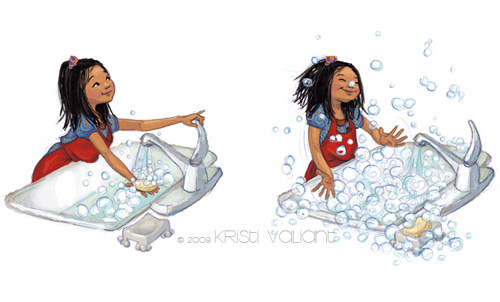
When did you decide you wanted to illustrate for children?
I’ve always loved children’s books and have a special one with gorgeous illustrations from when I was a child (actually, it’s my brother’s, but don’t tell him). It’s called Dean’s Mother Goose Book of Rhymes, illustrated by Janet and Anne Grahame Johnstone. I think that’s one of the main reasons I chose to illustrate for children. I made my first book in elementary school. My teacher asked me to read it to a younger class, and I was hooked.
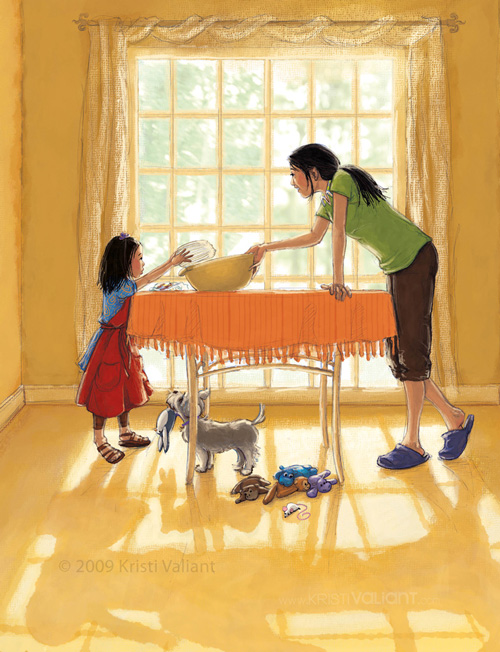
Have you done any work for children’s magazines?
Yes, for Highlights magazine. What a wonderful company!
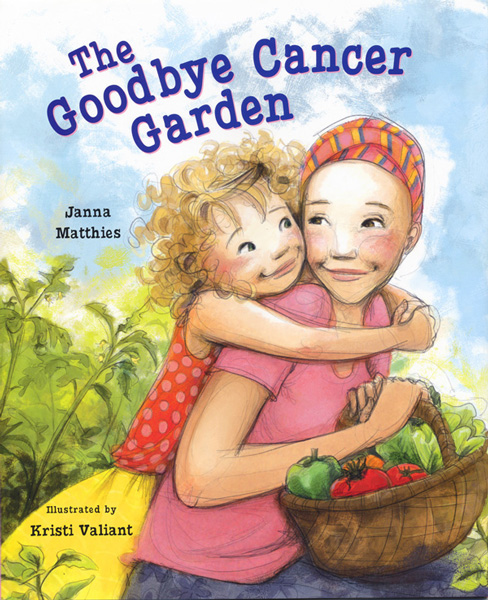
Have you worked for educational publishers?
Yes, I’ve illustrated over 30 books for educational publishers and I worked in the graphics department of an educational publisher, Seedling, after graduating from art school. It was a family run business and a joy to work there. I’ve also illustrated hundreds – perhaps thousands – of black and white vector illustrations for educational publishers.
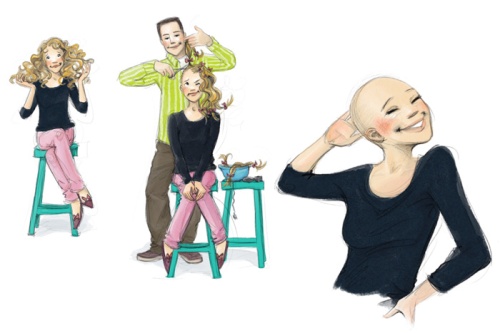
How many children’s books have you published?
A hand full of hardcover picture books in the last four years for various publishers as well as a chapter book series called Little Wings for Random House (the 5th in that series just came out), and before that I illustrated dozens of educational children’s books.
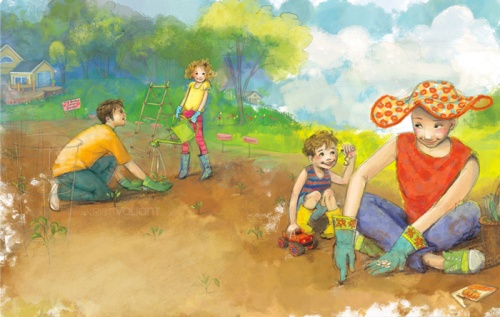
Was CORA COOKS PANCIT (Shen’s Books, 2009) your first picture book?
Yes, CORA COOKS PANCIT was my first picture book for the trade market. It was the Picture Book Winner of the 2010 Asian/Pacific American Awards for Literature (APALA)! The author, Dorina K Lazo Gilmore, and I both flew to Washington DC for the award during ALA. It was such an honor for our book to win the award and I loved meeting Dorina!
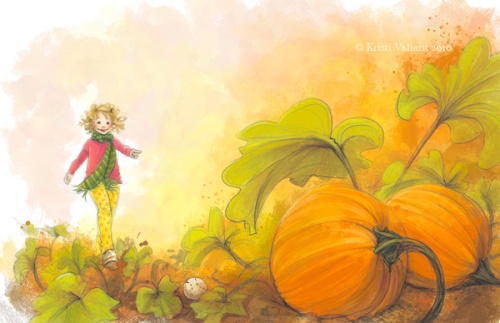
How did that connection come about?
I happened to send a postcard art sample to Shen’s Books just as they were looking for an illustrator for that book. What perfect timing! The book’s main character is a Filipino girl named Cora and I had sent an Asian girl on my art sample that they liked.
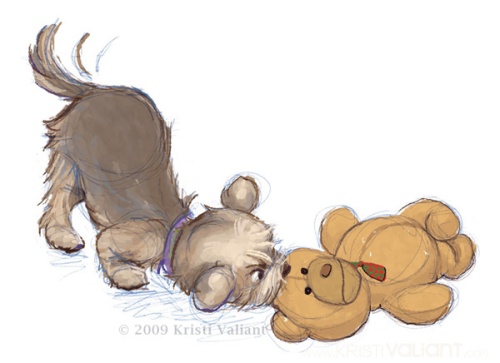
Can you tell us a little bit about Shen’s Books?
Shen’s Books is a small publisher of multicultural books based out of California. Their books are lovely!
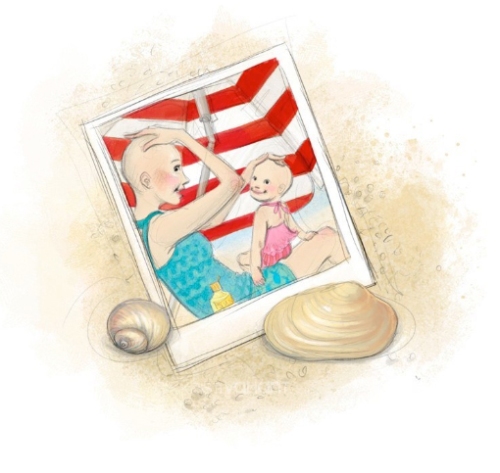
In 2010 you published two books with Accord. Could you fill us in on that publisher and share the story of getting those contracts?
I honestly don’t remember how Accord found me. They create innovative children’s books that have some kind of novelty to them usually. Both of the books I illustrated for them, DANCING DREAMS and OLIVER’S FIRST CHRISTMAS, are part of their AniMotion series in which the illustrations appear to be animated as you turn the page. I illustrated them as normal spreads keeping in mind exactly where the animated part would fall, and they created the animations.
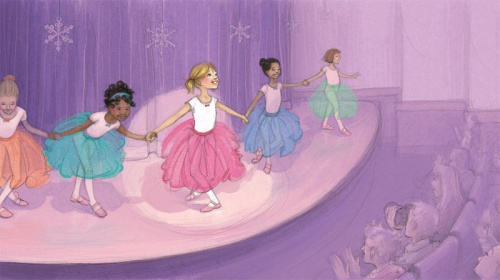
Then in 2011 you published DO YOU LOVE ME MORE? with Standard. How did that come your way?
I think Standard found me through my website. This book has a wonderful way of explaining God’s grace. Standard is a great publisher of Christian books.
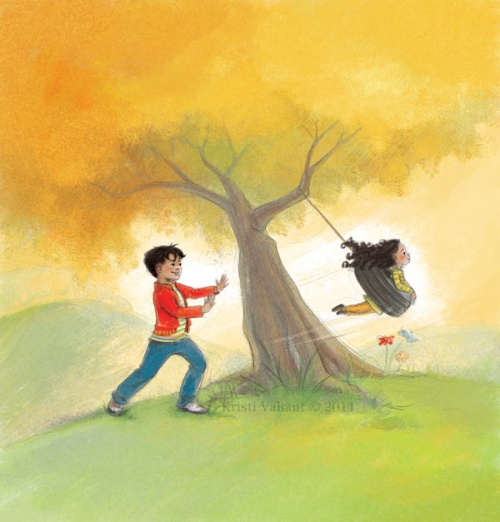
How did you end up being represented by Wernick and Pratt Agency? When did that happen?
I met Linda Pratt at a dessert party during an SCBWI conference. I had sought her out when I felt I was finally ready for an agent, because I really liked her clients and thought we may have a bit of the same taste, so perhaps she’d like my work. She had just seen my artwork on display for winning the illustration contest at the conference and commented on it. We had a great chat and she invited me to submit. I was very blessed to have had such an easy time finding my dream agent.
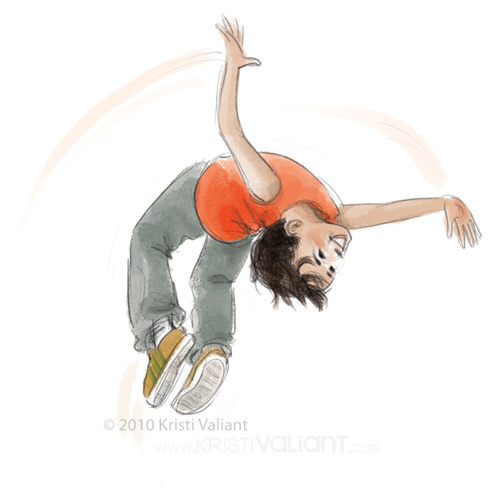
How many contracts have they gotten for you?
Linda became my agent just as Random House wanted to acquire PENGUIN CHA-CHA, so she negotiated that one. She’s also negotiated a number of books I’ve illustrated: the Little Wings contracts, a book cover, and now PRETTY MINNIE IN PARIS, a picture book written by Danielle Steel that will be published by Doubleday/Random House in fall 2014.
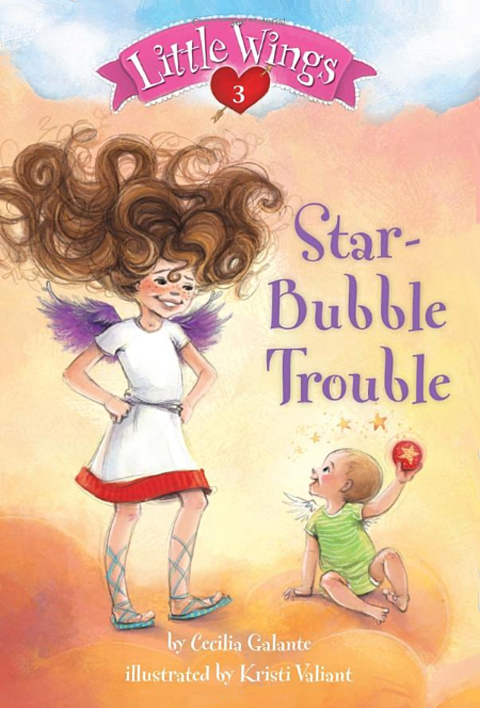
When did you decide to start writing and illustrating?
In 2007 I started writing some manuscripts and joined a critique group to help with my writing. Writing picture books really means learning a whole separate skill set. It took years to get one manuscript that was solid.
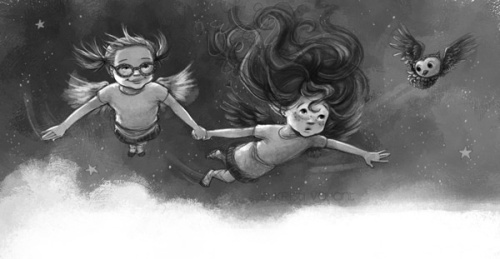
Is PENGUIN CHA-CHA from Random House the first book where you were the author and the illustrator?
Yes!
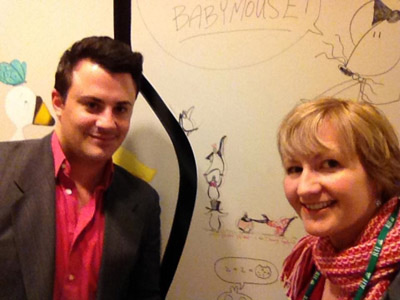
Kristi and her editor, Michael Joosten in front of the illustrator’s wall at Random House on the kid’s editorial floor. Some big name illustrators have drawn on that wall, and Kristi says she was thrilled when Michael asked her to add her penguins to it!
Tell us a little bit about the story and how you came up with the idea.
PENGUIN CHA-CHA began as an illustration for in my portfolio. I was in a swing and Latin dance group and wanted to draw some dancing illustrations. I like penguins and thought it would be fun to make them dance in a Latin dance competition, so that became a portfolio piece. Editors and art directors kept pointing out that illustration in particular in my portfolio and asking for a story to go along with it. I wrote story after story about dancing penguins until I finally got one that I really loved. Julia discovers that the penguins at the zoo are dancing when no one is around. She wants to join their jitterbug, but they freeze like penguin Popsicles whenever she approaches. Will they ever dance with her?
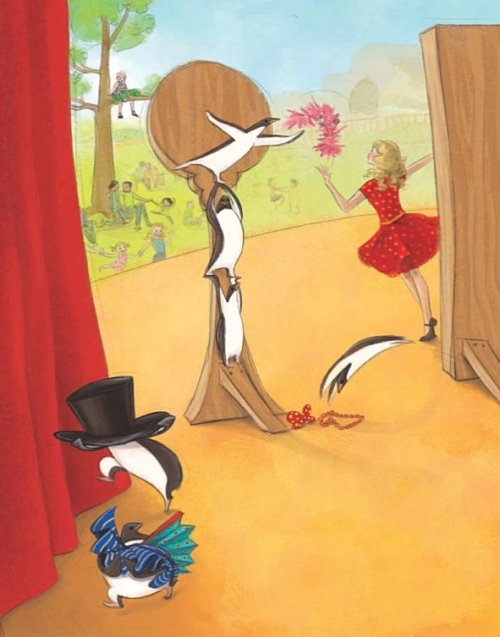
How long have you been Regional Advisor for the SCBWI in Indiana?
Since 2010. SCBWI has been instrumental in my career, so it’s an honor to volunteer in the role of Regional Advisor.
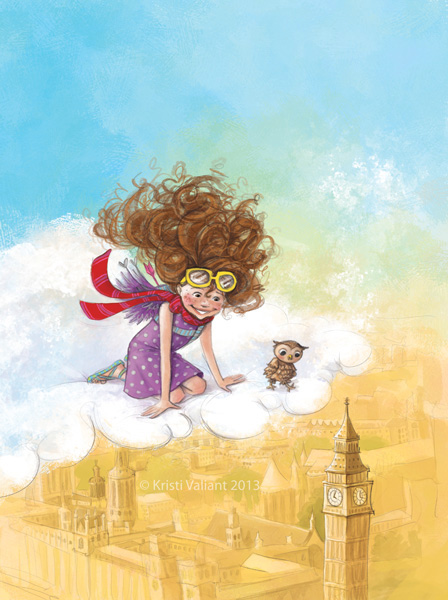
Have you ever illustrated a book for a self-published author?
Yes, twice when I was first starting out and needed pieces for my portfolio. I don’t anymore. One was a great experience and one wasn’t.
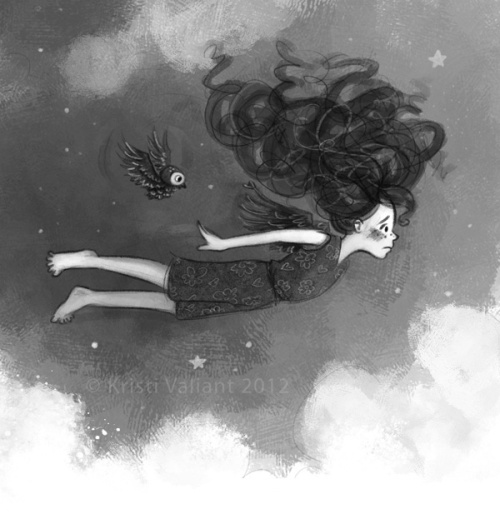
Where does most of your paid work come from?
I focus my time on my books, and I still illustrate black & white line vector drawings for one particular educational publisher.
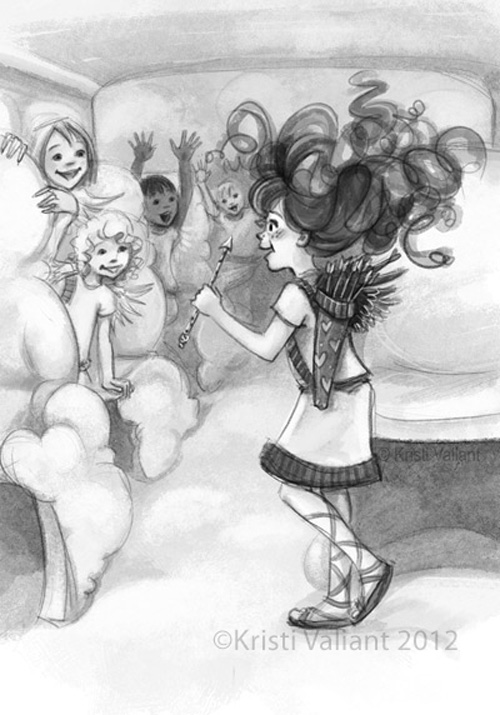
Do you do any marketing on your own to find illustration work?
Not anymore. Before I had an agent I would send sample postcards a few times a year to editors and art directors.
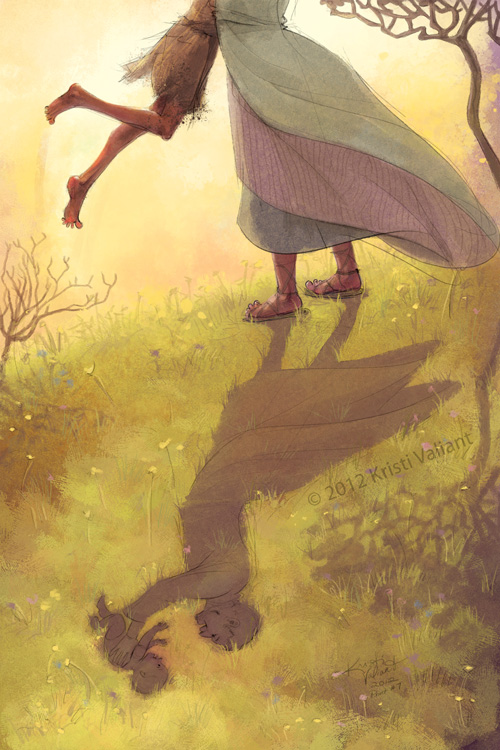
What is your favorite medium to use?
I work all digitally. My book illustrations are done in Adobe Photoshop and my vector drawings are done in Adobe Illustrator.
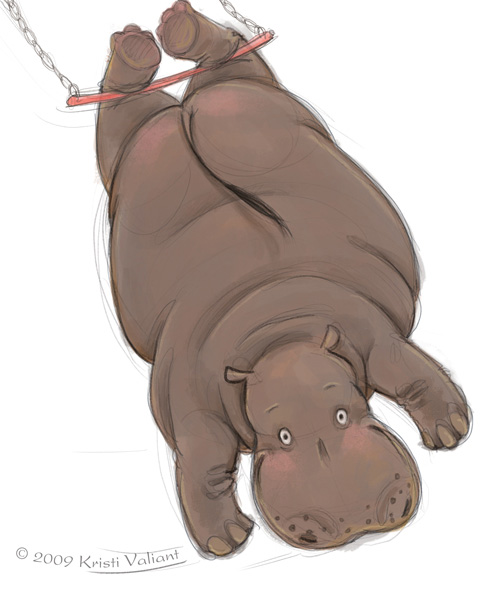
Not counting your paint and brushes, what is the one thing in your studio that you could not live without?
I don’t use paint and brushes except with my kids! I love my Cintiq – it’s a large monitor that I can draw on with a stylus. I also need my large collection of picture books that inspire me.
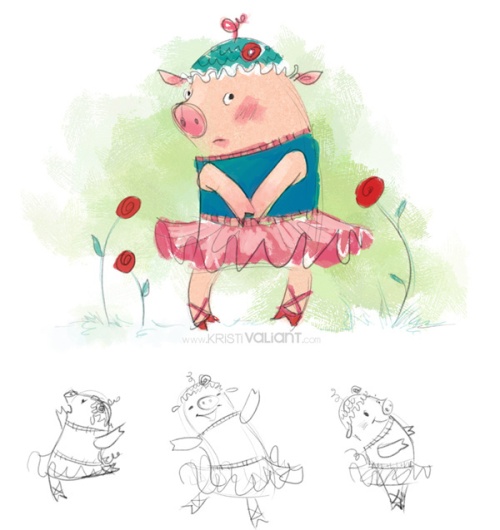
Do you try and spend a certain amount of hours every day working on your art?
I have two little girls, so I need to work quickly while they’re in preschool and childcare or napping. I have deadlines and try to schedule out how fast I need to work to get done in time, but sometimes an illustration doesn’t come together like I want it to and I end up working late into the nights.
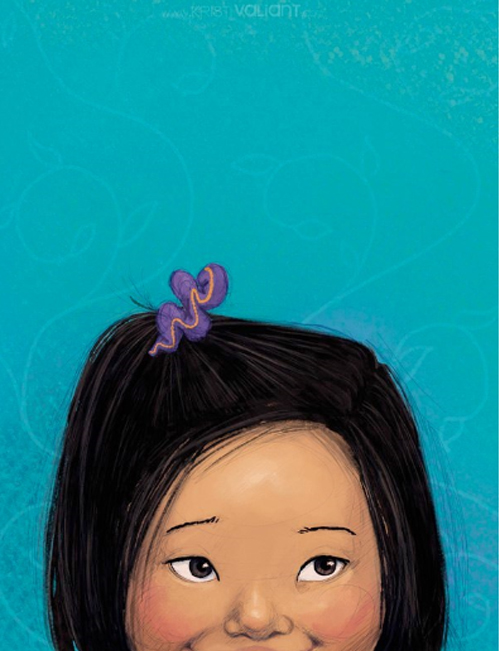
Have you ever won an award for your writing or illustrating?
Recently, I won a regional art show with a Prodigal Son theme in 2012 for my artwork titled “Love That Lifts a Child.” A couple of my books have won awards: THE GOODBYE CANCER GARDEN won 2011 Best English Language Children’s Book at the Sharjah International Book Fair and CORA COOKS PANCIT was the Picture Book Winner of the 2010 Asian/Pacific American Awards for Literature (APALA). I won some illustration contests and one picture book writing contest at SCBWI conferences. I won a marketing grant from SCBWI for PENGUIN CHA-CHA.
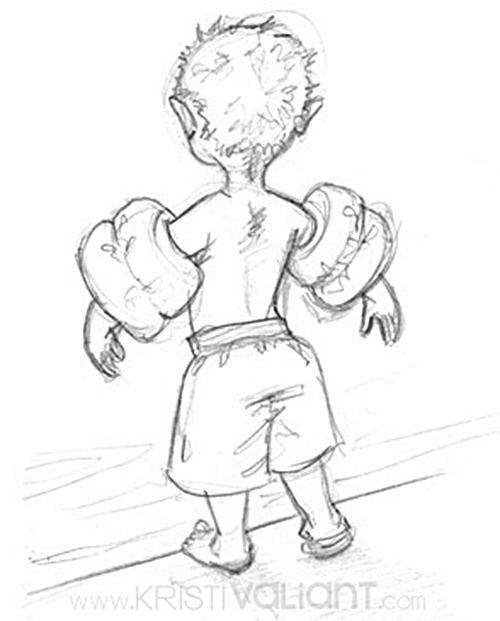
Do you take pictures or do any research before you start a project?
It depends on the project as to how much research or photos are required. Right now I’m illustrating a book that takes place in Paris, so of course, I HAD to visit Paris with my husband and try out all the pastries… I mean take lots of photos for visual reference, since there are tiny visual details, like electrical outlets, that look different in Paris than here. For CORA COOKS PANCIT, I definitely had to research the Filipino culture, try my hand at making Filipino food (yum!) just like the main character, and I took lots of photos of a little Asian girl as a model for Cora. Other books, like my PENGUIN CHA-CHA, didn’t require taking photos, but I have a dance background and was able to move into the dance positions myself in order to feel how to draw them. I usually always collect lots of references of clothes, colors, textures, and perspectives that I want to use in each book as I go.
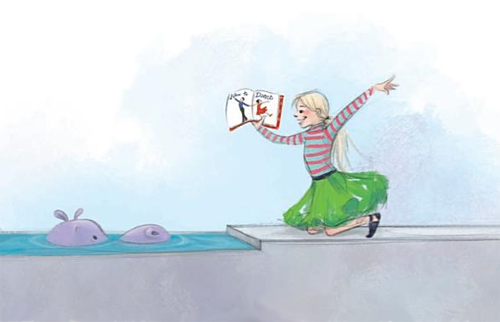
Do you think the Internet has opened doors for you?
Oh yes. My website has brought new clients, and I’m able to research and be inspired so much easier. I recently joined Pinterest and am loving all the fashion pins as I draw a picture book that’s heavy on fashion. I also use the Internet to connect with other writers and illustrators as well as reach new readers. I have a book trailer for my PENGUIN CHA-CHA picture book, and seeing the number of hits it has is fun. Being on blogs like this one is also wonderful!
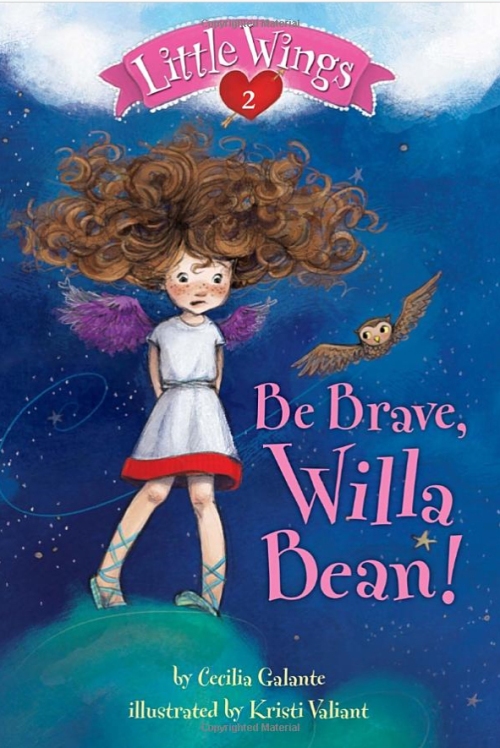
Do you use Photoshop with your illustrations?
Yes, I draw and paint my books entirely in Photoshop!
Do you own or have you ever tried a graphic Drawing Tablet?
Yes, I used to draw with a drawing tablet, but now I only use that when I travel. I use a Cintiq at home. It’s a large monitor that I draw on and is attached to an arm that allows me to turn it easily like you would a piece of paper and bring it right down into my lap to draw comfortably. I love it!
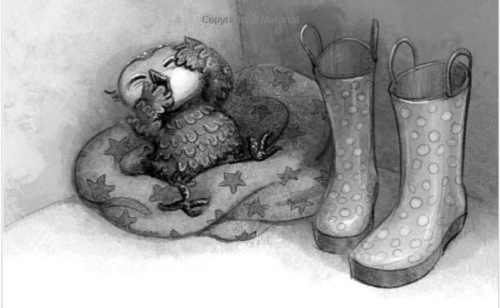
Do you think your style has changed over the years? Have your materials changed?
I used to illustrate educational books, so when I decided to work on breaking into the trade book market, I had to evolve my style to work with that market. I attended SCBWI conferences and had every portfolio critique with an art director in children’s books that I could find. One art director in particular, Laurent Linn, was very helpful at explaining the difference in my illustrations between the educational book look and the trade book look. I still am learning and developing my style. I think I always will. As for materials, in art school I had to learn how to use many mediums. In the educational books I tried out various mediums and styles. But I’ve always been one who enjoys being spontaneous and not planning everything out in the painting first but experimenting as I go. The problem with real paint is that you can’t move things around and resize them in your painting after you paint it. But digitally you can! Digital illustration has come a long way and some of my editors and art directors don’t even realize I work digitally until I tell them.
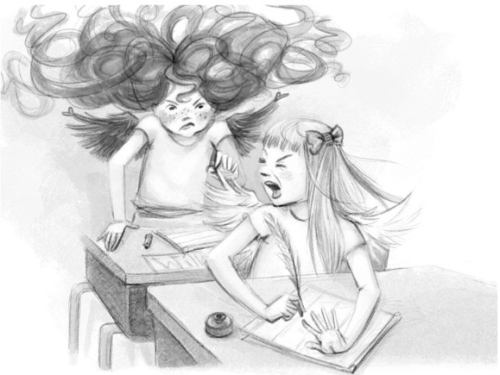
Do you have any career dreams that you want to fulfill?
To continue to write and illustrate my own books as well as illustrate others’ books that I really enjoy. I could say I want to win a Caldecott or something like that, but since that isn’t a goal that I have control over, I’ll stick with really enjoying my own books and hoping that others enjoy them too!
What are you working on now?
I’m illustrating a picture book written by Danielle Steel called PRETTY MINNIE IN PARIS! It’s a lovely book full of fashion, Paris, a teacup Chihuahua, and a stylish little girl. So much fun to illustrate! I visited Danielle and met the real Minnie when I visited Paris, and they were both a delight.

Do you have any material type tips you can share with us? Example: Paint or paper that you love – the best place to buy – a new product that you’ve tried – A how to tip, etc.
Since I illustrate in Photoshop, I would suggest not using the awful pencil tool that comes with Photoshop, but instead create your own or download lots of free Photoshop brushes (search online for Nagel’s or others). Play with the brush settings such as shape dynamics, scattering, texture, etc. It took me years to create a pencil tool that looks and feels like a real pencil, but now I love sketching in Photoshop. Whenever I sketch on real paper with a real pencil, I want to hit the undo button!
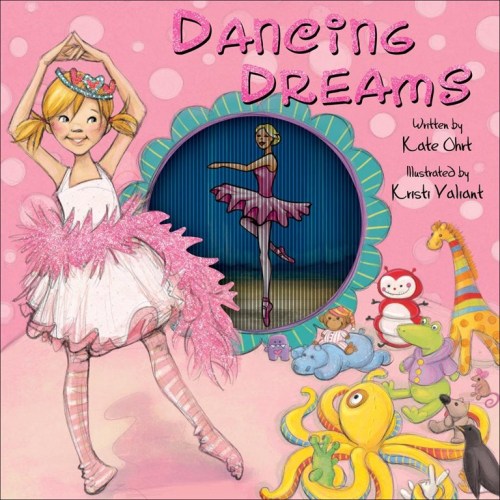
Any words of wisdom on how to become a successful writer or illustrator?
Join SCBWI and volunteer. Meet other writers and illustrators and make friends. If you want to write or illustrate books, you need to read, read, read those books currently being published. Study what’s out there and figure out how to make your mark while staying true to who you are. Find out what makes your face light up – what subjects and themes and characters – and do that kind of work. Love what you’re doing!
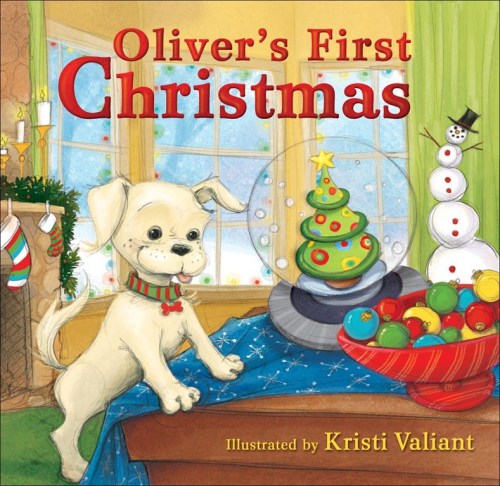
Thank you Kristi for sharing your process and journey with us. Penguin Cha-Cha looks like such a cute picture book. I wish you much success with that and your future books.
You can visit Kristi at the following sites: www.kristivaliant.com – http://kristivaliant.blogspot.com – www.penguinchacha.com - Facebook: https://www.facebook.com/kvaliant – Twitter: https://twitter.com/KristiValiant
Free Penguin Cha-Cha Storytime Activity Kit: http://www.penguinchacha.com/Penguin_Cha-Cha/activities.html
Remember all you have to do is leave a comment for Kristi to receive one entry for your chance to win a signed copy of Penguin Cha-Cha. Hope you help spread the word for Kristi’s debut as author/illustrator.
Talk tomorrow,
Kathy
Filed under:
Advice,
authors and illustrators,
Contest,
How to,
Illustrator's Saturday,
inspiration,
Interview,
Process Tagged:
editor Michael Joosten,
Kristi valiant,
Penguin Cha-Cha,
Random House 

 In June 2012, at the New Jersey SCBWI conference in Princeton, NJ, I had Lionel Bender, cofounder of the U.K. packager Bender Richardson White, and author Sally Isaacs do an intensive workshop on writing. It was there that Lionel approached Isaacs with putting on a Non-fiction conference focused on opportunities for writers in children’s nonfiction publishing.
In June 2012, at the New Jersey SCBWI conference in Princeton, NJ, I had Lionel Bender, cofounder of the U.K. packager Bender Richardson White, and author Sally Isaacs do an intensive workshop on writing. It was there that Lionel approached Isaacs with putting on a Non-fiction conference focused on opportunities for writers in children’s nonfiction publishing.
Lionel Bender, explained his two-fold mission to Publishers Weekly: “There are plenty of conferences that focus on the nuts and bolts of creating your work. That is not the purpose of this conference,” he said. “I want to open people’s eyes to the opportunities nonfiction can provide, and I want attendees to understand the various publishing models that exist.” Since I had promoted this conference on my blog, I thought you would be interested in hearing about the final results.
The conference focus was to attracted a core audience of professionals already working in the field rather than aspiring writers hoping to break in. A major draw was the caliber of the faculty, which included high-ranking staff from Lerner, Pearson, Cobblestone, Highlights, National Geographic Children’s Books, and Time Home Entertainment, as well as highly regarded authors and illustrators.
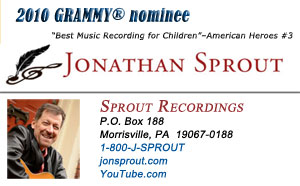 Jonathan Sprout attended and said, “I had a great time. There were, I’m guessing, about a hundred participants, so we all got to know each other in various degrees. Many of the paid participants are successful already-established writers. I made many new friends, including several people who have each written over a hundred books. Faculty and paid attendees mingled often throughout the weekend.
Jonathan Sprout attended and said, “I had a great time. There were, I’m guessing, about a hundred participants, so we all got to know each other in various degrees. Many of the paid participants are successful already-established writers. I made many new friends, including several people who have each written over a hundred books. Faculty and paid attendees mingled often throughout the weekend.
“I learned a lot. There was a good deal of emphasis on technology – apps, eBooks and web presence, as well as submission tips – which I especially appreciated. Strange to say, I don’t believe I saw anyone at the NF conference who had also attended our NJSCBWI conference the weekend before. There was very little, if any, information overlap between the two weekends. Each conference provided its special lessons and friends/contacts.
“When I performed at the faculty dinner at the 2012 NJSCBWI (at your request), Lionel and I discovered a common love for The Beatles (although it was Steve Meltzer that night who played one of the best versions of “Norwegian Wood” I’ve ever heard!) So I was asked to perform a song from my forthcoming album the first night of the NF conference. I’ve already committed to returning to the June 2014 NF conference (same location: New Paltz, NY). In anticipation, Lionel and I are sketching out a couple of Beatle melodies that I may perform to a new set of “nonfiction lyrics” that promise to be very funny.”
Faculty member Roxie Munro, author-illustrator of more than 35 books said, “There are other conferences that have a lot to offer beginners, but this one was much better for midlist writers; it was more meaty, more sophisticated.”
Lionel said in his opening, “I see the digital revolution as an opportunity to reinvent kids’ illustrated nonfiction. And the icing on the cake is the Common Core standards, which are making nonfiction important, and making nonfiction writers finally feel like fiction’s equals.”
Science writer, Melissa Stewart said,“There is a revolution going on in nonfiction right now. In this climate, the role of nonfiction is to delight as well as to inform.”
One of the weekend’s highlights was Saturday afternoon’s publishers panel, in which seven faculty members discussed The Future of Children’s Nonfiction. Responding in turn to questions posed by Bender in advance, each panelist offered insight into their company’s approach to the challenges of modern publishing today. Andy Boyles, science editor at Highlights magazine, said he foresees Highlights remaining “ink on paper for the foreseeable future.” But, he added, “Ink and digital can play nicely in the same sandbox. The big question is: How can you make digital pay the bills?” Participants echoed this question throughout the weekend.
Robin Terry Brown, senior editor at National Geographic Children’s Books, described her company’s “sneak-attack approach to learning – draw them in with high-interest topics, vibrant photography, and design” - and shared its formula: “photos, facts, and fun—and all things animal.”
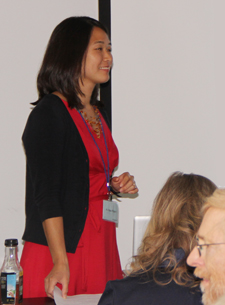 Alyssa Mito Pusey, senior editor at Charlesbridge said, “Nonfiction has always been our core, but as far as our digital strategy the goal is to put its books onto as many platforms as possible. Intellectual property will become king as publishers seek to engage their audience through transmedia storytelling. Print will become a single star in this constellation. Digital is fun, but print is not dead.”
Alyssa Mito Pusey, senior editor at Charlesbridge said, “Nonfiction has always been our core, but as far as our digital strategy the goal is to put its books onto as many platforms as possible. Intellectual property will become king as publishers seek to engage their audience through transmedia storytelling. Print will become a single star in this constellation. Digital is fun, but print is not dead.”
Click this link to read about it in Publishers Weekly.
Talk tomorrow,
Kathy
Filed under:
authors and illustrators,
Conferences and Workshops,
How to,
inspiration Tagged:
Bender Richarsdon White,
Children's Non Fiction Conference,
Lionel Bender,
Recap 


By: Kathy Temean,
on 6/21/2013
Blog:
Writing and Illustrating
(
Login to Add to MyJacketFlap)
JacketFlap tags:
Tips,
Process,
illustrating,
Art Director,
authors and illustrators,
How to,
Conan O'Brien,
David Letterman,
Illustrator's Saturday,
Jason Kirschner,
Add a tag
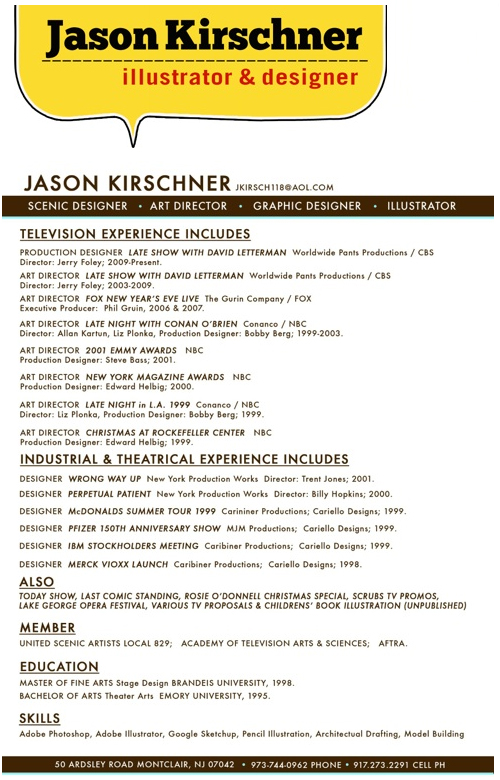
 Jason’s name might sound familiar, since I showed off his winning illustration from the NJSCBWI June Conference the other week. If you read Jason resume above, you will see how successful he has been in his career already. I am sure it is exciting to work around other creative people like he does on the David Letterman Show, but Jason is expanding into the children’s book market and I am sure he will be just as successful with that endeavor. Below you will see Jason’s process, but we start with his answers to my question about how he paints and what materials he uses. Here’s Jason:
Jason’s name might sound familiar, since I showed off his winning illustration from the NJSCBWI June Conference the other week. If you read Jason resume above, you will see how successful he has been in his career already. I am sure it is exciting to work around other creative people like he does on the David Letterman Show, but Jason is expanding into the children’s book market and I am sure he will be just as successful with that endeavor. Below you will see Jason’s process, but we start with his answers to my question about how he paints and what materials he uses. Here’s Jason:
I color everything digitally now and have done so for about a year and a half. I used to use watercolors, colored pencil and prismacolor markers but I’ve eliminated all of that. Digital is quicker and soooooo much easier to revise. You never have to wait for the paint to dry and its all free (after you’ve finished paying for Photoshop, of course).
As for Pencils… Right now I’m in love with Prismacolors. They’re nice and dark when you want a strong line. I also like the fact the line has a little bit of breakup in it. As stupid as it sounds–It keeps my drawing looking hand drawn. Beyond that, I’m also really happy with a nice #2 pencil.
As for paper I will really use anything. I probably should be more particular. I do like Strathmore or Canson sketch or watercolor paper. Honestly though 95% of the time I end up using cheap photocopy paper– 11″x 17″ if its around. The lack of texture is an advantage when I’m using the Photoshop magic wand to isolate different elements drawn on the paper. Truthfully I add whatever textures I want later in the process anyway.
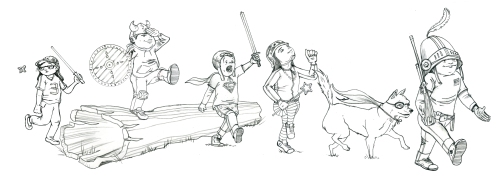
Step 1: After I figured out my idea and did a few rough sketches, I drew finished versions of each character with pencil and scanned each in separately. With each character on a separate layer I played around until I got a composition I liked.
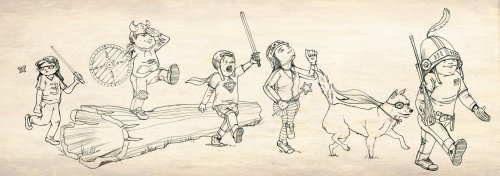
Step 2: If I’m going to use a texture or paper I lay it in right at the beginning. That way I can choose colors accordingly. Here I was going for a classic sort of feeling so I chose an old paper from my texture library and placed it on its own multiply layer above all the pencil sketches.
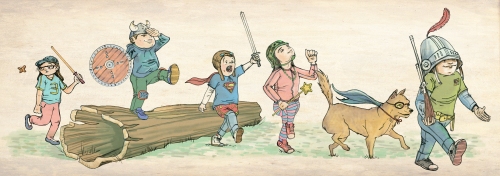
Step 3: Next I lay in the color, also on a multiply layer. For the most part I use solid blocks of color. In some places I start to indicate highlight and shadow but I do most of that in the next step.
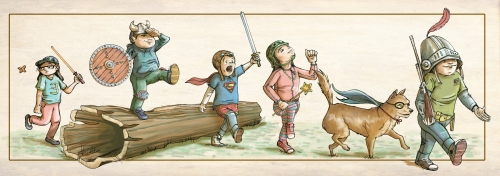
Step 4: Finally, I add a layer for shade and shadows , and one for highlights. This is also the time I’d use any sort of photoshop filters but I mostly avoid them.
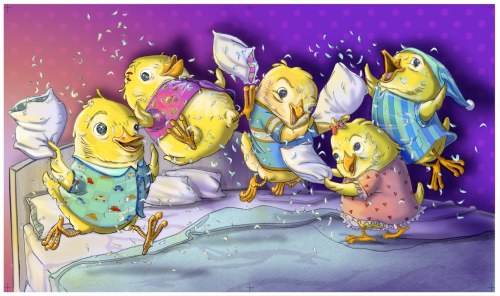
What made you decide to go to Emory University to get a BA in Theatre Arts?
One day someone from the Theater Dept. came in to my high school art class and asked if anyone could paint a giant sunset for South Pacific. I raised my hand and was drafted into service. I loved working on sets in High School.
At Emory I designed and directed theater on the side. I was actually a math/computer science major for most of my time there. I used to go the the computer lab after rehearsals and work until late in the night. One night I was in the computer lab at 3:30am looking for a missing semicolon in 4000 lines of code while sitting between two guys arguing over which Star Trek captain was better – Kirk or Picard. I quit the next morning and declared a theater major.
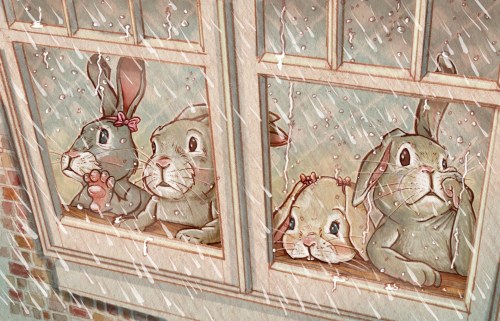
Tell us about how you decided to go for you Master’s in Stage Design at Brandeis University?
I had been designing sets for a few years and I really enjoyed it. It seemed to be a career where I can draw for a living but not be a starving artist. I really liked the program at Brandeis (which is now sadly defunct) and after four years in Atlanta, I missed winters. It was great to have three years to really concentrate on nothing but Theater and sketching and painting.
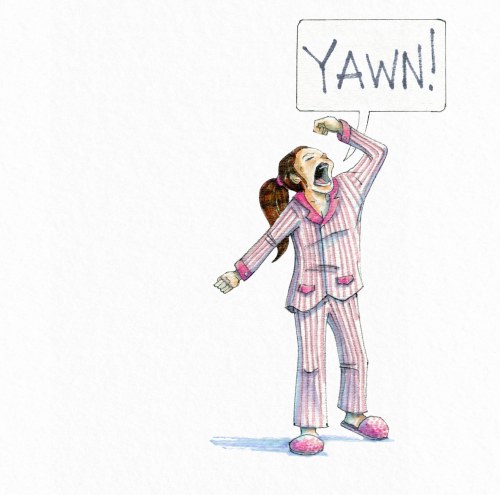
Were you working in the theatre business while getting your master’s?
I did take a few outside design jobs but mostly I designed shows for Brandeis.
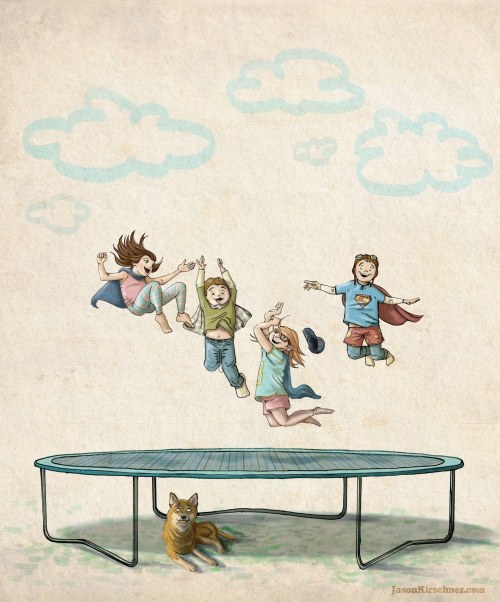
Did any of the contacts you made in college help you get you work?
My grad school contacts not only got me work — they got me my career. A Brandeis alum was working at the Late Show at the time and through him I started a brief internship there while they were designing a new set. That experience was invaluable to me. That credit on my resume helped me get an interview at Late Night with Conan O’Brien right out of grad school. When there was an opening a year later they offered me the job. I really loved my four years there.
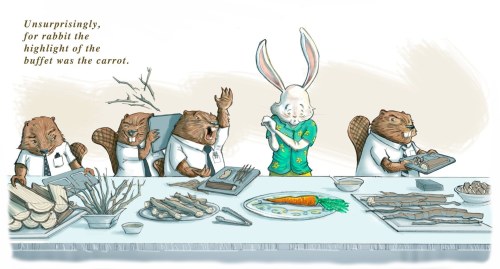
Did that lead to working with the David Letterman Show?
While I was working at Late Night, I would occasionally fill in over at the Late Show. When a position opened up I interviewed and got the job.
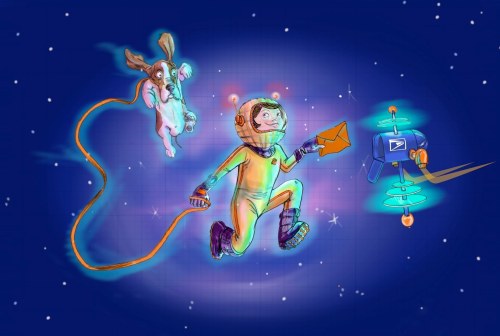
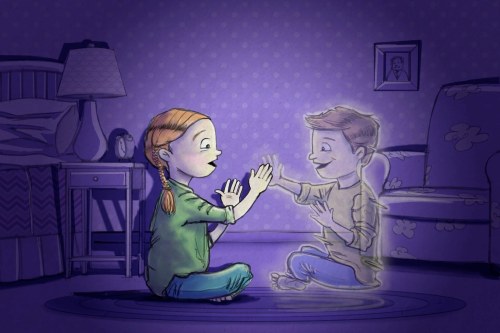
Did you ever take any illustration class?
I’ve honestly never taken an illustration class. I did take figure drawing once in grad school. I’ve always loved drawing but I’m mostly self taught. I’ve got sketchbooks from when I was three or four years old. I started copying Sunday comics and comic books as a little kid and I’ve never stopped. I try to draw every day.
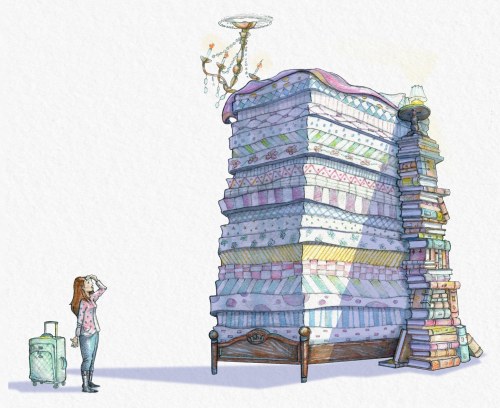
When did you decide that you wanted to try your hand with children’s books?
It’s always something I wanted to try. When my wife and I had our twins and started reading picture books I really wanted to make my own. I started putting together an illustration portfolio which is decidedly different from a scenic design portfolio. I’ve been at if for three years now and I feel I’m growing as an illustrator every day.
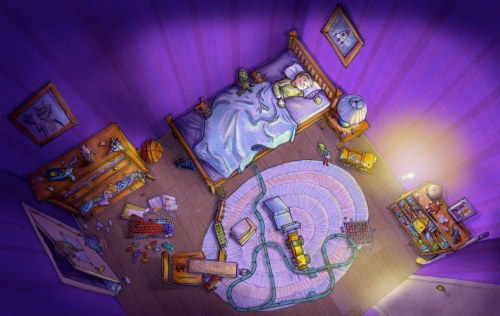
Do you think working in stage and theatre has influenced your children’s style?
The skits we do at the Late Show are usually very short so you only get a few seconds of screen time to set the scene. You have to pick your details wisely to convey setting. I think its a useful skill I draw upon when illustrating. Just like in TV or movies I try to start with a wide establishing shot to set the scene before I go in for close-ups. Lastly, set sketches are always very conscious of the lighting and mood of the scene. I try to bring that into my illustrations as well.

Do you think your style has changed since when you first started?
Definitely. I am always trying to evolve my style while trying to keep my illustrations looking like they’re mine. I find when I stray too far, people say the work doesn’t look like my own. I also really love line work so I am always trying new ways to keep things looking hand drawn.
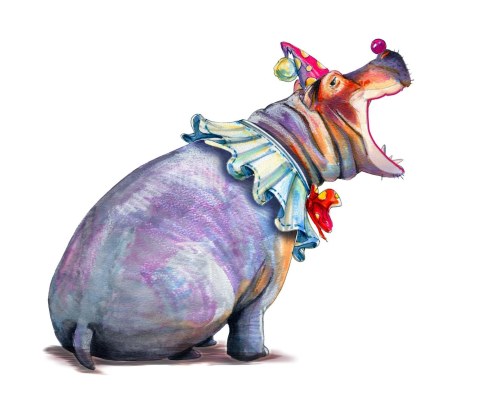
What is your favorite medium to use?
Pencils. Prismacolor Pencils and Photoshop seem to be my preferred method these days. One day I’d love to get back to more conventional mediums like watercolors or colored pencils. Time becomes a huge factor and digital is just quicker. You can revise indefinitely without starting over. Any medium I can walk away from for a while and pick back up whenever is best for me lately.
The way I work now is to hand draw everything –pencil on paper. I try to draw all the elements separately. I scan them in and compose and edit in Photoshop. Then I color it all digitally.
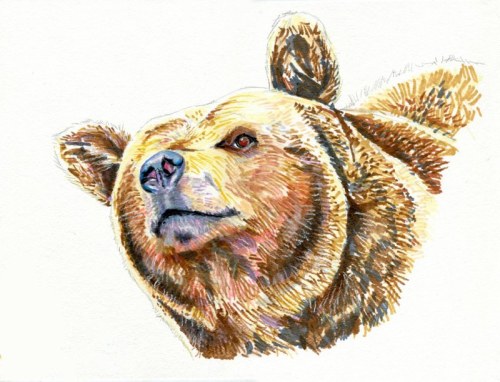
What was the first piece of art that you sold?
I’ve never actually sold anything. Anyone want to buy something?
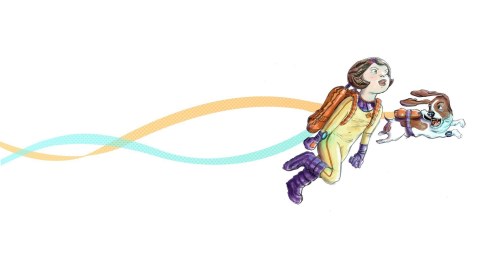
Have you made a picture book dummy to show art directors and editors?
I have! I’ve spent the last ten or eleven months working on a picture book I wrote and illustrated called Monster Nanny. I’m constantly revising and rewriting and redrawing. I actually brought it to the NJ SCBWI conference earlier this month. I got lots of great feedback.
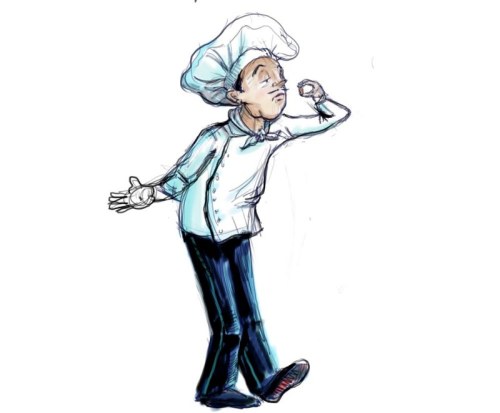
Are you represented by an artist rep.? If so, who? If not, would you like to find one?
No. Not yet. I would love to find some representation. I love the drawing and the writing but I’m new to the business end of it all.
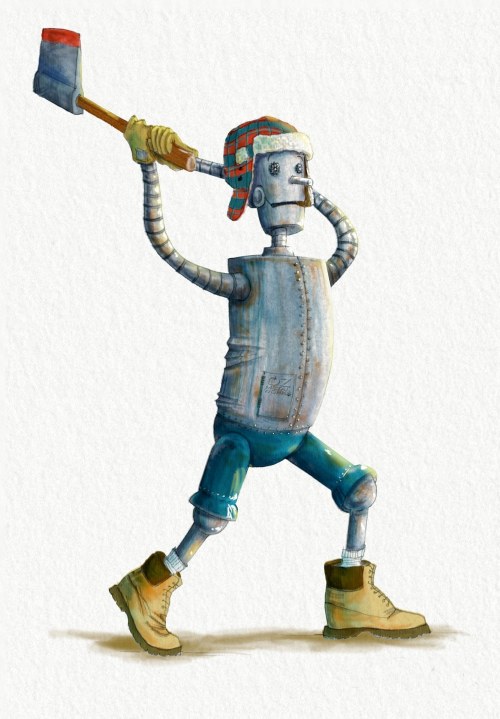
Do you think you will ever write and illustrate your own book?
I really hope so.
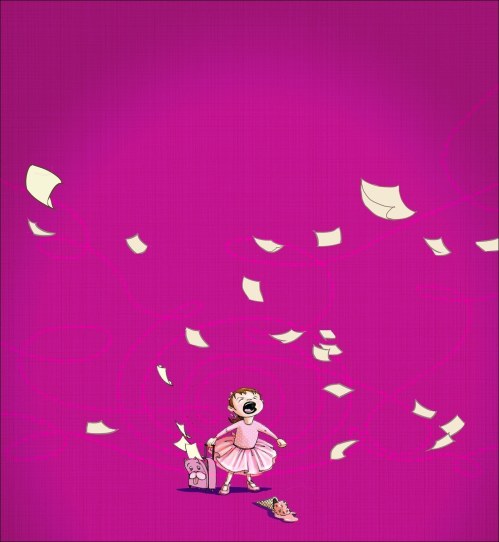
Have you thought of submitting your illustrations to children’s magazines to help get you noticed?
I honestly haven’t but I’m open to any venue that will help me get my work out there.
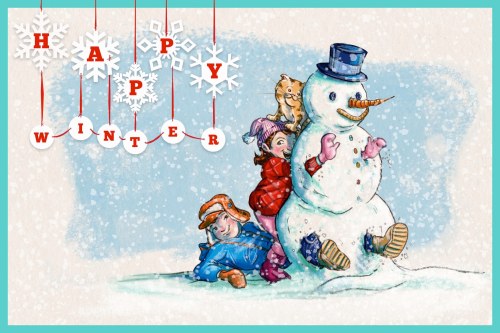
Do you use Photoshop with your illustrations?
YES. All the time. I’ve been using Photoshop for years at my day job and I am constantly finding new ways to speed my process up by using Photoshop. I’ve also started coloring all my illustrations in Photoshop. I’ve also started using 3D modeling programs like Sketchup in the early stages of a drawing to help me figure out composition and perspective. I am also trying to make Corel Painter a part of my process but I’m not there yet.
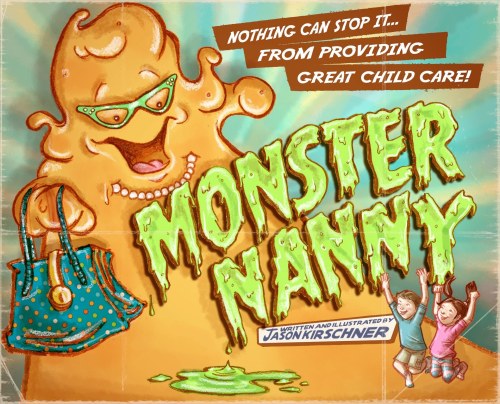
Do you own a graphic tablet?
Yes. Love them. At home I use an Wacom Intuos tablet. At work I recently got a Cintiq which is so cool. In the few months I’ve had it I’ve already starting skipping some of the pencil drawing and doing it directly in Photoshop. Using different virtual brushes, I’m getting better at imitating a pencil line digitally. I can see doing more and more of that in the future.

Do you have a studio in your at home?
I do. It’s a recent addition for me and it makes me so happy. I go up there most nights after dinner and draw. I’ve got a drafting table and a computer station. The only problem is that the office is across the hall from my kids’ bedrooms so no TV or music without earphones.
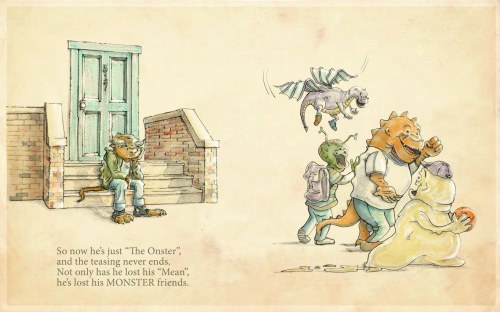
When do you find time to work on the children’s illustration when you are doing The Late Show With David Letterman?
Nights and weekends. I’m always a little sleepy.
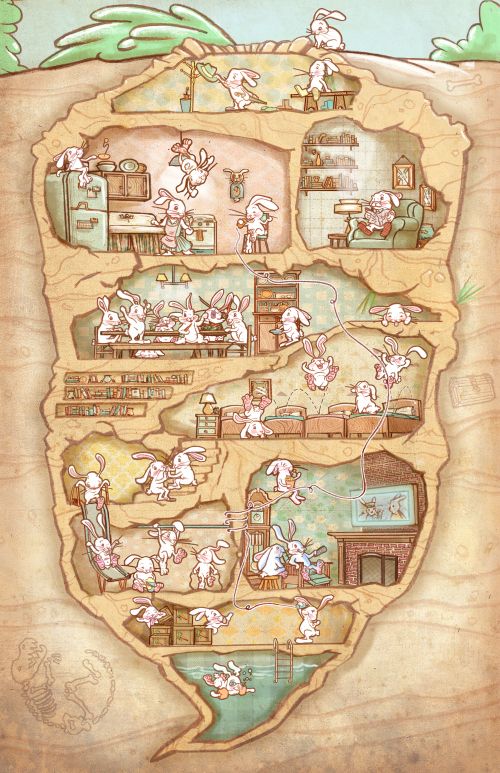
Other than the award you just won at the NJSCBWI Conference for the above illustration, has your artwork won any awards?
Sadly, no.
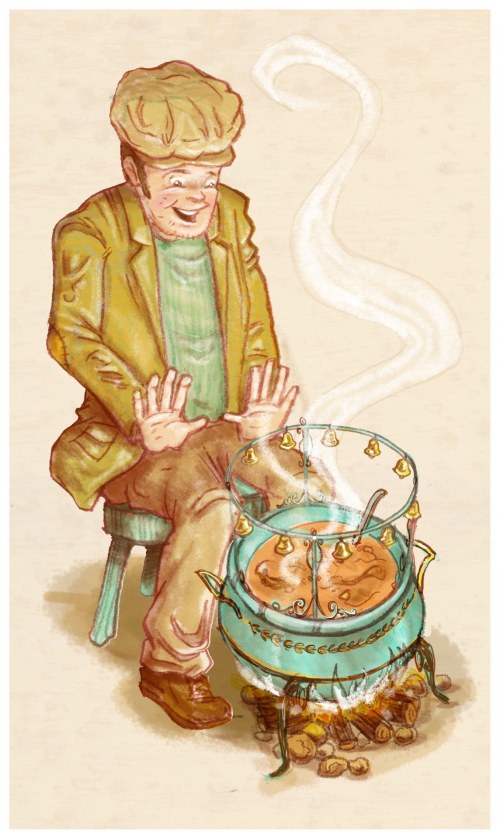
What types of things are you doing to get your work in front of publishers?
Not enough. I’m admittedly not good at selling myself. I’ve sent out a few postcards here and there. I’m working on a new illustration for a bigger postcard mailing in the next few weeks.
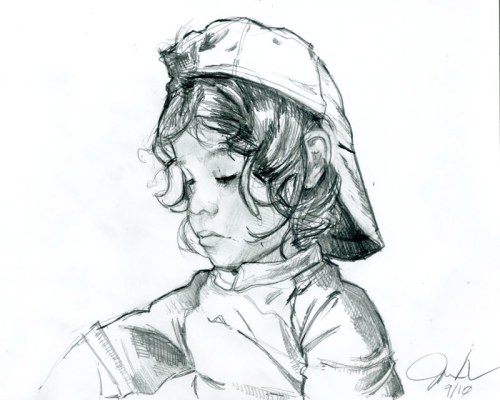
What are your career goals?
I’m pretty happy being the Production Designer for the Late Show.
I love working on the picture books as well. I’d ideally like to write and illustrate my own stuff but I’d be happy drawing someone else’s manuscript too. Maybe I could one day down the road transition to being a full time illustrator. Who knows?
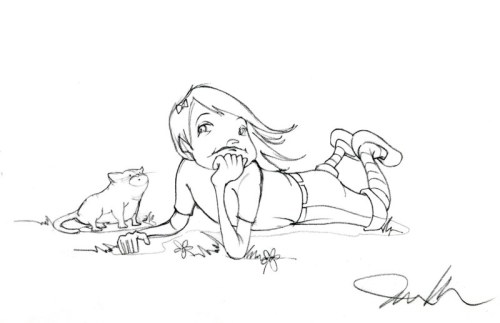
Are there any painting tips (materials,paper, etc.) you can share that work well for you? Technique tips?
I am always reading blogs for these answers! I’m so terrible at knowing what to use. Once in a while I get up the energy to try a different kid of paper or marker or pencil but honesty I’ll draw on anything. More often that not, I draw with prismacolor pencils on cheap photocopy paper. Mostly because I’m lazy. I’m experimenting with drawing in browns and purples instead of black. Its a softer line but it isn’t appropriate for every illustration.
On the digital side, I keep trying to develop techniques that don’t look digital. I’ve been collecting a folder full of older papers and textures that I layer into my illustrations to give them a classic feel. I try to use layers to my advantage. I leave things separated until the end so I can keep playing with composition. I also try to use old school techniques of shadow and highlight, also on separate layers.
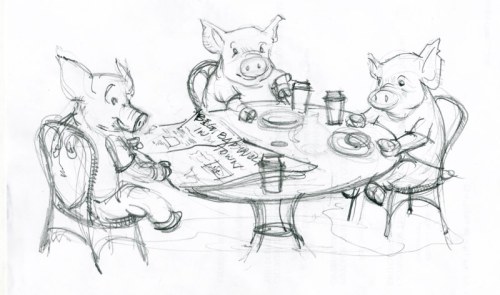
Any words of wisdom you can share with the illustrators who are trying to develop their career?
At this point in my illustration career, I am probably someone who should be taking career wisdom rather than doling it out.
Here’s what I can offer: First — draw every day. I do. I think it takes a while to get into “the zone” where you feel your drawings are worth keeping.
Secondly – I am not a spiritual person at all but I do believe that opportunities find you. You have to do the work and put yourself out there. Opportunity might open a door for you but you do need courage to jump on those opportunities and the skill to back it up.
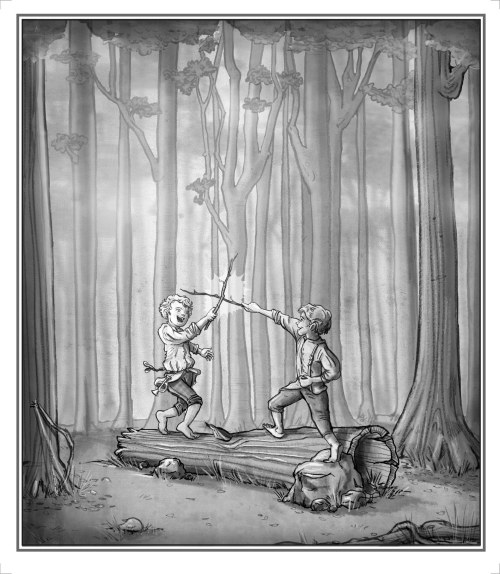
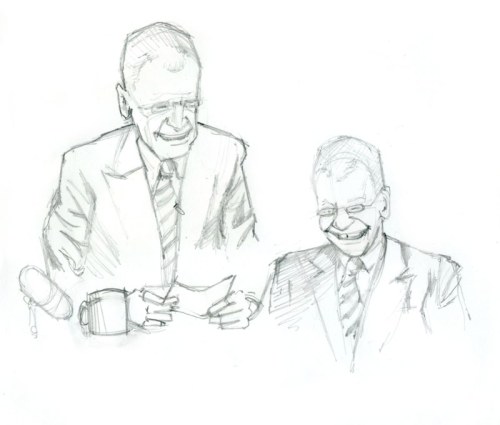
Thank you Jason letting us get to know you and sharing your process. Make sure you keep us updated on all your future successes. If you would like to visit Jason, here is the link to his website: www.jasonkirschner.com
Please take a minute to leave Jason some encouraging comments – Thanks!
Talk tomorrow,
Kathy
Filed under:
authors and illustrators,
How to,
illustrating,
Illustrator's Saturday,
Process,
Tips Tagged:
Art Director,
Conan O'Brien,
David Letterman,
Jason Kirschner 


By: Kathy Temean,
on 6/14/2013
Blog:
Writing and Illustrating
(
Login to Add to MyJacketFlap)
JacketFlap tags:
Graphic Novels,
inspiration,
Advice,
Process,
authors and illustrators,
How to,
Children's Book Illustrator,
Illustrator's Saturday,
Art Center College of Design,
andrea Offermann,
Add a tag
 Andrea Offermann was born in Cologne, Germany, and grew up in the countryside close to the city, in an old horse stable converted to a house, surrounded by a wild garden. During a visit to the US she fell in love with Art Center College of Design and eventually moved to California to study at the school. She graduated in 2005 with a BFA in Illustration, and stayed for another year to work as an illustrator and fine artist.
Andrea Offermann was born in Cologne, Germany, and grew up in the countryside close to the city, in an old horse stable converted to a house, surrounded by a wild garden. During a visit to the US she fell in love with Art Center College of Design and eventually moved to California to study at the school. She graduated in 2005 with a BFA in Illustration, and stayed for another year to work as an illustrator and fine artist.
At Art Center, she had the chance to take several print making classes and fell in love with the different techniques, especially the intaglio technique of drawing with needles and then etching the line into the surface. Later she took further intaglio classes at a printmaking school in Italy, and the love of line work has influenced my style very much since.
In spring 2006 Andrea moved back to Germany and is now living in Hamburg and exploring different areas of illustration such as children’s books, graphic novels and editorial work, while maintaining a close connection to fine art. Her work has appeared in numerous publications such as Society of Illustrators, American Illustration, 3×3, Illustration Now!. Her illustrations were chosen for the Bologna children’s book fair exhibition and in spring of 2013 my portfolio received the Grand Prize at the showcase of the SCBWI winter conference in New York.

Andrea’s work space. Here is Andrea and her process:

Inspiration:
In this case the inspiration for the art was more literal than usual. I had seen a beautiful exhibition with art work by Dürer and fell in love with his wedding portraits. I wanted to do wedding portraits of a frog and a hare.

Thumbnail:
My thumbnails are always tiny and really just convey the idea of what I would like to do, with very very rough direction and composition.

Sketch:
I then scan the thumbnail in and print it out enlarged, then take it to my light box to trace the rough composition and then build the more refined sketch on top of it.

Line:
I scan the final sketch in and print it out, then use charcoal paper to transfer the drawing onto stretched watercolor paper. The charcoal line from the transfer paper is usually very dark, so I erase most of it away until I have a faint line left. Then, using copic multiliner pens or pen and ink, I draw the final image.
Painting:
When the drawing is finished I paint with watercolors on top of it. I paint in thin layers and build the color up slowly, adding texture and details bit by bit.

Final Image

How long have you been illustrating?
For about 8 years.

Did you go to school for art?
Yes, I went to Art Center College of Design.

What types of classes did you take?
I went through the regular illustration curriculum, focusing on editorial and book illustration. I was also particularly drawn to classes in printmaking techniques and took classes in intaglio both at Art Center and at Il Bisonte printmaking school in Italy.

Do you think the classes you took in college influenced your style?
Yes, I think especially the printmaking classes influenced my style, also several classes where we experimented with techniques such as glazing and rendering with different media.

Have you seen your style change since when you first started?
Yes definitely. My work was pretty much all over the place when I started, I was trying different things to see what would work best for a given assignment. Now I think a style has evolved, and I hope it will keep evolving, I keep trying new things and am hoping to be able to continue experimenting.

What is your favorite medium to use?
I love to work with pen and ink and then color with different media. Lately I have also started using paper silhouette.

Did any of the contacts you made in college help you get your first job or any contract?
Yes fellow illustrators at school brought me in contact with editors they had met with and eventually I got my first book contract in the US through one of those contacts. Also I was introduced to the gallery where I first showed my art at through illustrator friends.
The school itself had also set up some meetings with publishers and companies before graduation, and one of my first jobs also came through those meetings.

What was the first piece of art that you sold?
It was a series of intaglio prints titled “Magellan”.

Has your artwork won any awards?
Yes, most recently my portfolio won the showcase at the SCBWI winter conference in New York. My artwork was also chosen for the Bologna childrens book fair exhibit, has appeared in the books of Society of Illustrators, American Illustration, 3×3, Illustration Now!, won 1st place of the AltPick awards, and was on the shortlist of the competition to illustrate “Life of Pi”.

What book was your first? When was that?
The first book I illustrated was a picture book for German publisher “Carlsen” entitled “Keine Angst vor Schafen”, written by Will Gmehling. The book was published in 2008.

How did the contract come about?
I had met with an editor of Carlsen publishing at the Frankfrut book fair in 2006. Many European publishers make appointments with illustrators at the Frankfurt book fair, there are even open portfolio reviews where you can stand in line and show your work. After the fair the editor contacted me to ask if I would be interested in illustrating a picture book for Carlsen.

How did you get chosen to do the cover for the middle grade novel, The Boneshaker?
A designer I had met with had kept my postcard of “Pink Elephants” from an earlier meeting and when Clarion was looking for an artist to illustrate the cover of “The Boneshaker” she gave the card to the editor of the book.

Did you do any interior art for the book?
Yes, I did 13 black and white interior illustrations for the book.

Do you think you will branch out to doing illustrations for picture books?
Yes, definitely, I love illustrating books for all ages and actually just finished illustrating a picture book for an Austrian publisher (Nilpferd in Residenz), “Der Eisdrache (The Frost Flyer)” written by Troon Harrison, which I already mentioned earlier. This story was a great pleasure to illustrate, after illustrating several books for older children it was fun to work for this kind of book again, I hope I will always be able to maintain a balance between working on different books for different age ranges.

Do you think you will ever write and illustrate your own book?
I have been writing for a little while now and am hoping that I will be able to present my own story ideas sometime in the future.

How did you get the contract to illustrate The Midnight Zoo with Candlewick?
I was contacted by the art buying department who had seen “The Boneshaker” and my illustrations for the competition to illustrate “Life of Pi”. They thought that the sensibility of the illustrations would work well for Sonya Hartnett’s story.

How did Little, Brown, & Company find you for Ghost Knight?
I met with an art director at Little, Brown who saw my portfolio and immediately mentioned that they were looking for an illustrator for Ghost Knight. The author Cornelia Funke had specifically asked for an illustrator that could depict architecture, so I did a sample piece first to show how I would illustrate the cathedral, and both Little, Brown and the author liked the piece.

The same question for The Poisons of Caux: The Shepherd of Weeds with Knopf?
Similar story: I had met with the art director ad showed my portfolio. A year later she contacted me to inquire if I would be available to illustrate the book.

I have heard illustrators complain about how fussy publishers are with the covers of their books. Did you find doing a book cover more challenging?
Publishers definitely take great care when it comes to putting together the cover, since it’s the first thing that the audience will see, and it will be surrounded by other book covers geared towards the same audience, it needs to stand out but work for the audience at the same time. Also, many different departments have a say in what the cover should look like, so the decision making process can take longer then with interior art. It has happened to me that a cover was completely finished and then rejected by the sales department because they decided to go a completely different route, target a slightly older audience, not use illustration at all etc.

Is it harder to get published in the US when you live in Europe?
I think it’s more difficult to introduce your work to the publishers, but once the connection is established I don’t think there are great difficulties, the communication takes place mostly via email, artwork can be sent digitally or via FedEx.

What is the children’s book market like where you live?
The German speaking market is much smaller, publishers are maybe a bit more hesitant, they plan with much smaller print runs, so the advances are smaller too.

Have many languages do you speak?
German and English and tiny bits of French and Italian.

Have you ever visited the USA?
Yes, I studied in California and try to travel to the US about once a year to meet with publishers, go to conferences or show openings.

Have you published any of your illustrations in magazines?
Yes I do editorial illustration every once in a while.

Do you use Photoshop with your illustrations?
I use Photoshop for retouching or making small changes. Also, for magazine illustration and for the two “graphic novel” stories I wrote and illustrated I decided to use mostly digital coloring.

Do you own a graphic tablet?
YES! I love my graphic tablet.

Did you set up a studio in your house?
Up until now I was working from a studio in my apartment, but I will be moving into a shared work space in July.

Do you try to stick to a schedule to get your illustrations done?
Yes definitely. Especially when projects overlap I find it necessary to have a schedule I am working with. It happens often that deadlines are moved around, so it is very important for me to know how much time I will need for certain projects to be able to confirm new dates.

How many books have you published?
10 so far, in September the 11th book, “Der Eisdrache” written by Troon Harrison, will be published.

Have you gone to any of the big conferences for Children’s Illustrators and Writers?
Yes I have attended the summer conference in LA twice and the winter conference in New York twice as well.

What are your career goals?
I would like to keep illustrating stories that are meaningful and that reach audiences all over the world and of all age levels. It would be wonderful to one day be able to write and illustrate my own books. Most of all I want to keep learning and experimenting and growing, and make art and stories that touch audiences.

What are you working on now?
As I said I just finished a picture book for an Austrian publisher. Right now I am finishing up a book cover for a YA novel for a US publisher that I am very excited about, we tried a few interesting things with this cover, I am very much looking forward to seeing it in print. Next I will be illustrating a graphic novel, I am very happy about this new challenge.

Are there any painting tips (materials,paper, etc.) you can share that work well for you? Technique tips?
Hmmm… unfortunately my technique is not very unique, as far as materials go I love using lanaquarelle hot pressed paper and copic multiliners for the line work, for watercolor I use mostly Windsor Newton.

Any words of wisdom you can share with the illustrators who are trying to develop their career?
Stay motivated and patient, keep educating yourself, stay in touch with colleagues and share information. When I started out I had a great critique group of illustrator friends, and it helped me so much to be in touch with them and get critique and motivation, help and ideas through these meetings and talks. Now I feel very lucky to be part of the SCBWI mentorship program and have the opportunity to meet and be in touch with all these fantastic illustrators. Unfortunately travelling to the US is far for me, so I can’t see everybody as much as I would like to. I can only encourage you to look for a crtique group around you and if there is one join it, its such a gift to be able to share your thoughts on your work and learn from each other.


Thank you Andrea for sharing your artwork, journey, and process. I have a lot of people write me to let me know how much they love Illustrator Saturday, exactly because of talented illustrators like you. Please let us know when you have an another book or another success story to share. I will be happy to show if off to let everyone know.
If you would like to visit Andrea, here is her website: http://www.andreaoffermann.com If you like Illustrator Saturday and Andreas work, please take a moment to leave Andrea a comment about her post. It is really appreciated.
Talk tomorrow,
Kathy
Filed under:
Advice,
authors and illustrators,
How to,
Illustrator's Saturday,
inspiration,
Process Tagged:
andrea Offermann,
Art Center College of Design,
Children's Book Illustrator,
Graphic Novels 


By: Kathy Temean,
on 6/5/2013
Blog:
Writing and Illustrating
(
Login to Add to MyJacketFlap)
JacketFlap tags:
SCBWI,
reference,
Advice,
school visits,
article,
How to,
Alexis O'Neill,
demystify,
School Visit Experts,
The Kite That Bridged Two Nations,
Add a tag
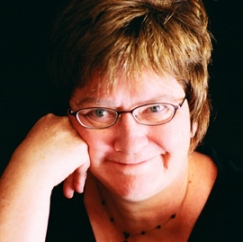 So you have a written and successfully gotten a publisher to offer you a contract. Now is the time to start thinking of how you plan to market your book. One of the first things that comes to mind are school visits, but you could use some help in figuring out how to maneuver that whole avenue. Well, I am going to point you to a great site – School Visits Experts. Once you visit them I am sure you will agree they share great information on there site. It was founded by Alexis O’Neill. You may already know Alexis, since she has been the SCBWI Regional Advisor in California for the last 18 years and has helped so many children’s writers and illustrators. I know everyone who reads the SCBWI Bulletin and everyone on the West Coast knows Alexis, but for those who live in other places, have a stack of SCBWI Bulletins waiting to be read, or haven’t read one of her books, this might be your first encounter with Alexis.
So you have a written and successfully gotten a publisher to offer you a contract. Now is the time to start thinking of how you plan to market your book. One of the first things that comes to mind are school visits, but you could use some help in figuring out how to maneuver that whole avenue. Well, I am going to point you to a great site – School Visits Experts. Once you visit them I am sure you will agree they share great information on there site. It was founded by Alexis O’Neill. You may already know Alexis, since she has been the SCBWI Regional Advisor in California for the last 18 years and has helped so many children’s writers and illustrators. I know everyone who reads the SCBWI Bulletin and everyone on the West Coast knows Alexis, but for those who live in other places, have a stack of SCBWI Bulletins waiting to be read, or haven’t read one of her books, this might be your first encounter with Alexis.
ALEXIS O’NEILL is the author of THE RECESS QUEEN(Scholastic), THE WORST BEST FRIEND (Scholastic), LOUD EMILY (Simon & Schuster), ESTELA’S SWAP (Lee & Low), THREE IRISH TALES (Kindle), and other award-winning picture books as well as a museum education consultant and an instructor for the UCLA Extension Writers’ Program. Her nonfiction works have been published in Spider, Cobblestone, Calliope, Faces, and Odyssey. Her newest book, THE KITE THAT BRIDGED TWO NATIONS: HOMAN WALSH AND THE FIRST NIAGARA SUSPENSION BRIDGE (Calkins Creek Books, September 2013) will be launched this fall at Niagara Falls in both New York and Ontario, Canada. Alexis writes “The Truth About School Visits” column for the SCBWI Bulletin, offering advice to published authors and illustrators on the art and business of doing presentations. www.alexisoneill.com . www.SchoolVisitExperts.com .
She was also the recipient of the California Reading Association’s Dr. Marcus Foster Memorial Award 2010 for making significant and outstanding contributions to reading throughout California. www.californiareads.org
Thought I would share this book trailer for Alexis new book, since I’m always pointing out good trailer, so a little bit will wash off on you and help you down the road. Here is the book trailer for The Kite That Bridged Two Nations — coming September 2013!
Here’s Alexis:

Mistake #1. Opening weakly
Solution: Get attention! Invite the audience in immediately with a startling statement or image, a communal action (singing, chanting, clapping in rhythm) – anything that commands attention and shows the kids that the program is in your capable hands.
Mistake #2. Being unaware of audience reaction
Solution: Learn to “read” the room. Are kids getting restless? Beginning to chat? Turning away from your presentation? Time to switch up the content or pace and get them refocused.
Mistake #3. Speaking too softly, quickly or monotonously
Solution: Practice breathing, projecting, slowing the pace and speaking with lots of expression. Even if you think you have a voice like a foghorn, it will sound strained to those in the back of the multipurpose room. Be sure to use a microphone. And don’t talk to the screen or easel – face your audience.
Mistake #4. Using visuals or props that are hard to see
Solution: Aim for the kids in the back of the room. Make props oversize. Be sure everyone has a clear view of your props and the screen.
Mistake #5: Going overtime
Solution: Appoint a timekeeper to give you warnings at 10 minutes, 5 minutes and the end. Keep your eye on the clock so that you can adjust your pacing.
Mistake #6. Failing to create an ending with impact or with a call to action
Solution: If you like to incorporate a Q & A into your assembly, don’t end with it – place it just before the ending. Wrap up by sending the group out with one last anecdote, a summary of the points you made in your presentation or an appeal for them to do something (Be sure to read! Write! Start a book club!)
SchoolVisitExperts.com is a place for published and soon-to-be-published authors & illustrators to find and share advice on how to create and deliver quality programs for kids, teachers and librarians. This is the place to find guidance on
- Designing meaningful programs
- Managing the business side of school visits
- Getting hired
- Evaluating the impact of your program
- Working effectively with children, teachers, librarians, booksellers, and hosts
The ultimate purpose of SchoolVisitExperts.com is to help you deliver presentations that have a positive, meaningful and motivational benefit for students, teachers, librarians, educational specialists, administrators and parents, increase your visibility and assist you in your quest to secure engagements.
For Advice on how to start looking for a school visit, read this article from Alexis: http://schoolvisitexperts.com/?p=589
Talk tomorrow,
Kathy
Filed under:
Advice,
article,
demystify,
How to,
reference Tagged:
Alexis O'Neill,
SCBWI,
School Visit Experts,
school visits,
The Kite That Bridged Two Nations 


By: Kathy Temean,
on 6/3/2013
Blog:
Writing and Illustrating
(
Login to Add to MyJacketFlap)
JacketFlap tags:
Tips,
Advice,
revisions,
article,
Young Adult Novel,
How to,
need to know,
Lauren Oliver,
demystify,
Lexa Hillyer,
Adding Conflict in your writing,
Inner Demon,
Add a tag
Back in April I had two posts Titled What is a Story Architect’s at Paper Lantern, followed by an article from their writing toolbox about building chapters. Today I bring you another terrific article from Paper Lantern’s Toolbox. You know the information has to be good, when Lexa Hillyer and Lauren Oliver are the ones behind the scenes.
Here are the two links, in case you missed them in April.
http://kathytemean.wordpress.com/2013/04/22/what-is-a-story-architect/
http://kathytemean.wordpress.com/2013/04/23/building-chapters-tips/

In life, most of us avoid conflict. We want to get along and we want everything to go smoothly. However we also know that other people’s conflicts are fantastically interesting. We watch shows called “Desperate Housewives, not “Happy Functional Women.”
This doesn’t make us sadists… it makes us story-lovers. We don’t go to brunch on Sunday to hear about how calm everyone’s Saturday night was—we go to find out about scandals, secrets, surprises, and spectacles. Conflict requires action, and inspires triumph.
Pin this over your desk: NO PAIN, NO GAIN. Both in life and in narrative.
As a fiction-writer, CONFLICT IS YOUR BEST FRIEND. Does this mean your characters should always be throwing half-finished martinis on each other’s dresses, staging battles, or balling their fists and shouting to the heavens? No, of course not.
The whole notion of conflict is to give characters an issue to resolve, aka, to give them a trajectory, a goal, a forward motion of some kind.
CONFLICT => TENSION => ENERGY => DIRECTION => NARRATIVE.
Why is this such a big deal? Too often, our early drafts of novels are boring !!!!
Ever secretly worry that your story is only interesting to YOU? Well conflict is your cure. As readers, we’re compulsive about conflict—we love it, and the more we get, the more we hungrily read along. “How the heck is she going to get out of this one?!” we exclaim, eagerly flipping the pages.
Though of course there are always exceptions to a rule, most people would prefer to read a completely unoriginal story with great narrative drive than read a fantastically inventive, beautifully written book with no direction or point. How do you ensure your novel is the conflict-filled, compulsively readable kind?
First, examine your novel chapter by chapter. How many beats make things harder for the main character? More specifically, does it get more difficult for the character to achieve her established goal? If not, try out PLL’s five tried and true conflict tricks:
1) ADD STRANGE FRUIT TO FRUITLESS SEARCHES. First draft: Character A asks around for information but comes up with no answers. Change to: Character A does a search and comes up with utterly surprising results that set her on a new course.
(Throw in a curveball that even YOU weren’t expecting!) For instance, a girl searches files for information on her adoptive family. She discovers—gasp—her parents were part of a magical circus. OR she discovers—gasp—her parents are the parents of the boy she loves. She’s in love with her own brother! As you can see, these reveals can pull the plot in extremely different directions
2) ESCAPE ISN’T SO EASY. First draft: Character A narrowly escapes harm. Change to: Character A gets injured, captured, or forced down an unexpected path.
-How can this lead to new plot potential? How will the character get better, what will the injury require him to do next or prevent him from being able to do next? How will he break out of captivity or what will he learn from being held? Where will the unexpected route lead him? Who will he run into there
3) HOLD GRUDGES! First draft: Two characters argue, but come to reconcile their views or agree to disagree. Change to: two characters argue. The disagreement becomes explosive, leading to violence, a drastic measure, or swearing allegiance to a third party.
-How can this open new possibilities for the story? Force the characters to work through the conflict by making more mistakes and truly grappling through the book rather than resolving quickly and cleanly.
4) WE LIKE BIG BUTS AND WE CANNOT LIE. When in doubt, insert a BUT. She tried to sneak in undetected, BUT… She planned to kill him, BUT… She asked him to the dance, BUT.
5) MAKE MISTAKES. Are all the character’s difficulties coming from external forces (bad timing, storms, coincidences, society, other characters’ evil machinations/ villainy) or internal forces/ character-agency (making mistakes, overreacting, wanting something too much, essentially making a dangerous, risky or bad choice)?
-When in doubt, try to use more character-agency to create hurdles. The most interesting problems to solve are the ones we’ve in some way created ourselves!
-A few storms and bad guys are often necessary for good story-telling too, though. 
So go ahead, awaken the Inner Demon/Diva/Desperate housewife. Don’t worry—you’ll get to save your characters in the end… Just don’t let them off the hook before then!
If you are attending the New Jersey SCBWI Conference this weekend, make sure you look for both Lexa and Lauren. They will be there. Since I will be there too, I will report back next week hoping to share some of the information so no one feels left out.
Talk tomorrow,
Kathy
Filed under:
Advice,
article,
demystify,
How to,
need to know,
revisions,
Tips,
Young Adult Novel Tagged:
Adding Conflict in your writing,
Inner Demon,
Lauren Oliver,
Lexa Hillyer 


By: Kathy Temean,
on 5/17/2013
Blog:
Writing and Illustrating
(
Login to Add to MyJacketFlap)
JacketFlap tags:
Tracy Campbell,
Magazines,
Interview,
3-D wood designs,
Interior Design company,
inspiration,
Process,
illustrating,
authors and illustrators,
How to,
Illustrator's Saturday,
How to Paint,
Add a tag
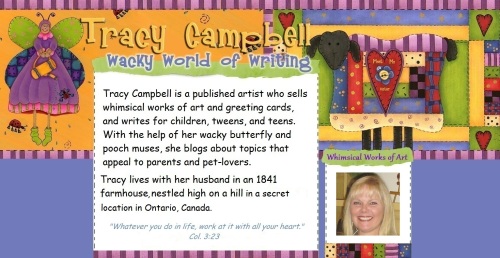 Here is Tracy explaining her process:
Here is Tracy explaining her process:
Below, I’ve included some of the steps I used to draw and paint the “Watermelon Barrette”.
Illustration:
- Draw the design, scan it, and then reduce the drawing to fit the surface.
- Trace the design onto tracing paper.

Paint/Supplies/Brushes:
- DecoArt Americana Acrylics.
- DecoArt Matte Varnish Sealer.
- Krylon Matte Finish Spray.
- Brushes—1/8” and 1/4” Stipplers, #1 and #3 Round, 3/4” Wash, #2, #4, and a #10 Shader, #6 Filbert, and a #10/0 Spotter.
Wood Surface Preparation:
- Sand the wood barrette with 400 grit wet/dry sandpaper.
- Remove the dust with a tack cloth.
- Apply one coat of DecoArt Matte Varnish Sealer.
- Allow to dry, sand, and then wipe clean.
- Paint the background with at least three coats of paint.
- Center the tracing over the barrette.
- Slip the dark blue dress-maker’s paper under the drawing, and then
- Trace the main pattern lines with a stylus and/or a pencil.
Color Worksheet:
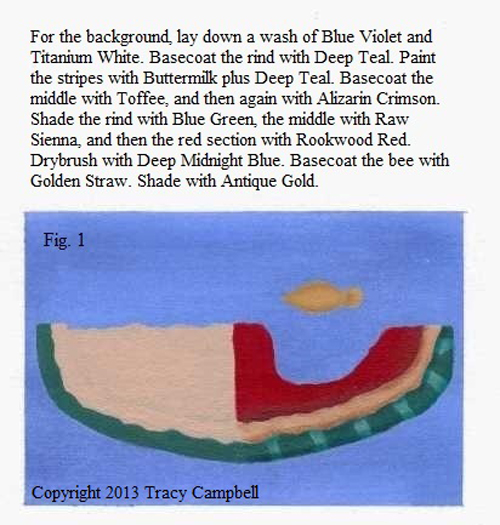
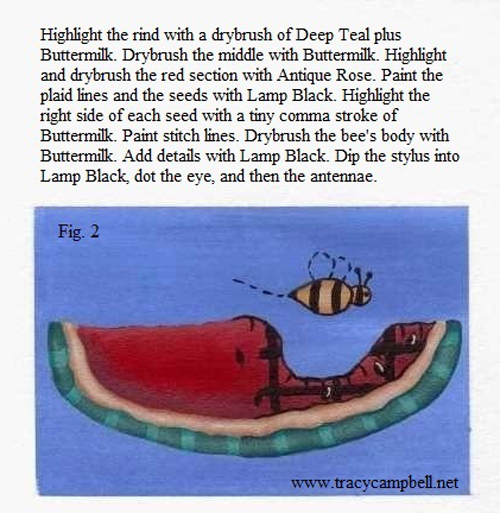 Drybrush Tips:
Drybrush Tips:
- Use a 1/8” Stippler to drybrush small areas.
- Use a 1/4” Stippler to drybrush large areas.
- Dip the brush into the desired paint color.
- In a circular motion, wipe off the excess paint onto an absorbant paper towel.
- In a circular motion, applying slight pressure, begin in the darkest area and move toward the lightest area.
- Follow the above steps until the desired results are achieved.
Finishing Touches:
- Let the piece cure (I wait three days).
- Apply one coat of DecoArt Matte Varnish Sealer.
- Let dry (15 to 30 minutes).
- Lightly sand with a brown paper bag.
- Apply at least three coats of sealer, sanding between each coat.
- Spray with Krylon Matte Finish.
Did you go to school for art?
No, not unless you count the “How to Paint” workshops I signed up for in 1991.
What types of things helped you to develop as an illustrator?
In 1994, a published picture book illustrator encouraged me to draw my own designs. So with shaky fingers, I picked up a pencil and gave it a whirl. And voila! The fabric tree and snow mama was my first design, and I painted it on slate.
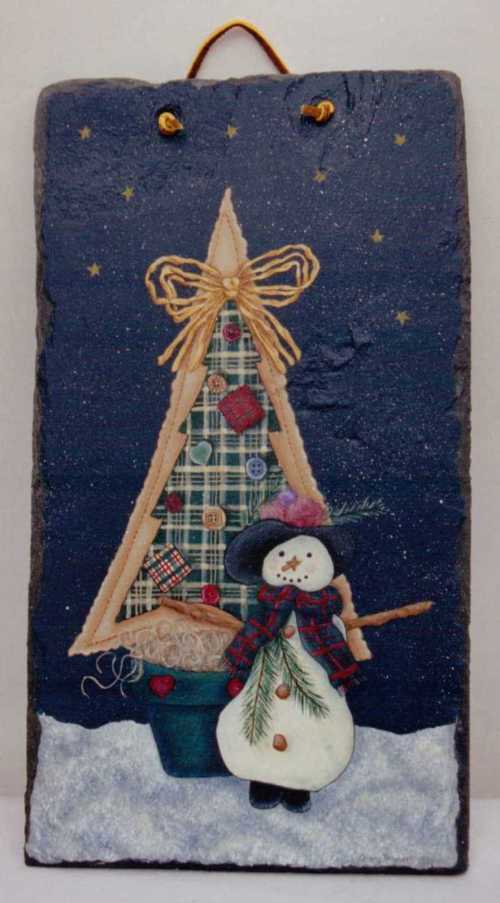
I continued studying “How to Paint” books, and then with three years of drawing and painting practice under my belt, I designed “How to Paint” pattern packets. During that time, I attended a Tuesday morning group for young moms at a local church. The moms loved my designs, and they invited me to teach on Tuesday mornings. One of the designs I taught them, Noah’s Flying Angels, was painted on a wood piece.
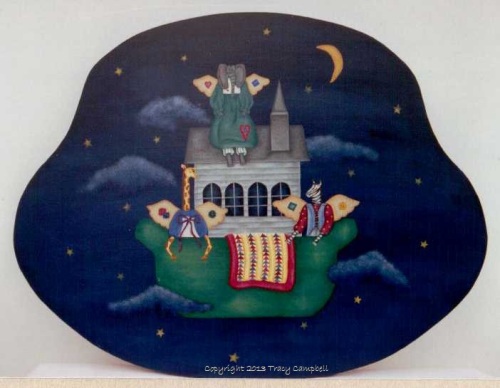
My confidence bloomed like the flowers in my garden, and I decided to sell my expanding portfolio. Without access to the Internet, I packed up my car and traipsed all over Southern Ontario, begging and pleading with store owners to stock my designs on their bulging shelves. Krafty Kennedy’s, a store in London, Ontario, took a chance and purchased my packets. Wait, it gets better. They even asked me to teach workshops. A few years later, I became a “Big Brush” teacher at national painting shows in Toronto and London, Ontario.
Here is a pattern packet design.

What was the first piece of art you did where someone paid you?
A small marketing company hired me to design thirty cards. I recently revamped “Gone Fishing” to create a Father’s Day card.
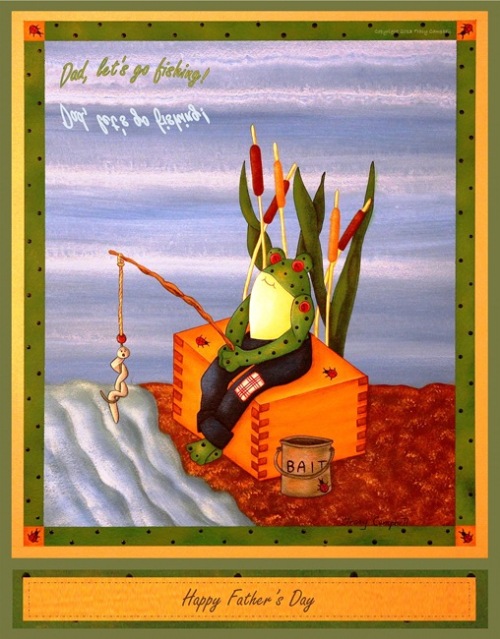
Did you start out doing interior design work?
It wasn’t until 2004 that I received accreditation as an International Design and Decorating Professional. I then obtained my Staging, Color Consulting, and Professional Organizing designations. While I was running my decorating business, QC Design School approached me to tutor students and, later, to facilitate Color and Professional Organizing workshops. I’ve recently cut back on my decorating services to allow more time to pursue my new love…writing.
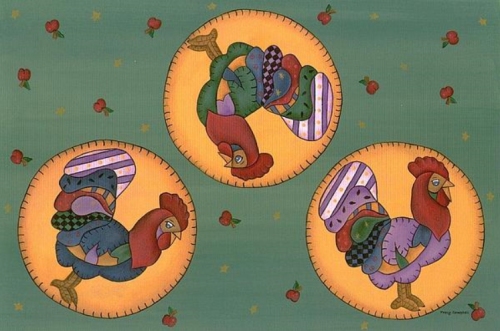
What are your favorite art materials?
Hmm…I don’t really have a favorite. I paint on many surfaces—illustration board, slate, tin, wood, and canvas.
Here is a “Musical Angel” I painted on a CD box.
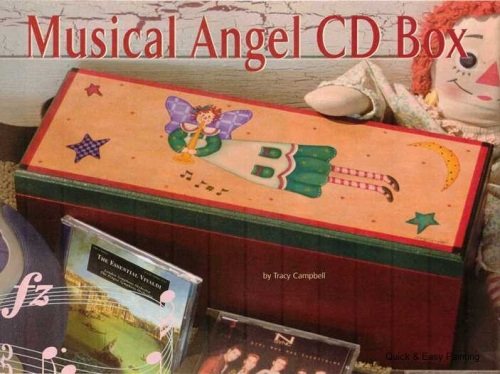
Have those material changed over the years?
Yes, I’ve discovered Copic markers, which I must say are not forgiving. To avoid making mistakes, I test the markers on scrap paper to ensure I choose the correct tint, tones, and shades. The upside, I reduce my painting time in half.
Here is a very rough sketch for the painting below.
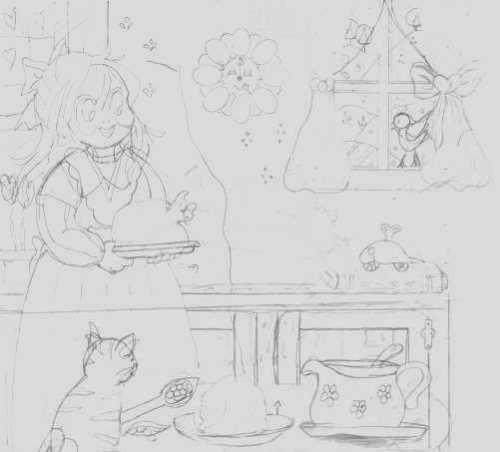 Once the idea takes shape, I redraw each figure, scan it, and then enlarge or reduce each element until I’m happy with the placement. I then transfer the final drawing onto Strathmore WindpowerTM smooth finish, acid free Bristol.
Once the idea takes shape, I redraw each figure, scan it, and then enlarge or reduce each element until I’m happy with the placement. I then transfer the final drawing onto Strathmore WindpowerTM smooth finish, acid free Bristol.
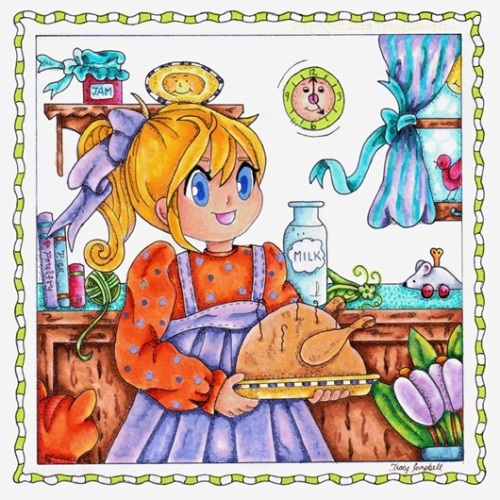
How long have you been illustrating?
I seriously began illustrating in 1994, so that means almost twenty years!
I like your note cards. How did you start creating and selling them?
Thank you, Kathy. Some of my three-dimensional wood designs were the inspiration that lead me to produce a line of square-shaped greeting cards, which I submitted to the Thirteenth Uniquely Ontario Creative Arts Show in Toronto, Ontario. My cards were judged on design, workmanship, promotional materials, and saleability. After receiving a score of 92 out of 100, I was invited to participate in the show that assists in the growth of Ontario’s best home-based entrepreneurs. I was disappointed I didn’t receive 100.
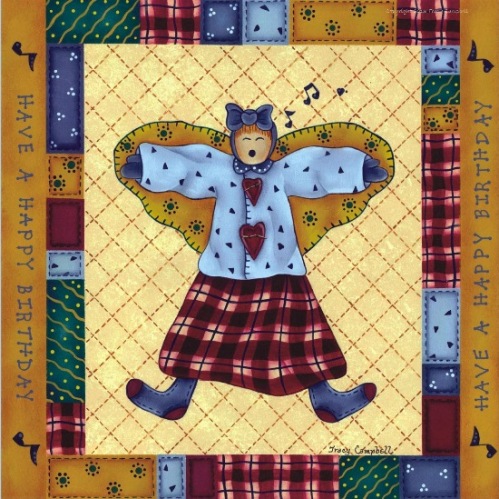

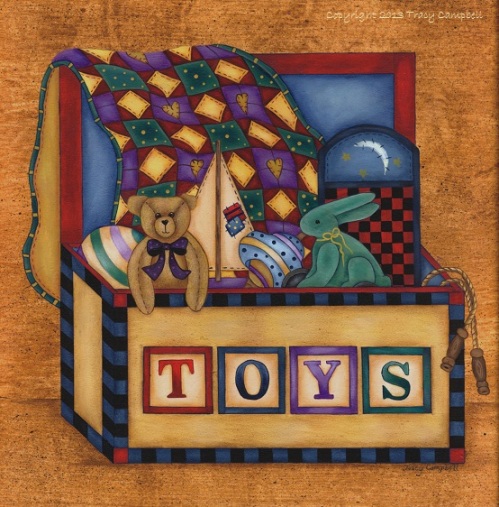
Kathy, I hope you’ll indulge me for a moment. Regal Gifts hired me to create A Country Charm Collection, reproduced on wrapping paper and gift cards.
Here are just four designs.
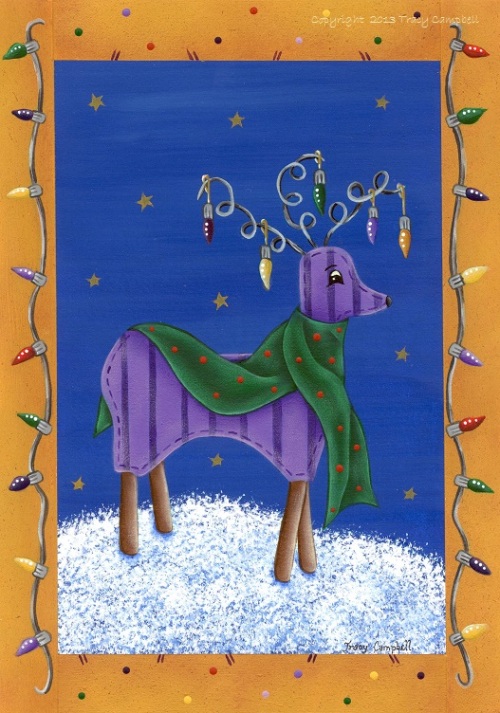

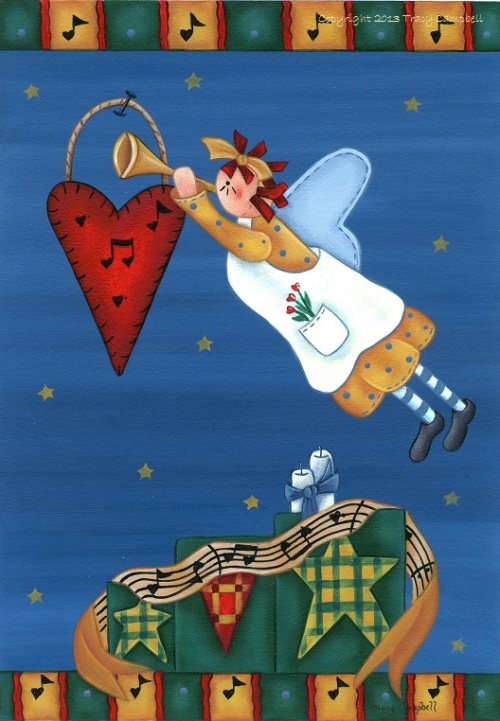
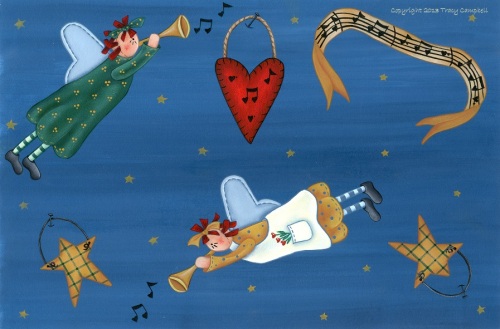 My confidence soared. I queried a well-known calendar company in Markham, Ontario. Rejected, I sulked, unaware God was still at work. A few months later, I received a call. My name had been passed on to Zebra Publishing. They hired me to design a “baby’s first year keepsake” calendar, and the following year, a “twelve-month folk art” calendar. Both calendars sold like hot cakes in mom-and-pop bookstores, Chapter’s bookstores in Canada, and Barnes & Noble in the U.S.
My confidence soared. I queried a well-known calendar company in Markham, Ontario. Rejected, I sulked, unaware God was still at work. A few months later, I received a call. My name had been passed on to Zebra Publishing. They hired me to design a “baby’s first year keepsake” calendar, and the following year, a “twelve-month folk art” calendar. Both calendars sold like hot cakes in mom-and-pop bookstores, Chapter’s bookstores in Canada, and Barnes & Noble in the U.S.
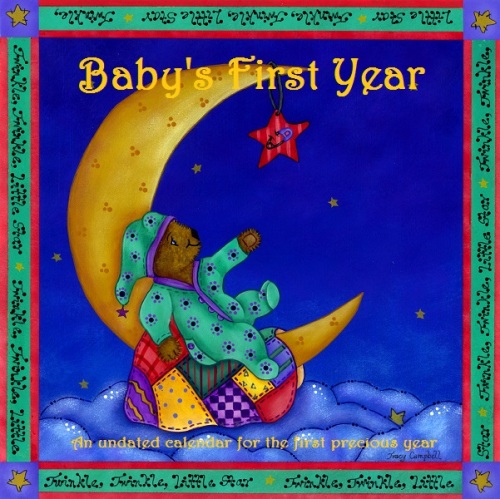
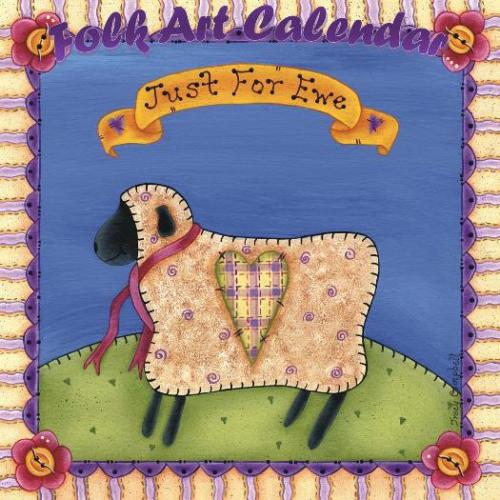
It looks like you have written and illustrated a children’s book. Can you tell us a little bit about the book?
Our Story—You & Me is much more than a children’s book. It’s also a record-keeping book sprinkled with quaint quotes that will appeal to mommies and expectant mommies who want to capture the milestones of their baby’s first year. The book is unique in that it elevates a record-keeping book to an early-reader storybook a mom can read to her child, and uses a child’s natural curiosity about their first year of life to help interest them in reading. In the years to follow, mom and growing child will giggle together, poring over candid photos of things like a toothless grin, wobbly first steps, the ultrasound, and other special moments. This fifty plus page book mirrors my calendar art and will make the perfect baby shower gift.
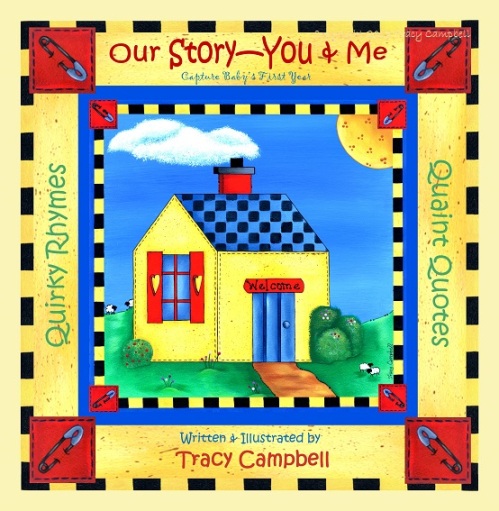
Do you have plans to self-publish?
I’m on the hunt for an agent.
Is illustrating children’s books a new direction for you?
It sure is.
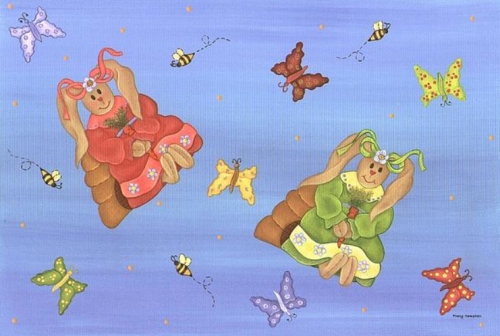 Have you ever illustrated something for a children’s magazine?
Have you ever illustrated something for a children’s magazine?
I haven’t pursued that avenue yet, but I have been published numerous times in American and Canadian “How to Paint” magazines.
Here are two tear sheets.
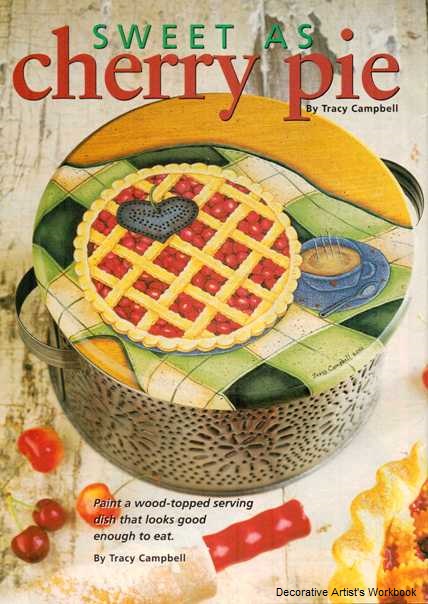
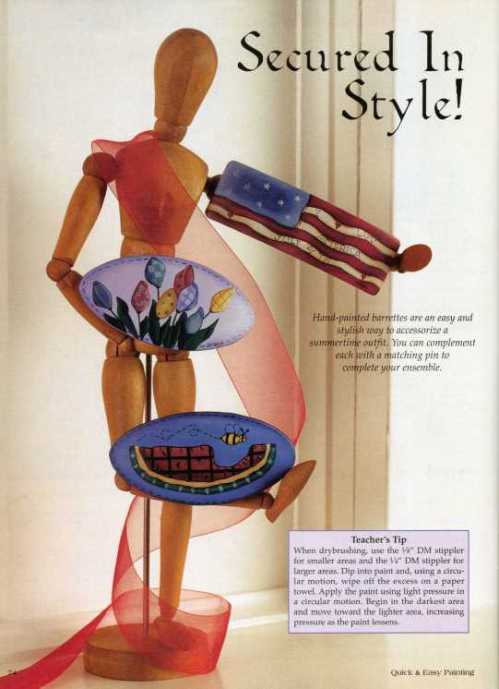
The drawing and painting instructions for the “Musical Angel CD Box” are similar to the “Watermelon Barrette”. Below, I’ve listed the differences.

Additional Supplies:
- DecoArt Walnut Gel Stain.
- Krylon Matte Finish Spray.
CD Box Surface Preparation:
- Prep the box as per the previous instructions, paint the base Napa Red, paint the lid Antique White, and then paint the edge Deep Teal (apply at least three coats of paint).
- Drybrush the Deep Teal area with Blue Green, and again with Deep Teal plus Buttermilk to brighten.
- Apply scotch tape 1/4” from the edge, and then paint the border Country Red.
- Paint corner squares Lamp Black.
- Dilute the gel stain with water, and then apply with a foam brush. Wipe the excess stain with a cotton cloth. Let dry.
- Spatter with Burnt Umber and again with Lamp Black.
- Trace main pattern lines onto the lid.
Color Worksheet 1:
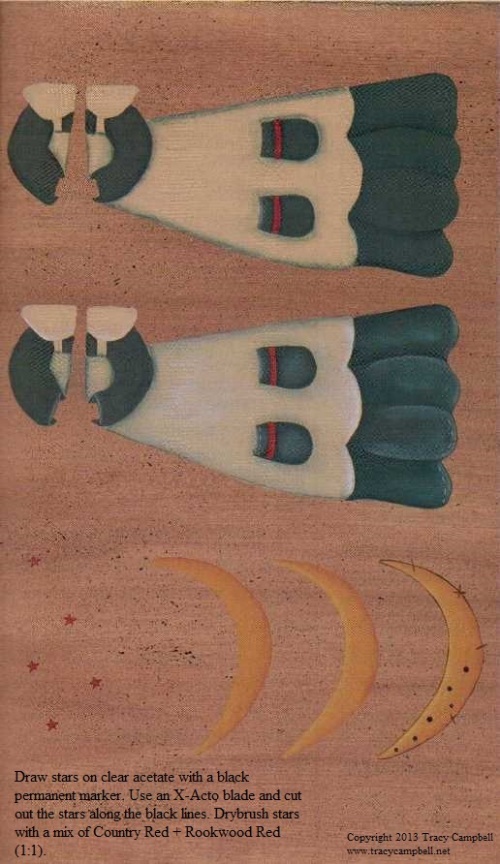
Color Worksheet 2:
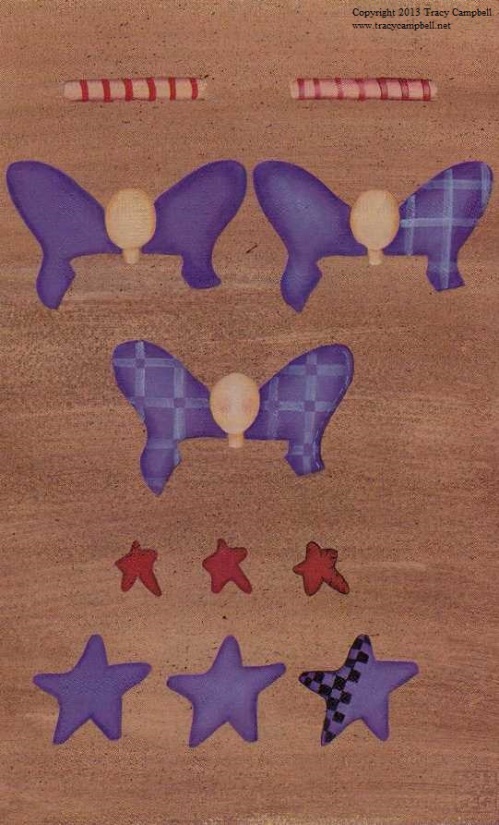
What have you been doing to get your artwork noticed?
I have an online whimsical shop over at http://www.tracycampbell.net/shop.html and a website over at http://www.tracy-campbell.artistwebsites.com, where Fine Art America reproduces my original whimsical works of art on metal, stretched canvas, and acrylic. You can also buy unframed prints or framed prints that are ready to hang on your wall or on a friend’s wall.
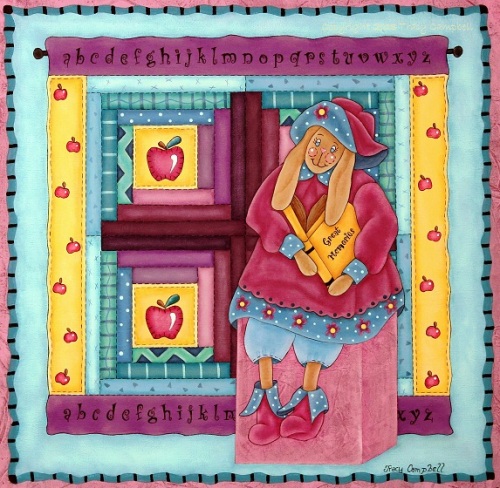
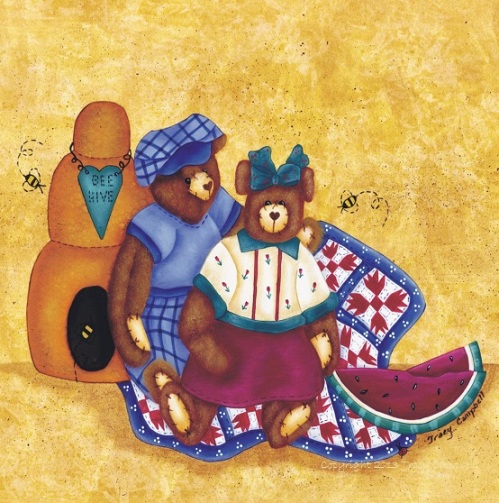
Have you made picture book dummies to show art directors, editors, and reps.?
Not yet.
Do you have an agent?
I’m hard at work querying agents.

Do you ever use two different materials in one illustration?
Not materials per se, but here’s another style where I used a Micron pen and watered down acrylics.
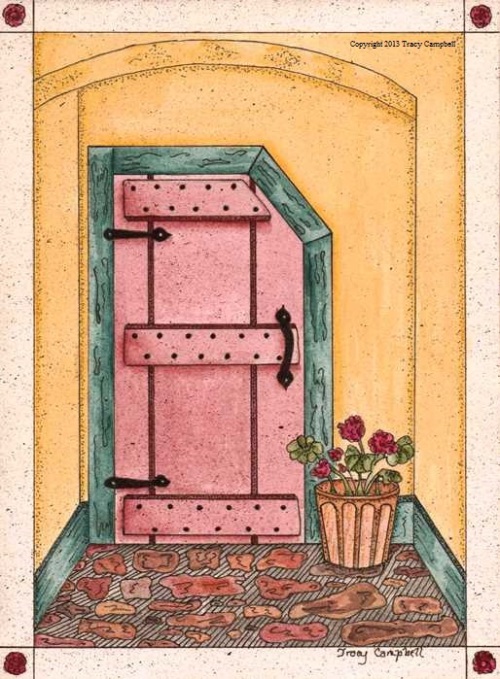
The above piece was painted on illustration board. The process is the same as painting on wood, except I don’t have to prepare the surface. I just transfer the line drawing, ink the design, and then apply watered down acrylics.
I also paint on Paper Mache items.
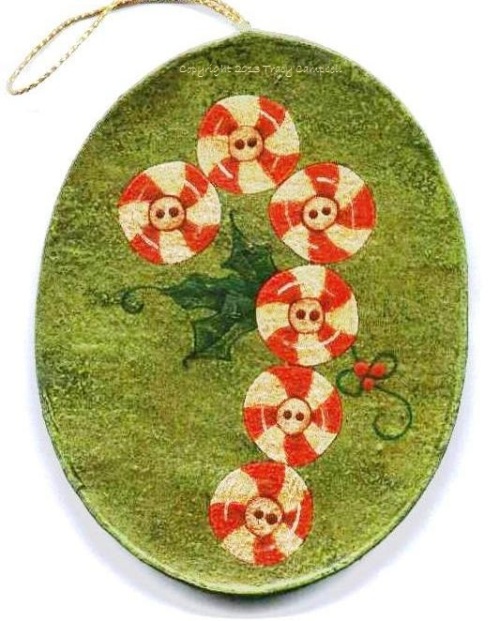
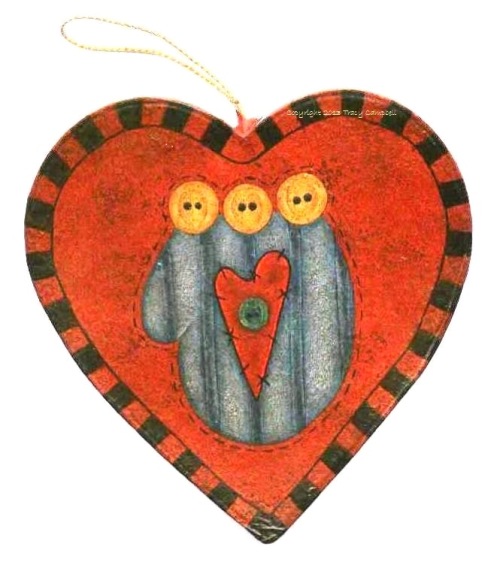
Have you seen your style change since you first started illustrating?
Oh my, yes! My earlier drawings and paintings were stiffer than my ironing board.
 Have you gotten any work through networking?
Have you gotten any work through networking?
Yes, from author extradornaire, Susanna Hill. She purchased designs for her online course—Making Picture Book Magic. Take a peek over at http://www.susannahill.blogspot.ca/p/making-picture-book-magic.html.
Do you do any art exhibits to help get noticed?
Not at present.
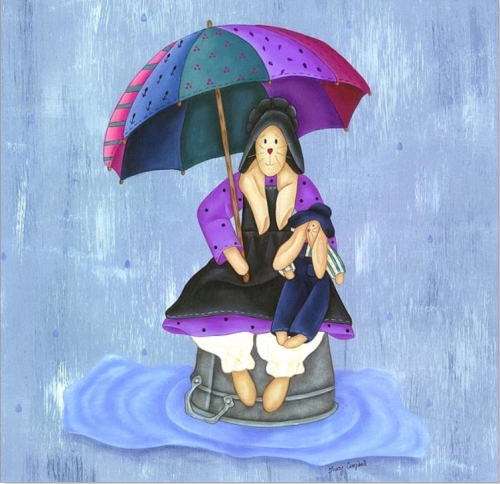 Are you open to doing illustrations for self-published picture book authors?
Are you open to doing illustrations for self-published picture book authors?
Not at the moment. I’d like to concentrate on illustrating my own books.
Do you use Photoshop?
Yikes! I hear the learning curve is steep and I’m not getting any younger. I do scan my artwork, and manipulate my designs with Microsoft Publisher and Paint. Here’s one I reconfigured.
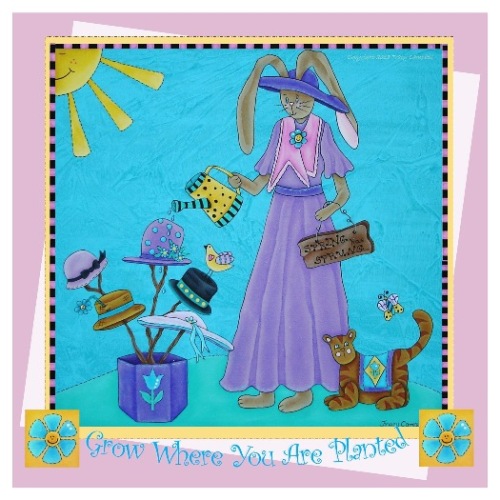
Do you own a graphic tablet? If so, how do you use it?
Unfortunately not.
How much time do you spend illustrating?
Not as much time as I’d like. Some days I work on marketing, other days I write and/or paint.
Do you have a studio set up in your house? Where do you live?
I have a second-floor studio in my 1841 farmhouse, nestled high on a hill in a secret location.

Is there anything in your studio, other than paint and brushes, that you couldn’t live without?
My art and writing reference books.
What are your career goals?
My career goals are to find a literary and/or art agent, finish writing two picture books, polish my middle grade novel, and continue creating art that one day will appear on home décor and giftware items. Lord willing.
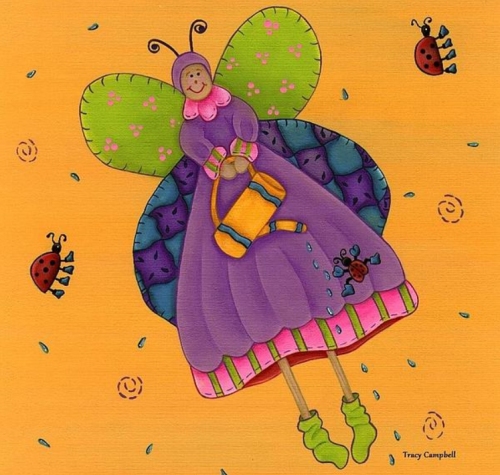 What are you working on now?
What are you working on now?
Besides tutoring, I’m querying agents, blogging, writing a rhyming picture book, and adding art to sell on my website.
Are there any painting tips (materials, paper, etc.) you can share that work well for you? Technique tips?
I love dark blue dress-maker’s paper. I lay my line drawings over the transfer paper, and then I use a stylus to trace the design onto any surface I like. The beauty of this paper is that as soon as you add ink or water—poof—the lines disappear.
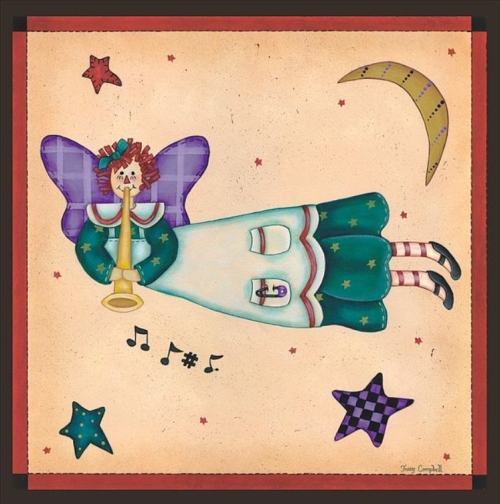
Any words of wisdom you can share with the illustrators who are trying to develop their career?
Don’t be afraid to try new things, step out of your comfort zone. As Will Rogers once said, “If you want to be successful, it’s just this simple: Know what you are doing. Love what you are doing. And believe in what you are doing.”
Thank you Tracy for sharing your artwork and process with us. We will be watching to see how you develop your style to illustrate picture books.
If you want to see more of Tracy’s work or follow her in the future, her website is www.tracycampbell.net. Please take a minute to leave Tracy a comment. It is much appreciated. Thanks!
Talk tomorrow,
Kathy
Filed under:
authors and illustrators,
How to,
illustrating,
Illustrator's Saturday,
inspiration,
Interview,
Process Tagged:
3-D wood designs,
How to Paint,
Interior Design company,
Magazines,
Tracy Campbell 


By: Kathy Temean,
on 4/27/2013
Blog:
Writing and Illustrating
(
Login to Add to MyJacketFlap)
JacketFlap tags:
opportunity,
How to,
Anita Nolan,
Conferences and Workshops,
Intensive Workshop,
June New Jersey SCBWI Conference,
Writing Better Beginnings,
Author,
Writing Tips,
revisions,
Add a tag
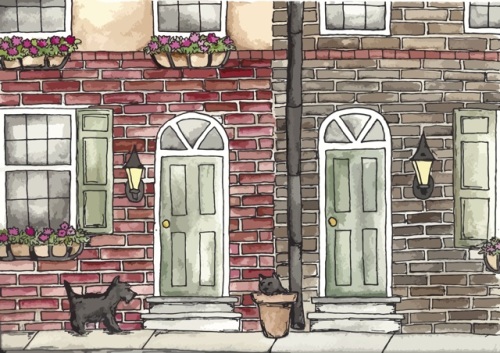
This illustration was sent in by Heather Dent. Since a little girl, Heather’s dream has been to become a professional author and illustrator. Now the time has come to try to make that dream come true. Right now she works for a small business in Berea KY called Attic Light Studios that transfers old videos and photos into digital files and makes movies for special events like weddings, funerals, and anniversaries. Her blog is: http://heatherdentstudio.blogspot.com/.
Anita Nolan is doing a four hour intensive workshop titled, Creating Better Beginnings on June 7th at the New Jersey SCBWI Conference. Here is the description:
It’s vital to make the first pages of your manuscript the best they can be. After all, an editor or agent might read no more than the first few paragraphs before deciding to reject. In this intensive we’ll look at different ways to begin a story and what should be included in the first few pages. We’ll consider what you are revealing about your main character, (and whether it is what you intended!) and whether the character is sympathetic. You’ll rewrite your first paragraphs of your story in this workshop. Bring a printed copy of your first chapter (at least 5 pages, double spaced), paper and pen, (and your laptop if you’d like—laptop is not necessary) highlighter, and be prepared to dig into your first chapter.
I asked Anita if she could share some tips with the writers following my blog. Anita does a great job. You will learn a lot and advance your story if you sign up for her Friday session. Below are a few things from Anita on what a first chapter should accomplish:
As a reader dives into the first chapter, he searches for clues as to what type of story he’s reading. Is it a fantasy? Historical? A fast-paced adventure or a slower-paced coming of age story? Is the voice humorous? Sarcastic? Flowery?
A story’s beginning makes a promise to the reader about what type of story he’s picked up, the pacing, and voice.
Recently I read first pages from one story that promised a fantasy but had no fantastical elements, and from another that had no fantastic elements in the beginning, but the story had an entire secondary fantasy world.
Here are a few things the first chapter should accomplish:
1. Intrigue Reader. Hook them & keep them reading.
2. Introduce either main character/s or theme.
3. Identify what Main character needs/lacks/wants.
4. Identify the obstacles standing in the Main Character’s way.
5. Establish a bond (sympathy) between the reader & Main Character.
6. Present the world in which the story is set.
7. Establish the general tone of the novel.
8. Show Pacing.
9. Show the Voice.
Remember registration ends April 30th at midnight.
Talk tomorrow,
Kathy
Filed under:
Author,
Conferences and Workshops,
How to,
opportunity,
revisions,
Writing Tips Tagged:
Anita Nolan,
Intensive Workshop,
June New Jersey SCBWI Conference,
Writing Better Beginnings 

.png.jpg?picon=4257)
By: Diana Hurwitz,
on 4/26/2013
Blog:
Game On! Creating Character Conflict
(
Login to Add to MyJacketFlap)
JacketFlap tags:
The Other Woman,
ending,
Hank Phillippi Ryan,
Gillian Flynn,
Alafair Burke,
Dark Places,
The Devil's Bones,
The Sound of Broken Glass,
Deborah Crombie,
Never Tell,
Larry D. Sweazy,
writing,
craft,
beginning,
how to,
Add a tag
Opening lines are difficult to craft well. That’s why they should usually be left until the revision layers. Why, you ask? Because you could spend a year of Sundays trying to craft the perfect sentence instead of writing the rest of the manuscript.
Opening sentences are crucial in Chapter One. They give your reader a taste of what is to come. They are worthwhile in the rest of your chapters if you are willing to invest the time. A good opening sentence raises a question or poses a challenge the reader can’t walk away from.
Closing sentences are equally important. They are what keep your readers turning the page to read one more chapter, then another and another until they reach the end. The final chapter’s final line should stick with your reader, offering them one last finger lick of deliciousness to polish off the fiction plate.
Let’s take a look at a few examples from books on my To Be Read pile. Which would you read first?
The Devil’s Bones, Larry D. Sweazy
Opening Line: “Tito Cordova sat on the porch steps, staring at the barren tomato field and empty migrant shacks across the road. Everyone had left for Florida, or Mexico, to spend the winter. He hugged his knees to his chest, trying to keep warm.”
Closing line: “Welcome home, Tito. Welcome home.”
We start with Tito; we end with Tito. The story comes full circle.
Never Tell, Alafair Burke
Opening Line: “It has been twenty years, but at three-fourteen this morning I screamed in my sleep. I probably would not have known I had screamed were it not for the nudge from my husband — my patient, sleep-starved husband, who suspects but can never really know the reasons for his wife’s night terrors, because his wife has never truly explained them.”
Closing Line: “George had said not all questions needed to be answered, but maybe some questions didn’t need to be asked. Maybe she was still getting to know herself after all.”
We begin with an unanswered question and end with the thematic statement that not all questions should be asked.
Dark Places, Gillian Flynn
Opening Line: I have a meanness inside me, real as an organ. Slit me at my belly and it might slide out, meaty and dark, drop on the floor so you could stomp on it.
Closing Line: I didn’t want to meet him, and I didn’t want to introduce myself. I just wanted to be some woman, heading back home to Over There That Way.
We begin with a ghoulish description. The ending sentence probably makes sense once you've read the book. It would have worked better for me if it had also been suitably ghoulish. However, both lines are in the main character's unique voice.
The Sounds of Broken Glass, Deborah Crombie
Opening Line: He sat on the steps of the house in Woodland Road, counting the bank notes he’d stored in the biscuit tin, all that was left of his mum’s wages. Frowning, he counted again. Ten pounds short. Oh, bloody hell. She’d found the new stash and pilfered it again.
Closing Line: He felt as if he were sleepwalking. Slowly he picked up the envelope, lifted the unsealed flap, and eased out a single sheet of paper. It was a letter of transfer. And his chief superintendent had signed it.
This book begins with backstory and ends with a line offering a view into the main character's future. The last line works better for me than the first, though the first line hints at a problem.
The Other Woman, Hank Phillippi Ryan
Opening Line: “Get that light out of my face! And get behind the tape. All of you. Now.'"Detective Jake Brogan pointed his own flashlight at the pack of reporters, its cold glow highlighting one news-greedy face after another in the October darkness.
Closing Line: Jane smiled as she picked up her tote bag. I have a story to cover. “They obviously made a mistake.”
The opening and closing lines are uttered by different characters but reference the eagerness of reporters.
Read through your completed manuscript. Write down the first and last lines of each chapter. Are they intriguing? Can you make them stronger?

By: Kathy Temean,
on 4/22/2013
Blog:
Writing and Illustrating
(
Login to Add to MyJacketFlap)
JacketFlap tags:
Writing Tips,
Process,
Paper Lantern Lit,
Advice,
article,
Lauren Oliver,
Agent Stephen Barbara,
Lexa Hillyer,
Building Chapter Tips,
How to,
Add a tag

Yesterday we talked about Paper Lantern Lit, Lexa Hillyer, Lauren Oliver, who are part of this years NJSCBWI conference and what they were doing with authors, editors, and Stephen Barbara. Today, I thought I would share a great article they wrote to help authors improve their writing. Here it is below:
Chapters are kind of like socks—something we writers and editors use ALL the time, but hardly ever think about. We all know that most novels are anywhere from 40,000 words to 140,000 words long, and we all know they’re broken up into units called “chapters.” But how often do we stop to ask why? How do you know you’re getting the most from a chapter?
We see this challenge in two parts: WHAT goes in the chapter, and HOW it goes in.
Let’s start with the juicy WHAT, first.
Chapters must give good, purposeful content that moves the story forward, that’s what! Unlike socks (ew), a chapter is something you should be able to sink your teeth into and get some real nutrients from it. Let’s consult the magic 8-ball of chapter content questions:
1) What is the main character’s goal in this chapter? How does that goal evolve? (I.e., is the main character thwarted, or does her goal get more urgent?) If there’s no goal, what would make a good goal for the chapter? It should be based on the character’s overall goal in the book! If her goal in the story is to find missing treasure, then perhaps the goal in this chapter is to first dig up the map, or confront the pirate who buried it.
2) What happens in this chapter? Is there action, and does it naturally lead to more action? If not, what new actions might lead to consequences that increase the urgency or difficulty of the goal? (Here’s the thing about goals: we should be making it more and more difficult to get to while simultaneously more and more seemingly necessary.) For instance, perhaps the pirate who buried the treasure has mysteriously vanished, and now your main character must solve the mystery of his disappearance! Or maybe the character’s mother plans to sell her home, and now she needs that treasure more than ever.
3) What new information is learned? (And why now?) If not much is learned, what “clue” might be inserted into this chapter to help set us up for the actions and reveals of future chapters?
4) Does the chapter seem urgent? Does it have tension? If not, what would make everything more pressing, more dire? What might be causing the tension to deflate? Watch out for moments where things are getting easier for the characters, where they seem to be fed the answers. Instead, there can be clues leading them forward, but there should also be obstacles keeping us interested! Remember that you are supposed to be making things more complex and challenging—that’s good narrative!
5) Unity of action. Is the action contained to one location? Does it focus on a single event? Is there a logic to where and why it comes to an end? If you close your eyes, can you easily picture this chapter? Can you describe the action in a sentence? (Think: It was Mrs. White, with the wrench, in the drawing room).
6) Is there causality from one chapter to the next? Remember that the goal in chapter A should lead directly to the goal in chapter B, either linearly (“I had to talk to character M and he told me to go talk to character N”) or because some obstacle encountered in Chapter A redefines the goal in Chapter B (“I got shot at while talking to character M and now I need to go to the hospital, which has replaced talking to character N as my immediate goal.”)
7) Where have we come from? Have the actions, revelations, and emotions of the chapter been properly “seeded” in previous chapters? If not, what would be a few specific places earlier in the book where we might get enough information or “clues” to prepare us for what happens now?
8) Where are we going? What are the elements of this chapter that you’d like to see “pay off” later in the book? In novels, unlike in life, everything must serve a purpose. Even small developments should have some impact on the plot—a.k.a. that development should cause something important to happen later, throw a wrench into the narrative making the goal harder to get to, or aid in a significant reveal later on. Otherwise, it’s simply filler!
Now on to the HOW!
That is, how are we building this baby? What’s the appropriate structure of a chapter? Get ready… we’re about to tell you how to win a game of writing Jenga.
1) Importance of Innies. Is the chapter “in” strong? Does the opening “hook” you from the beginning with a surprising or vivid first sentence/paragraph? Are you peeking around the doorframe or leaping right into the middle of the room? Variety is the key. Experiment with the three A’s of openers: Action, Atmosphere, or Attribution (i.e. dialogue that is quickly attributed to a character). Either start in the middle of a scene with a sound (Splat! The burger hit him in the face), or with vivid description and mood (A dark, feathery form swooped across the fading skyline like a streak of black ink across the gray) or in the midst of a conversation (“How dare you call me selfish! I’m only trying to help you,” Cindy said, raising an eyebrow at me.)
Read the Rest
Talk tomorrow,
Kathy
Filed under:
Advice,
article,
How to,
Process,
Writing Tips Tagged:
Agent Stephen Barbara,
Building Chapter Tips,
Lauren Oliver,
Lexa Hillyer,
Paper Lantern Lit 


By: Kathy Temean,
on 4/12/2013
Blog:
Writing and Illustrating
(
Login to Add to MyJacketFlap)
JacketFlap tags:
How to,
Peachtree Publishers,
demystify,
Illustrator's Saturday,
Brigham Young University,
Manelle Oliphant,
Interview,
picture books,
inspiration,
illustrating,
authors and illustrators,
Add a tag

Manelle graduated with a bachelor’s degree in illustration from Brigham Young University Idaho and has been working as an Illustrator since 2005. She’s illustrated multiple books. Most recently, In the Garden, (spring 2012) In the Woods, (fall 2012) and At the Beach (spring 2013) for Peachtree Publishers.
Some of my other clients include: McGraw-Hill, Friend Magazine, The Empress Theatre, and Blooming Tree Press.
I work with watercolor, prismacolor pencil, pencil, Photoshop, Illustrator, and InDesign.
Manelle says, “My object in writing and illustrating books for children is: to recapture imagination, rekindle curiosity, and demonstrate the rewards of knowledge and virtue. Pretty good eh? I stole it from Walden Media. Regardless I am creating books and illustrations for children with this in mind. Hoping that others will have a chance to have fun, and learn from the products I create.”
Manelle has sent three panels that describe her process, thinking, and interview answers.

Have you always lived in Salt Lake Utah?
Basically, I did go to school in Idaho. I lived in West Yellowstone Montana one summer and I lived in Provo Utah for about a year after college.

How did you go to college to study illustration?
Well, yes, sort of, I went to college to study art. I thought I wanted to be a gallery artist but then I took an illustration class and the rest is history.

What types of classes did you take that really helped you to develop as an illustrator?
Like I said I took this one illustration class… It was intense and really hard. It seems like during the semester I was just exhausted the whole time but it really gave me the tools I needed to be able to draw the kinds of pictures I always wanted to draw. In the end I took that class three times, twice with the same teacher and once with another teacher. I learned so much in all of them.

What did you do after you graduated?
After I graduated I moved to Provo Utah and got a job doing layout for an educational publisher. I liked it there and I sometime I got to do small illustrations. It was fun learning more about Graphic design and layout there. I still use those skills all time.

What was the first thing you did that you got paid to do?
I think it was an illustration for the Friend magazine.

How long have you been illustrating?
Eight years

What materials did you start out using for your illustrations?
Watercolor and pen, and I also did a lot of digital painting at first.

Have those material changed over time?
Yes. I still use watercolor but now I use colored pencil and pencil more than pen. I just use the computer for prep work now, value studies and things like that. I stopped doing digital after I got a few jobs painting that way and realized I didn’t enjoy doing that as much. And sometimes l like to just try something completely different if I can. That is what Ruby and the Skateboard is, a fun style experiment.

Was the artwork for Don’t be Afraid a self-published book project?
No it was for a small Christian publisher. I think the first book job I got. I was pretty excited about it at the time.

How did you get involved with Familius?
It’s a long story. I’ll try to sum up. The Just In Time books were first being published by another publisher and they hired me. But before they were published the authors decided they wanted to go a different rout than that publisher was going so they pulled out. I had already done some sketches and things for them and I really, REALLY, wanted to do them. Luckily the authors, Cheri Earl and Carol Williams, live in Utah and I had met them at some SCBWI conferences, so the next time I saw one of them at a conference I told her how baldly I wanted to do those books. Later I emailed the sketches I had done and she liked them. She said she would suggest me as an illustrator if they found another publisher. Years later they found Familius and Familius hired me. So I think the moral of the story is be patient, and go to conferences, you never know what will happen.

Will there be other Just in Time books coming out?
Yes, 50 are planned, one for each state.

Can you tell us something about Familius?
They are new as of last year (2012). Christopher Robbins the publisher used to be CEO of Gibbs smith. So far they have been good to work with and we’ve enjoyed getting the Just In Time books ready for publication.

Will you be the illustrator for all of them?
That’s the plan.

Did you do any interior art for The Princess and the Pee or was it just the cover?
Yeah, I did an illustration for each chapter.


I see that you just wrote and illustration your own picture book and are selling it on Amazon for $.99. Was it easy to take the book dummy and turn it into an ebook?
It wasn’t too hard. But like I said I had a job doing layout and I took some deign classes in college. I don’t know that it would have been as easy if I didn’t know how to do that. After the layout there is just some mechanical stuff to figure out that takes time but isn’t too hard. Julie Olsen has a nice blog post about how to do that. http://jujubeeillustrations.blogspot.com/2012/01/how-to-create-and-publish-ebook-picture.html

How hard is it to get people to notice your ebook?
I haven’t been good at it yet. Gradually I’m selling more and more and I’ve been trying things here and there to market them. Just learning stuff from people online and trying it. No giant success yet but I kind of enjoy the trying.

Do you plan to produce the book and self publish it, so kids can hold it in their hands?
Not at this point. Both of the ebooks I have out right now were just little things I did for fun and for practice telling stories. I think they will always just be ebooks.

What are your thoughts about the acceptance of buying a digital picture book?
I think people are accepting it more and more and that we all aren’t sure what a digital book is exactly. It’s all a process and I just want to be involved in the new fun. I don’t have programing skills or animation skills so my books are just pictures and text but there are so many more things they can be. I plan to keeping learning and telling better stories and just seeing what happens with digital picture books. And having fun with them as they evolve.

Do you plan to write and illustrate another children’s picture book?
Of course. I think the reason illustration appealed to me in the first place was the chance to tell stories with my art. I plan on doing that until I die and still doing it in the after life. Why stop right? I have some fun manuscripts written and new ideas all the time, and as I said I feel like I’ve just been practicing so far. I plan on getting better at telling better stories.

Are you concentrating on becoming a children’s picture book illustrator?
Um… yes, and no. I like variety I love picture books but that is not all that I want to do. Mostly I just want to tell good stories.

How did you get involved with Peach Tree Publishers and the board book you illustrated for them?
They hired me after I sent sample postcards.

Who is Jeremy D. Miller and how did you work together on a wordless picture book?
Ha ha, good question. Jeremy is my husband and after I had the idea for Ruby and the Skateboard he helped me figure out everything that would happen to her. Then I drew it.

What types of things do you do to get your work seen by publishing professionals?
Postcard mailings, and a website are the main things. Conferences are great also. You never know what is going to happen. I have heard of people getting jobs from twitter but that hasn’t happened to me yet.

Do you have an agent? If so, who and how long have the represented you? If not, would you like one?
I don’t have one. I would like one but I want them to be the right one so I keep dragging my feet. I’ve submitted to some before and got some offers but they never felt right. I’ve also gotten a lot (and I mean a lot) of rejections. That was a couple years ago though so maybe I’ll try again soon. But not having an agent has been good for learning. I feel like I know my way around contracts and I’m getting better at taking better jobs. It’s hard asking for more money or changes in contracts. When I have to do stuff like that It’s always nerve racking but I like the feeling of accomplishment at doing something hard even if I don’t get what I want. And of course I’m getting better at it the more I do it.

I see you have used your artwork to make t-shirts, cards, ipad, iphone covers, etc. Can you tell us a little bit about this?
Yeah, I just use the website society6 which is a service where I upload my art and they print on demand. If someone buys something of mine I get a percentage. I think they have good quality from what I’ve seen. It’s been a fun little side thing.

Do you ever use two different materials in one illustration?
Yes. Right now almost all of my color illustrations are a combination of watercolor and colored pencils. Some of my pencil stuff has a grayscale digital under painting. Doing that helps me save time. Ruby and the Skateboard is ink and digital.

Have you seen your style change since you first started illustrating?
Yes. Although I don’t know how I can explain it in detail.

Have you gotten any work through networking?
Yes. I would say the just in time books are a good example of that.

Have you published any illustration in magazines or newspapers?
Yes. I’ve done a couple jobs for the Friend Magazine, and some other stuff here and there. I’ve also done illustrations for text books and thing like that.

Do you do any art exhibits to help get noticed?
Not usually but sometimes if the opportunity arises.

Are you open to doing illustrations for self-published picture book authors?
No.

Do you ever use Photoshop?
Yes. I use it for value and color studies and all kinds of other stuff. I used to do a lot of my paintings with it but now I just do paintings with Photoshop for fun when I’m doing experiments and the like.

Do you own a graphic tablet? If so, how do you use it?
Yes. I use it for painting in Photoshop mostly.

How much time do you spend illustrating?
As much as I can I suppose and sometimes more. I just finished the second book for Just in Time. We had a really tight deadline with it and I spent every waking hour illustrating.

Is there anything in your studio, other than paint and brushes that you couldn’t live without?
I suppose I would prefer not ever live without the salt lake county library system. They provide most excellent recorded books for me to listen to while I’m illustrating (It’s not technically in my studio but the books are).

Any picture books on the horizon?
Not right now. I have some manuscripts I’ve been working on but it remains to be seen if I will turn them into ebooks or try to publish traditionally. Right now I’m just really busy with Just In Time.

What are your career goals?
Be amazing and keep getting better. I did have the goal to illustrate cover and interiors for beginning chapter and middle grade books. That’s what Just in Time is and they will keep me busy for a long time. So I met that goal and haven’t made any new ones yet. I suppose my goal would be to not mess them up. I have some personal projects in mind to do while I’m working on those as well.

What are you working on now?
I just finished the second, Just In time and will probably start on the third soon.

Are there any painting tips (materials, paper, etc.) you can share that work well for you? Technique tips?
Every painting needs an awesome composition and the right values.

Any words of wisdom you can share with the illustrators who are trying to develop their career?
Keep moving forward. I still think I’m in development stage but when I look back I can see that I have made progress. It has been slow going but the work is starting to pay off. I just had to be persistent and I have to keep being persistent and believe it’s gonna be great.
Thank you Manelle for sharing you process and journey with us. We look forward to hearing more success stories from you. Please make sure you let us know.
If you would like to visit Manelle you can go to her website: www.manelleoliphant.com And please take a minute to leave a comment here for Manelle. It would be much appreciated. Thanks!
Talk tomorrow,
Kathy
Filed under:
authors and illustrators,
demystify,
How to,
illustrating,
Illustrator's Saturday,
inspiration,
Interview,
picture books Tagged:
Brigham Young University,
Manelle Oliphant,
Peachtree Publishers 

Here's the confidentialy notice on an email from CuriosityQuills, a small publisher.
CURIOSITY QUILLS SECRECY NOTICE: This e-mail message, including any attachments, is top secret. Any unauthorized viewing, use, peeking or telling is prohibited. If you are not the intended recipient, SWAT teams are already on the way to cart you off to a detention center. Or, perhaps, a salt mine.
I love this. It's funny without being silly, and it gives me a real sense of the people working in the company.
Are you using every opportunity to showcase your voice?
Your email signature is the the first place to tweak.
What does the subheading on your blog say about you?
You know someone with "literary marauders" isn't going to be a stuffed shirt.
Show off ... gently!

By: Kathy Temean,
on 3/19/2013
Blog:
Writing and Illustrating
(
Login to Add to MyJacketFlap)
JacketFlap tags:
reference,
Process,
Kindle,
itunes,
Publishing Industry,
How to,
ePub,
Nook,
demystify,
Mobi,
Formatting an e-book,
Add a tag
 This is by no means the only things you can use to format and convert your manuscript to an e-book, it is just to give you an idea of the some of the things out in the market you can use. The Kindle, the Nook and the iTunes Bookstore (which services both the iPhone and iPad) now stand out as the most common targets for e-books. This has helped the e-book boom has helped consolidate formats a bit, but there still isn’t a single gold-standard editing product that guides users through the whole workflow and helps them check their results.
This is by no means the only things you can use to format and convert your manuscript to an e-book, it is just to give you an idea of the some of the things out in the market you can use. The Kindle, the Nook and the iTunes Bookstore (which services both the iPhone and iPad) now stand out as the most common targets for e-books. This has helped the e-book boom has helped consolidate formats a bit, but there still isn’t a single gold-standard editing product that guides users through the whole workflow and helps them check their results.
You probably will want to format your e-book for a varity of readers – it helps to support as many of devices as possible. The Kindle, for instance, is notorious for not supporting ePub format files.
So here is a little information about the most common e-book formats and their drawbacks, so you can decide what to use to format your manuscript and create an ebook.
HTML:
If you are looking for only one fromat, HTML is more or less it. For one, it’s ubiquitous; almost every text-processing program can generate or read HTML. It also supports many features e-books will use: hyperlinks, font control, section headings, images, etc. Downside not everyone knows HTML.
But if you’re starting with a Microsoft Word or Open Document Format document, your best bet is to export it directly from the source application into HTML. Word users should do a “Save as…” using the “Web Page, Filtered” option, which strips out most of Word’s generated left over junk (cruft).
Exporting to HTML from your source program helps preserve the most crucial formatting and usually preserves sections and chapters: outline headers are turned into h1/h2/h3 tags, which most conversion programs correctly recognize. Some are even able to auto-generate tables of contents from those tags. Word typically does a good job generating TOCs without problems.
Microsoft Word (DOC or DOCX)
If you’re dealing with an original manuscript, odds are it’s probably going to be in Microsoft Word format. Almost every device on the face of the Earth can read or write Word documents. And the format has native support for most everything you could think of: formulas, chaptering, footnotes, indexes — anything that might show up in an e-book.
Word documents are best as a starting point for an intermediate conversion format, most likely HTML, rather than a format that can be converted directly into an e-book. In fact, most e-book conversion programs don’t accept Word natively as a source document type. They may accept Word’s sibling format, RTF, but that is already at least one stage of conversion away from the original and increases the chance that certain features might not make it through the conversion process. For example, RTF does support features like sections and footnotes, but the Calibre e-book creation suite, for one, doesn’t process them correctly.
OpenDocument (ODF)
OpenDocument is the format used by OpenOffice.org. Microsoft Word also supports ODF as one of it’s formats. it reads and writes.) Third-party OpenOffice offers extensions that let you export directly to e-pub formats. There are also a number of standalone applications, such as ODFToEPub. If you’re already used to creating your documents in ODF, your path to creating a finished e-book may be shortened, slightly.
ePub:
An open, non-proprietary format. Uses XHTML as the basis for its document format. ePub is widely supported as an output format by various e-book production applications. iTunes only accepts ePub as a source format, so it couldn’t hurt to render a copy of your product as ePub no matter what other formats you use. Books that require PDF-style page fidelity won’t work well in ePub.
Mobi and Kindle:
After Amazon bought Mobit, it made it into the basis for the Kindle reader’s own e-book format. Mobi supports digital rights management, but unencrypted Mobi documents can be read on the Kindle without issues.
PDF
PDFs can be read as-is in the majority of e-book readers, including the Kindle. It is best used when you want to maintain absolute fidelity to page layout — images, typefaces, etc. But this is the very feature that makes PDFs a problem in some scenarios. Other e-book formats are designed to work independently of any particular device resolution, so pages reflow automatically for each device. This is one of the reasons the Kindle didn’t make use of page numbers at first, since the page numbering for a particular book depends on what device or screen size you are using.
PDFs reproduce the formatting of the original page, no matter what the size of the destination device, so a PDF formatted at a certain size may be readable on a large display, but look cramped on a Kindle or Nook. If you plan to use PDFs, you may want to consider exporting your document with different page sizes for people using e-readers with small screens.
Calibre:
http://calibre-ebook.com/ Calibre is a free and open-source application marketed as a personal e-book management solution. It can be used as an e-book conversion utility. It is powerful and may be the best place to start, especially if you want to distill output for multiple e-book formats. The program can accept ODF, RTF, ePub, Mobi, PDF and HTML. Calibre can also reformat documents unwrapping plain text that has too many line breaks or insert chapter breaks by looking for certain text structures (such as a line break, the word “Chapter” and then a number).
It doesn’t support DOC or DOCX documents, so anything coming from Word, so you will have to save it in another format first. Serdar Yegulalp, a computer techology author says, ”Saving in either ODF or HTML from Word seemed to do the best job of preserving formatting and features, including things like monospaced formatting for code examples. Doesn’t process footnotes correctly.”
Sigil:
http://code.google.com/p/sigil/ Sigil is a multi-platform EPUB ebook editor – free open source. It’s an editor that exports to e-books (has a built-in document editor) it includes various tools for collating and assembling a finished e-book (such as a table-of-contents editor). Sigil’s main drawback is how it handles importing – only accepts HTML, plain text or existing ePub files as input documents.
Jutoh:
http://www.jutoh.com/ Accepts OPL files and has slightly more robust editing options. The cost is $39.
Adobes In Design is a full blown publishing solution, but it requires a lot more work and knowledge to generate a finished product than a simple conversion utility. Second is the price tag: It starts at $699.
TIP: Include a Table of Contents
An e-book that isn’t properly chaptered is difficult to navigate. Going to an arbitrary point in a book is not as easy as it should be. The Kindle, for instance, has no touch screen, so jumping around in a book without a table of contents is a chore.
If you have gone through the process of formatting and converting your own ebook, we loved to hear what you chose.
Talk tomorrow,
Kathy
Filed under:
demystify,
How to,
Process,
Publishing Industry,
reference Tagged:
ePub,
Formatting an e-book,
itunes,
Kindle,
Mobi,
Nook 


By: Kathy Temean,
on 3/18/2013
Blog:
Writing and Illustrating
(
Login to Add to MyJacketFlap)
JacketFlap tags:
Tips,
Advice,
Process,
authors and illustrators,
How to,
demystify,
dianne Ochiltree,
Molly By Golly,
How to Set up a Critique Group,
Add a tag
 Ask anyone who’s been in a writers critique group, and you will hear that there is no better way to hone your craft. Ideally, a critique group gets you where you want to go as a children’s writer. But what if you can’t find a group to go to?
Ask anyone who’s been in a writers critique group, and you will hear that there is no better way to hone your craft. Ideally, a critique group gets you where you want to go as a children’s writer. But what if you can’t find a group to go to?
Start one of your own. I know, it’s a little scary. But it’s worth it. (Trust me: I’ve been in critique groups since 1995. All that critiquing helped me reach some major publishing milestones!) So here goes, a few pointers from my own experience:
GET THE WORD OUT.
The best way to let like-minded writers know that you’re starting a group is to contact the SCBWI critique group coordinator listed on your regional chapter’s website and/or newsletter. This chapter volunteer collects names of ‘critique seekers’, and sorts them according to geographic location. If there is not a group in your area open to new members, he or she shares your contact information with interested writers who live and work in the same area so you can network on your own. Another route is to contact local community education programs and universities offering ‘writing for children’ courses, and ask the instructors to make an announcement to students about your intention to start a critique group.
GATHER ESSENTIAL FACTS ABOUT POTENTIAL MEMBERS.
Start a file with everyone’s email, phone number, address, websites. Ask basic questions: what genres and for which readerships do you write? When can you meet—mornings, afternoons, or evenings—and which days of the week? How often do you want to have meetings: once a month, twice a month or weekly? Where are you located and how far are you willing to travel for the meetings? Do you want to read/critique manuscripts at the meetings or outside of the meetings? Do you want to share marketing information at the meetings or focus only on the craft inside of the critique group? Answers to these questions will assist you in structuring the group for maximum mutual benefit, and get things off to a strong start.
FIND YOUR MEETING SPACE.
This is a matter of choice and luck. The first place to look for free meeting space is your local library. Most have a community room for small groups, and if there is room, you may be able to schedule the space up to a year at a time. Other options include bookstores, coffee houses, and members’ homes. As long as the venue is comfortable, relatively quiet and convenient to all members, your location will work well.
SET YOUR FIRST MEETING.
Set the date, gather members and get going. The agenda for a first meeting should be to discuss and set ground rules, and to simply get to know one another a bit. Sample work might be read to the group so others can get an idea of your writing ‘personality’, but no real critiques should be done at this first gathering. You might hand out tips on critiquing the work of others, and a checklist of literary elements to look for in a manuscript. There’s a lot of information about the critique process on various websites, as well as entire books on the subject. Two excellent books are: HOW TO START AND RUN A WRITERS’ CRITIQUE GROUP by Carol J. Amato; and THE WRITING GROUP BOOK: CREATING AND SUSTAINING A SUCCESSFUL WRITING GROUP by Lisa Rosenthal.
KEEP IT GOING. Encourage each writer to take their work up a notch with upbeat yet honest comments. Listen with patience and respect. Motivate one another. Commiserate and celebrate together. Keep up the good work.
 Submitted by
Submitted by
Dianne Ochiltree, www.ochiltreebooks.com
Author of MOLLY, BY GOLLY! The Legend of Molly Williams, America’s First Female Firefighter, 2012 Bronze Medal winner, Children’s Literature, Florida Book Awards
Talk tomorrow,
Kathy
Filed under:
Advice,
authors and illustrators,
demystify,
How to,
Process,
Tips Tagged:
dianne Ochiltree,
How to Set up a Critique Group,
Molly By Golly 


By: Kathy Temean,
on 3/17/2013
Blog:
Writing and Illustrating
(
Login to Add to MyJacketFlap)
JacketFlap tags:
Writing Tips,
Advice,
authors and illustrators,
Writer's Digest,
How to,
Chuck Sambuchino,
demystify,
A VIOLET SEASON,
First Draft Tips,
Kathy Leonard Czepiel,
Add a tag
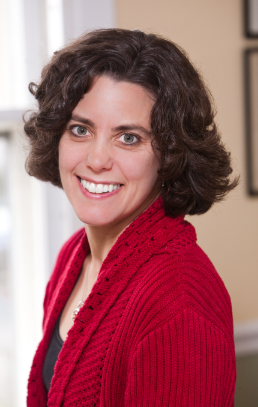 Chuck Sambuchino who writes the Guide to Literary Agents Blog from Writer’s Digest had another good post and is sponsoring a book give-a-way of Kathy Leonard Czepiel, author of A VIOLET SEASON
Chuck Sambuchino who writes the Guide to Literary Agents Blog from Writer’s Digest had another good post and is sponsoring a book give-a-way of Kathy Leonard Czepiel, author of A VIOLET SEASON
(Simon & Schuster), named one of the best books of 2012 by Kirkus Reviews.
She is the recipient of a 2012 creative writing fellowship from the National Endowment for the Arts, and her short fiction has appeared in Cimarron Review, Indiana Review, CALYX, Confrontation, Brain Child, and elsewhere.
Czepiel teaches writing at Quinnipiac University in Connecticut, where she lives with her husband and two daughters. Learn more about Czepiel
and her work at her website.
As an added bonus, Chuck posted five of Kathy’s tips on writing the first draft of your novel. So read and learn, then visit Chuck to leave a comment and maybe win a copy of Kathy Leonard Czepiel’s award winning YA Fantasy Novel.
1. Make an outline. Then be willing to leave it behind. Writing an outline forces me to think through some big questions before I begin. But I follow it the way I travel with my husband sans kids: “Hey, Honey, look at this weird little mountain on the map. Wanna check it out?” And pretty soon the story has taken a turn. Sometimes the side trip changes everything, and I revise my outline. Sometimes it’s a dead end. Then I have my outline to get me back on track.
(Learn how to start your novel.)
2. Think of your first draft as the clay, not the sculpture. Imagine that what you are doing is digging up clay, just a hunk of stuff from which you’ll create something later. Much of it will be messy and unrefined, but that’s not your problem now. Your job is simply to get from the beginning to the end. Keep digging! When it’s time to write a second draft, you will have your raw material.
3. Every time you think about how pedestrian and clumsy and downright awful your first draft is, remind yourself that no one else has to read it. I don’t show my first draft to anyone. I already know it needs a lot more work, and I even know what some of that work will be, so asking someone else to read it would be pointless (and embarrassing). If you don’t know what your first draft needs, then by all means, ask for help. But if you decide not to show it to anyone, it may be best not to tell anyone about it either. Otherwise, your well-meaning friends will keep asking you how it’s going, and you will have to distract them with beer or chocolate or witty conversation on another topic (my personal favorite).
4. Don’t let a lack of research slow you down. I write historical fiction, so I do a lot of research, but I only do a little bit to get started. When I began drafting my debut novel, A Violet Season, I needed to know that violets were grown in the Hudson Valley beginning in the early 1890s, and that wet nurses had become somewhat obsolete by the turn of the century, when infant formula was invented. As for the details—how to pick violets, how much wet nurses were paid—in my first draft, I made them up! If I’d been concerned about research too soon, all those trips to the library (and the violet farm, and the Lower East Side of New York City, and so on) might have prevented me from ever finishing that first draft. Instead, I use CAPS in my first drafts to indicate where details need to be filled in later.
(Read author interviews with debut novelists.)
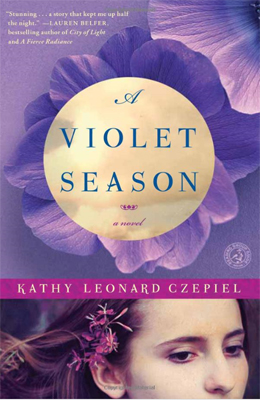 5. Set a deadline. A Violet Season was written over four summers—each summer, another draft. This was a crazy schedule, I know, but in some ways it was perfect. There was a clear end to the summers (sadly), and to my drafts. If you don’t have a deadline, you run the risk of one draft spilling into the next, and you may never feel a sense of closure or accomplishment. This is really important in a business in which we often work alone and without recognition. When you finish your draft, celebrate! Then start the next one.
5. Set a deadline. A Violet Season was written over four summers—each summer, another draft. This was a crazy schedule, I know, but in some ways it was perfect. There was a clear end to the summers (sadly), and to my drafts. If you don’t have a deadline, you run the risk of one draft spilling into the next, and you may never feel a sense of closure or accomplishment. This is really important in a business in which we often work alone and without recognition. When you finish your draft, celebrate! Then start the next one.
GIVEAWAY: Kathy is excited to give away a free copy of her novel to a random commenter. Comment within 2 weeks; winners must live in Canada/US to receive the book by mail. You can win a blog contest even if you’ve won before. (Please note that comments may take a little while to appear; this is normal).
Deadline for leaving a comment ends on March 20th, so don’t delay.
Talk tomorrow,
Kathy
Filed under:
Advice,
authors and illustrators,
demystify,
How to,
Writing Tips Tagged:
A VIOLET SEASON,
Chuck Sambuchino,
First Draft Tips,
Kathy Leonard Czepiel,
Writer's Digest 

Every book sold on the market needs an ISBN Number and a bar code, so if you are planning to self-publish a book, you will need both of these things, too. Retailers use these numbers to track and catalog your books, and to report your sales.
I am not saying you should run out and purchase these right now, because it will depend on the choices you decide to make. You may decide to accept a package from a company that includes these numbers. You could run into an editor who wants to buy your book and that would change everything.
That being said you should realize what they do for you and your options.

ISBNs are sold like any other commodity by Bowker www.bowker.org and a few authorized re-sellers. And to accommodate the needs of these self-publishers, they made individual numbers available for the first time.
In addition, Bowker is actually registering your publishing company when they issue you your numbers, not your individual books. This is a key step for many self-publishers and that’s a pretty good reason to get an ISBN as well.
Bowker sells most of the ISBN numbers and discounts according to the amount purchased. The cost of buying just one is $125, so it is better to buy a block of numbers, because you will need more than one anyway. Most publishers these days are going to publish at least five (5) versions of a book (Hardback, Softback, EPUB, MOBI, and PDF), each of which requires an ISBN.
Smashwords will tell you that retailers such as Apple and Sony will not accept your Smashwords book unless you have a unique e-ISBN and everything on Smashwords is an e-book, but there isn’t a special e-ISBN, just plain old ISBNs.
Owning a block of 10 ISBNs is usually enough for two different books. Those who purchase blocks of 10 ISBNs are usually self-publishers who have researched their needs before making a purchase and realize this is the most cost effective purchase for their needs. The price of 10 ISBNs is $250.
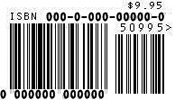 The Bookland EAN Barcode is an essential component of booksellers handling of the book. You must provide a retail price for your barcode. Cost $25
The Bookland EAN Barcode is an essential component of booksellers handling of the book. You must provide a retail price for your barcode. Cost $25
The largest book retailers, as well as many book wholesalers, require books to display the Bookland EAN barcode graphic symbol which carries the ISBN. At the point of sale in a bookstore, the ISBN is scanned and all related information about the title is accessed in their sales system — identifying the price correctly and subtracting a copy from their inventory etc.
In the US, the first digit of the add-on data indicates which currency the price is expressed in — so for US dollars, the designated digit is a 5. So an add-on of 51995 indicates a price of US$ 19.95. The largest US retailers such as Barnes and Noble now require the use of EAN-5 barcode on books they handle. Scanners in American bookstores cannot read the Bookland EAN code without the corresponding 5-digit add-on. Publishers who don’t comply with this requirement may be penalized.
Please remember what I said last week, writer’s who want to self-publish need to do there homework and try to hold back their enthusium in order to make the right choices, so please check back for my weekly post or start researching on your own if you can’t wait. Just make sure you do your homework before you jump in with both feet. Click here to read 1st Self-Publishing post
Talk tomorrow,
Kathy
Filed under:
Advice,
authors and illustrators,
How to,
Process,
Self-publishing Tagged:
Bookland EAN code,
Bowker,
ISBN Numbers,
Self-Publishing 

View Next 25 Posts





 We’ve been talking a lot about how to format your manuscript, so I bought The First Five Pages: A Writers Guide To Staying Out of the Rejection Pile by Noah Lukeman to see what other things might be good to share and already he has reminded me of things I forgot to mention to you that you should do before submitting.
We’ve been talking a lot about how to format your manuscript, so I bought The First Five Pages: A Writers Guide To Staying Out of the Rejection Pile by Noah Lukeman to see what other things might be good to share and already he has reminded me of things I forgot to mention to you that you should do before submitting. 



 Mark was born and raised in Northern Utah under the shadow of the Wasatch Mountains. He spent many childhood days climbing, exploring, and causing general mayhem on the mountainside. Running around with his brothers he learned early on the finer things in life like the sound of breaking glass, the freedom of running around in your underwear, and the feel of rushing wind on your face as you’re falling out of a tree.
Mark was born and raised in Northern Utah under the shadow of the Wasatch Mountains. He spent many childhood days climbing, exploring, and causing general mayhem on the mountainside. Running around with his brothers he learned early on the finer things in life like the sound of breaking glass, the freedom of running around in your underwear, and the feel of rushing wind on your face as you’re falling out of a tree. 





















































 37. Any words of wisdom on how to become a successful writer or illustrator?
37. Any words of wisdom on how to become a successful writer or illustrator?



 Kristin Varner grew up in Salt Lake City, Utah and graduated with a BFA in Illustration from Rhode Island School of Design in 1995. Kristin has been operating as KBoom, an illustration and design studio since 1998. Some of her picture books for children include ‘Big Feelings’ and ‘Aladdin – A Tale from the Middle East’. Kristin has lived in Seattle, New York City and just recently moved to Berlin, Germany. To see more of her work, please visit her website at
Kristin Varner grew up in Salt Lake City, Utah and graduated with a BFA in Illustration from Rhode Island School of Design in 1995. Kristin has been operating as KBoom, an illustration and design studio since 1998. Some of her picture books for children include ‘Big Feelings’ and ‘Aladdin – A Tale from the Middle East’. Kristin has lived in Seattle, New York City and just recently moved to Berlin, Germany. To see more of her work, please visit her website at 





 Final sketch that was initially drawn by hand, and then scanned and manipulated within Photoshop.
Final sketch that was initially drawn by hand, and then scanned and manipulated within Photoshop. When I’m painting with Acrylics rather than working digitally, I have an extra step to get my sketch transferred onto my paper. I stretch a medium weight, hot press watercolor paper and then coat it with a layer of gesso to create a nice textured surface to paint on. If I have the time I will transfer the sketch myself using carbon paper. If it’s a book job and I have several paintings to kick out, I choose a paper that is thin enough to be run through an oversized commercial printer and I print my sketches out at the local copy shop, which saves me a ton time.
When I’m painting with Acrylics rather than working digitally, I have an extra step to get my sketch transferred onto my paper. I stretch a medium weight, hot press watercolor paper and then coat it with a layer of gesso to create a nice textured surface to paint on. If I have the time I will transfer the sketch myself using carbon paper. If it’s a book job and I have several paintings to kick out, I choose a paper that is thin enough to be run through an oversized commercial printer and I print my sketches out at the local copy shop, which saves me a ton time. I flood the image with a wash of my favorite color…..cadmium red.
I flood the image with a wash of my favorite color…..cadmium red.












































 In fourth grade, Kristi often got in trouble for drawing too much during class.
In fourth grade, Kristi often got in trouble for drawing too much during class.
 I think she looks excited. Here is Kristi Showing her process.
I think she looks excited. Here is Kristi Showing her process.

 Blocking in the color.
Blocking in the color.







































 In June 2012, at the New Jersey SCBWI conference in Princeton, NJ, I had Lionel Bender, cofounder of the U.K. packager Bender Richardson White, and author Sally Isaacs do an intensive workshop on writing. It was there that Lionel approached Isaacs with putting on a Non-fiction conference focused on opportunities for writers in children’s nonfiction publishing.
In June 2012, at the New Jersey SCBWI conference in Princeton, NJ, I had Lionel Bender, cofounder of the U.K. packager Bender Richardson White, and author Sally Isaacs do an intensive workshop on writing. It was there that Lionel approached Isaacs with putting on a Non-fiction conference focused on opportunities for writers in children’s nonfiction publishing. Jonathan Sprout attended and said, “I had a great time. There were, I’m guessing, about a hundred participants, so we all got to know each other in various degrees. Many of the paid participants are successful already-established writers. I made many new friends, including several people who have each written over a hundred books. Faculty and paid attendees mingled often throughout the weekend.
Jonathan Sprout attended and said, “I had a great time. There were, I’m guessing, about a hundred participants, so we all got to know each other in various degrees. Many of the paid participants are successful already-established writers. I made many new friends, including several people who have each written over a hundred books. Faculty and paid attendees mingled often throughout the weekend. Alyssa Mito Pusey, senior editor at Charlesbridge said, “Nonfiction has always been our core, but as far as our digital strategy the goal is to put its books onto as many platforms as possible. Intellectual property will become king as publishers seek to engage their audience through transmedia storytelling. Print will become a single star in this constellation. Digital is fun, but print is not dead.”
Alyssa Mito Pusey, senior editor at Charlesbridge said, “Nonfiction has always been our core, but as far as our digital strategy the goal is to put its books onto as many platforms as possible. Intellectual property will become king as publishers seek to engage their audience through transmedia storytelling. Print will become a single star in this constellation. Digital is fun, but print is not dead.”
 Jason’s name might sound familiar, since I showed off his winning illustration from the NJSCBWI June Conference the other week. If you read Jason resume above, you will see how successful he has been in his career already. I am sure it is exciting to work around other creative people like he does on the David Letterman Show, but Jason is expanding into the children’s book market and I am sure he will be just as successful with that endeavor. Below you will see Jason’s process, but we start with his answers to my question about how he paints and what materials he uses. Here’s Jason:
Jason’s name might sound familiar, since I showed off his winning illustration from the NJSCBWI June Conference the other week. If you read Jason resume above, you will see how successful he has been in his career already. I am sure it is exciting to work around other creative people like he does on the David Letterman Show, but Jason is expanding into the children’s book market and I am sure he will be just as successful with that endeavor. Below you will see Jason’s process, but we start with his answers to my question about how he paints and what materials he uses. Here’s Jason:






























 Andrea Offermann was born in Cologne, Germany, and grew up in the countryside close to the city, in an old horse stable converted to a house, surrounded by a wild garden. During a visit to the US she fell in love with Art Center College of Design and eventually moved to California to study at the school. She graduated in 2005 with a BFA in Illustration, and stayed for another year to work as an illustrator and fine artist.
Andrea Offermann was born in Cologne, Germany, and grew up in the countryside close to the city, in an old horse stable converted to a house, surrounded by a wild garden. During a visit to the US she fell in love with Art Center College of Design and eventually moved to California to study at the school. She graduated in 2005 with a BFA in Illustration, and stayed for another year to work as an illustrator and fine artist.









































 So you have a written and successfully gotten a publisher to offer you a contract. Now is the time to start thinking of how you plan to market your book. One of the first things that comes to mind are school visits, but you could use some help in figuring out how to maneuver that whole avenue. Well, I am going to point you to a great site – School Visits Experts. Once you visit them I am sure you will agree they share great information on there site. It was founded by Alexis O’Neill. You may already know Alexis, since she has been the SCBWI Regional Advisor in California for the last 18 years and has helped so many children’s writers and illustrators. I know everyone who reads the SCBWI Bulletin and everyone on the West Coast knows Alexis, but for those who live in other places, have a stack of SCBWI Bulletins waiting to be read, or haven’t read one of her books, this might be your first encounter with Alexis.
So you have a written and successfully gotten a publisher to offer you a contract. Now is the time to start thinking of how you plan to market your book. One of the first things that comes to mind are school visits, but you could use some help in figuring out how to maneuver that whole avenue. Well, I am going to point you to a great site – School Visits Experts. Once you visit them I am sure you will agree they share great information on there site. It was founded by Alexis O’Neill. You may already know Alexis, since she has been the SCBWI Regional Advisor in California for the last 18 years and has helped so many children’s writers and illustrators. I know everyone who reads the SCBWI Bulletin and everyone on the West Coast knows Alexis, but for those who live in other places, have a stack of SCBWI Bulletins waiting to be read, or haven’t read one of her books, this might be your first encounter with Alexis.

 Here is Tracy explaining her process:
Here is Tracy explaining her process:

 Drybrush Tips:
Drybrush Tips:





 Once the idea takes shape, I redraw each figure, scan it, and then enlarge or reduce each element until I’m happy with the placement. I then transfer the final drawing onto Strathmore WindpowerTM smooth finish, acid free Bristol.
Once the idea takes shape, I redraw each figure, scan it, and then enlarge or reduce each element until I’m happy with the placement. I then transfer the final drawing onto Strathmore WindpowerTM smooth finish, acid free Bristol.






 My confidence soared. I queried a well-known calendar company in Markham, Ontario. Rejected, I sulked, unaware God was still at work. A few months later, I received a call. My name had been passed on to Zebra Publishing. They hired me to design a “baby’s first year keepsake” calendar, and the following year, a “twelve-month folk art” calendar. Both calendars sold like hot cakes in mom-and-pop bookstores, Chapter’s bookstores in Canada, and Barnes & Noble in the U.S.
My confidence soared. I queried a well-known calendar company in Markham, Ontario. Rejected, I sulked, unaware God was still at work. A few months later, I received a call. My name had been passed on to Zebra Publishing. They hired me to design a “baby’s first year keepsake” calendar, and the following year, a “twelve-month folk art” calendar. Both calendars sold like hot cakes in mom-and-pop bookstores, Chapter’s bookstores in Canada, and Barnes & Noble in the U.S.


 Have you ever illustrated something for a children’s magazine?
Have you ever illustrated something for a children’s magazine?









 Have you gotten any work through networking?
Have you gotten any work through networking? Are you open to doing illustrations for self-published picture book authors?
Are you open to doing illustrations for self-published picture book authors?

 What are you working on now?
What are you working on now?













































 This is by no means the only things you can use to format and convert your manuscript to an e-book, it is just to give you an idea of the some of the things out in the market you can use. The Kindle, the Nook and the iTunes Bookstore (which services both the
This is by no means the only things you can use to format and convert your manuscript to an e-book, it is just to give you an idea of the some of the things out in the market you can use. The Kindle, the Nook and the iTunes Bookstore (which services both the  Ask anyone who’s been in a writers critique group, and you will hear that there is no better way to hone your craft. Ideally, a critique group gets you where you want to go as a children’s writer. But what if you can’t find a group to go to?
Ask anyone who’s been in a writers critique group, and you will hear that there is no better way to hone your craft. Ideally, a critique group gets you where you want to go as a children’s writer. But what if you can’t find a group to go to? Submitted by
Submitted by
 5. Set a deadline.
5. Set a deadline. 
 The Bookland EAN Barcode is an essential component of booksellers handling of the book. You must provide a retail price for your barcode. Cost $25
The Bookland EAN Barcode is an essential component of booksellers handling of the book. You must provide a retail price for your barcode. Cost $25
This is a great post on writing synopsis…something we all need to learn to do well. Thanks Kathy!
This is great and one to be saved. Thanks, Kathy!
Adorable lion and the lamb. And Kathy, thanks for the synopsis tips. :-)